Pittwater Summer Houses: Cooinoo Bungan Beach
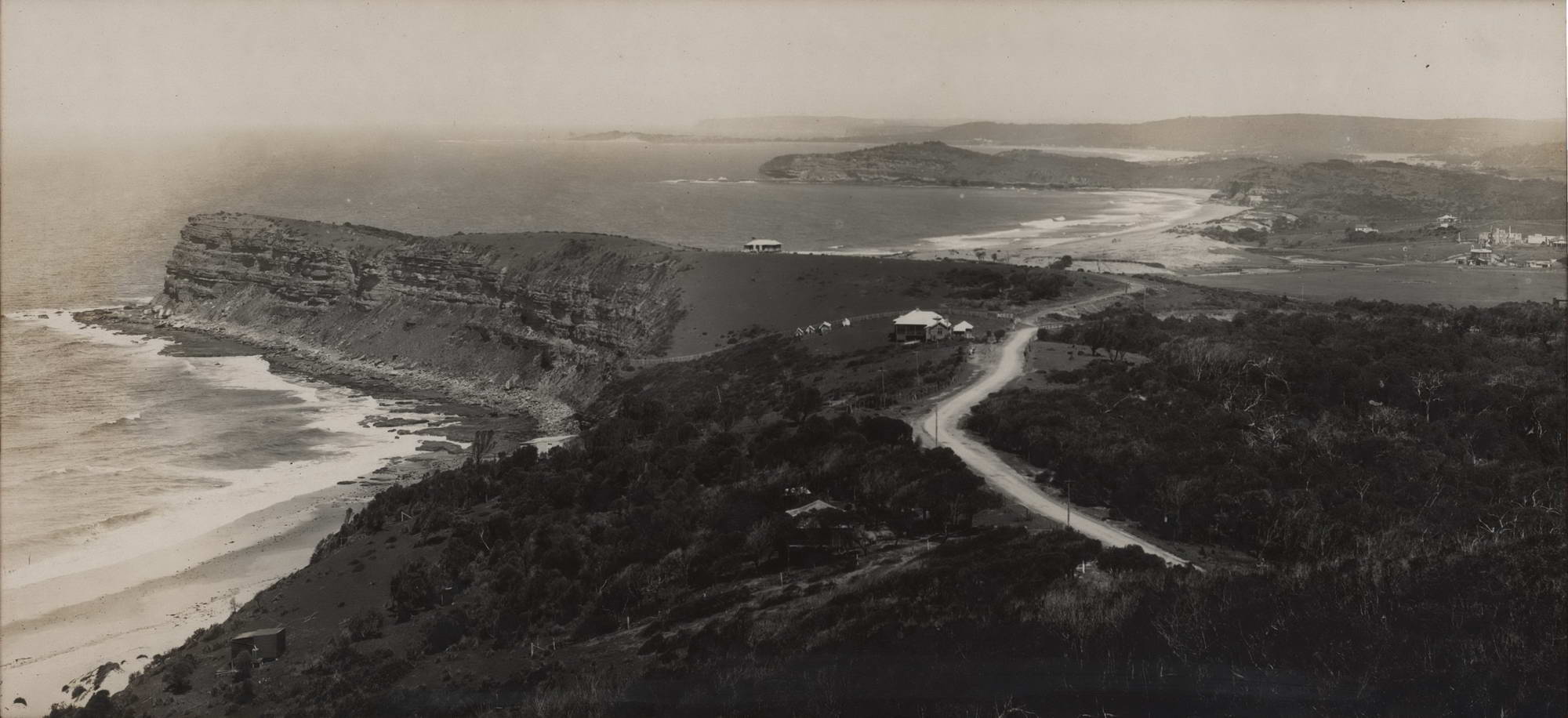
View From Bushranger’s Pt Near Newport Hill [NSW] c1920s. Vintage silver gelatin photograph, typed title on accompanying slip, Shows Bungan and Mona Vale Beaches. By NSW Government Printer (Aust., commenced 1842). Item #CL174-113 - Price (AUD): $1,250.00 - from Josef Lebovic Gallery - 'Cooinoo' is the house mid picture with 4 tents in its' backyard - to the far right of frame can be seen Brock's 'The Oaks' Mansion in its first version and prior to the fire of January 8th 1912 which gutted the main structure.
The Summer cottage or holiday house was one of main reasons the paddocks and pristine bush covered hills running down to the estuary and beaches began to have the small lighter dots of constructions appearing on them – and this happened way before many of the local subdivisions took place. Some were little more than sheds, others could even have this and camped on their block of land, but they were all about getting away from the humid built-up areas further inland around Sydney for a breath of fresh cool salty air and having some relaxation.
These weekend year round visitors and their guests introduced the commerce of construction for local residents and supplemented what was then a fishing and farming existence, generating the need for new skills and knowledge, and bringing, during Summer, thousands more people to Pittwater with the subsequent need for feeding them providing income for local Butchers, Bakers and Water Carriers and entertaining them growing other industries – Caretakers, Gardeners.
One such Summer House was ''Cooinoo'' on Bungan Beach-Mona Vale verge.
In 1906 Francis Mephan Gellatly, Journalist, of Sydney, purchased Lot No. 33, Section 3 from the Mona Vale Land Company, consisting of 2 acres and 34 perches [Vol 1739- Fol 16 No. of Instrument: 3340762].
Mr. Gellatly is one of two Journalists associated with Bungan Beachs' earliest years, the other being Alfred Yewen a Journalist with the Sydney Morning Herald for just over two decades towards the end of his career, who started with socialist principles and is known locally as being the builder of Bungania. He wrote Yewen's Directory of the Landholders of New South Wales (here) the first attempt to list all landholders and what they produced in 1900, along with other publications.
W. M. Hughes, one of his earlier acquaintances, wrote of him:
'I lived to see him sleek and opulent, arrayed in the favourite livery of capitalism—bell-topper and frock-coat and stiff collar'.
An long-term association with this future Prime Minister is something Mr. Yewen and Mr. Gellatly shared. Dr. Gellatly is most well-known for being the original Director of the Institute of Science and Industry at the behest of Mr. Hughes, the precursor of today's CSIRO. Prior to that he was the Financial Editor for the Sydney Morning Herald for well over a decade. His association with our area dates from 1891. More on Francis Mephan Gellatly under extras.
Alfred Yewen's purchase of land at Bungan dates from the same time - they possibly came out together to the land sales in December 1906:
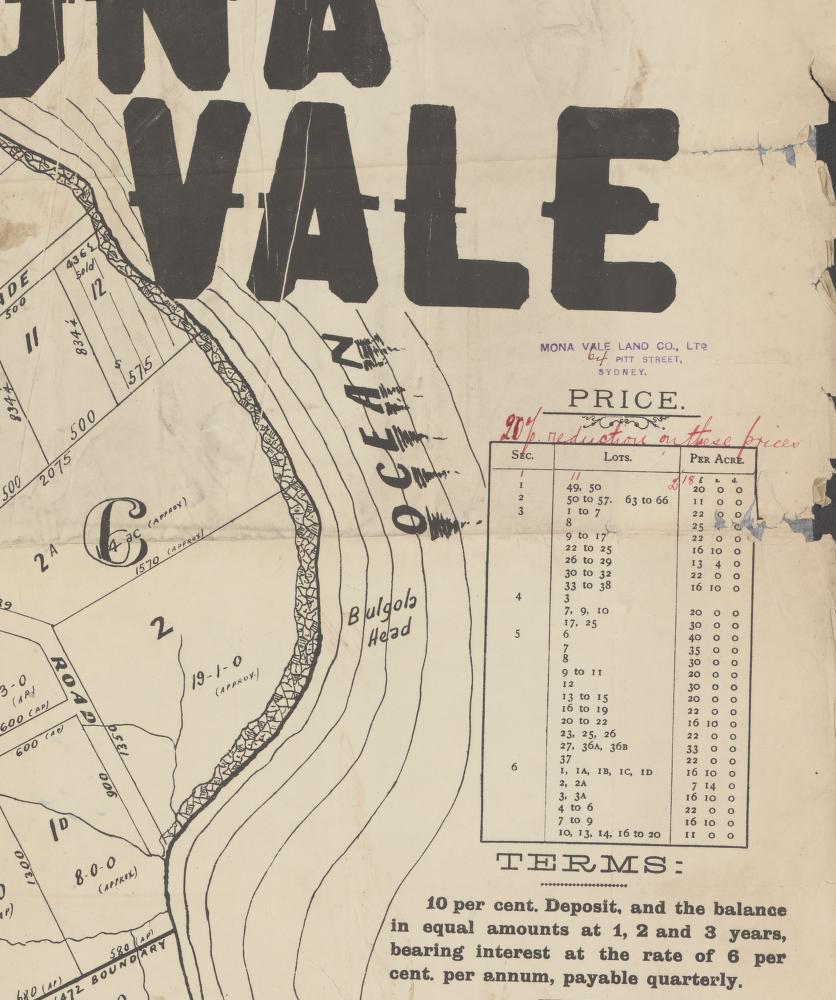
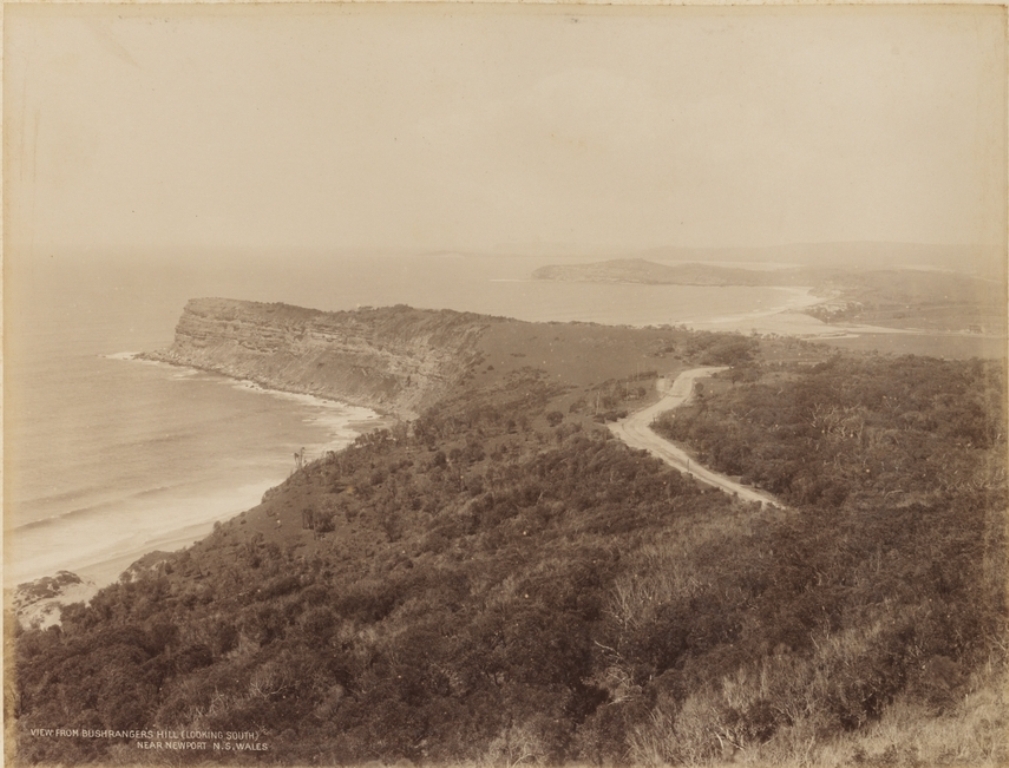
"View from Bushrangers Hill (looking South) Near Newport" Image No.: a924065h, New South Wales, 1879 - ca. 1892. N.S.W. Government Printer, Bushrangers Hill, Newport, NSW. Courtesy State Library of NSW.
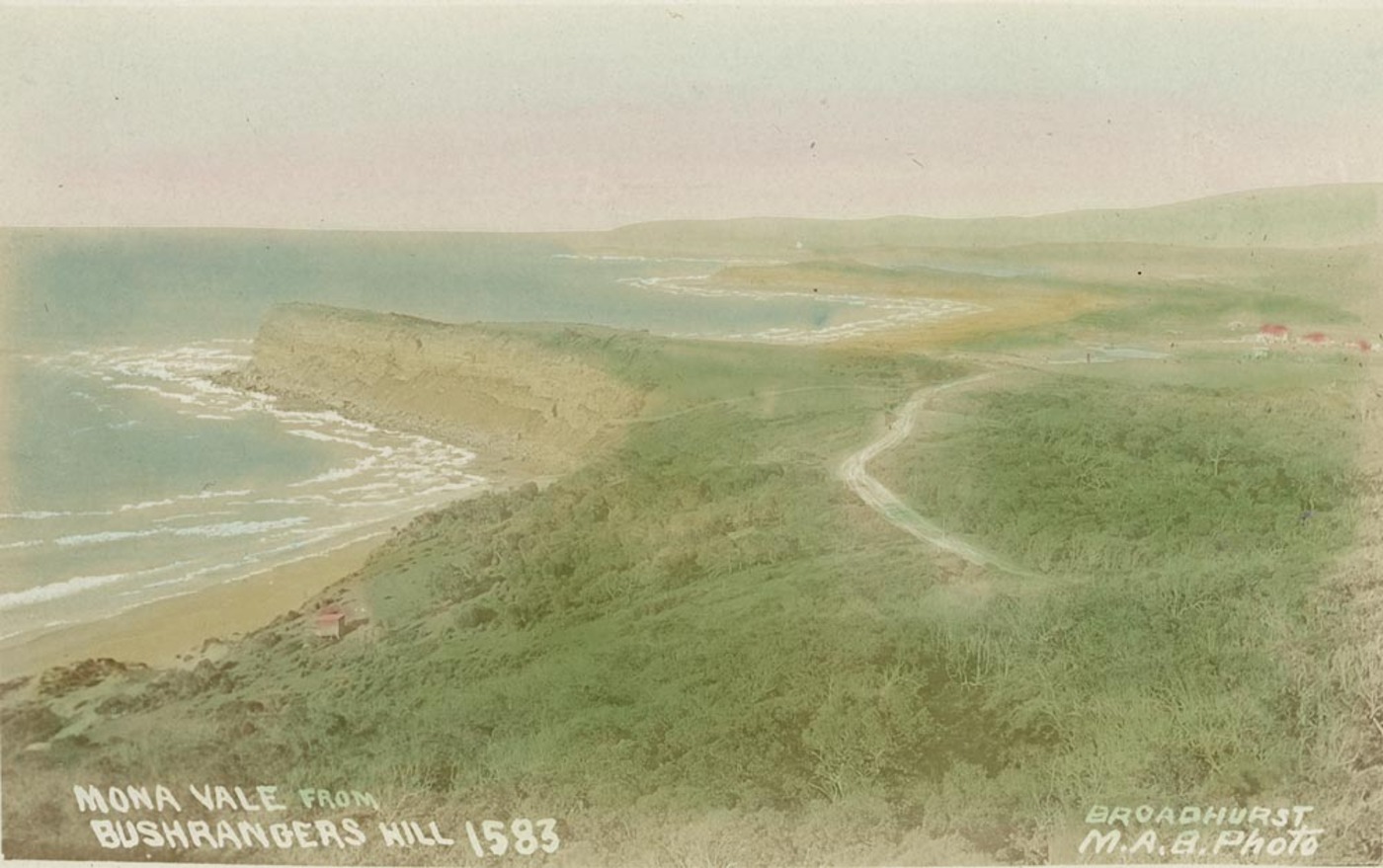
Bungan from Bushrangers Hill - Item a106013h, circa 1905-1923 Broadhurst Post Card Publishers Scenes of Newport Album, courtesy the State Library of New South Wales.
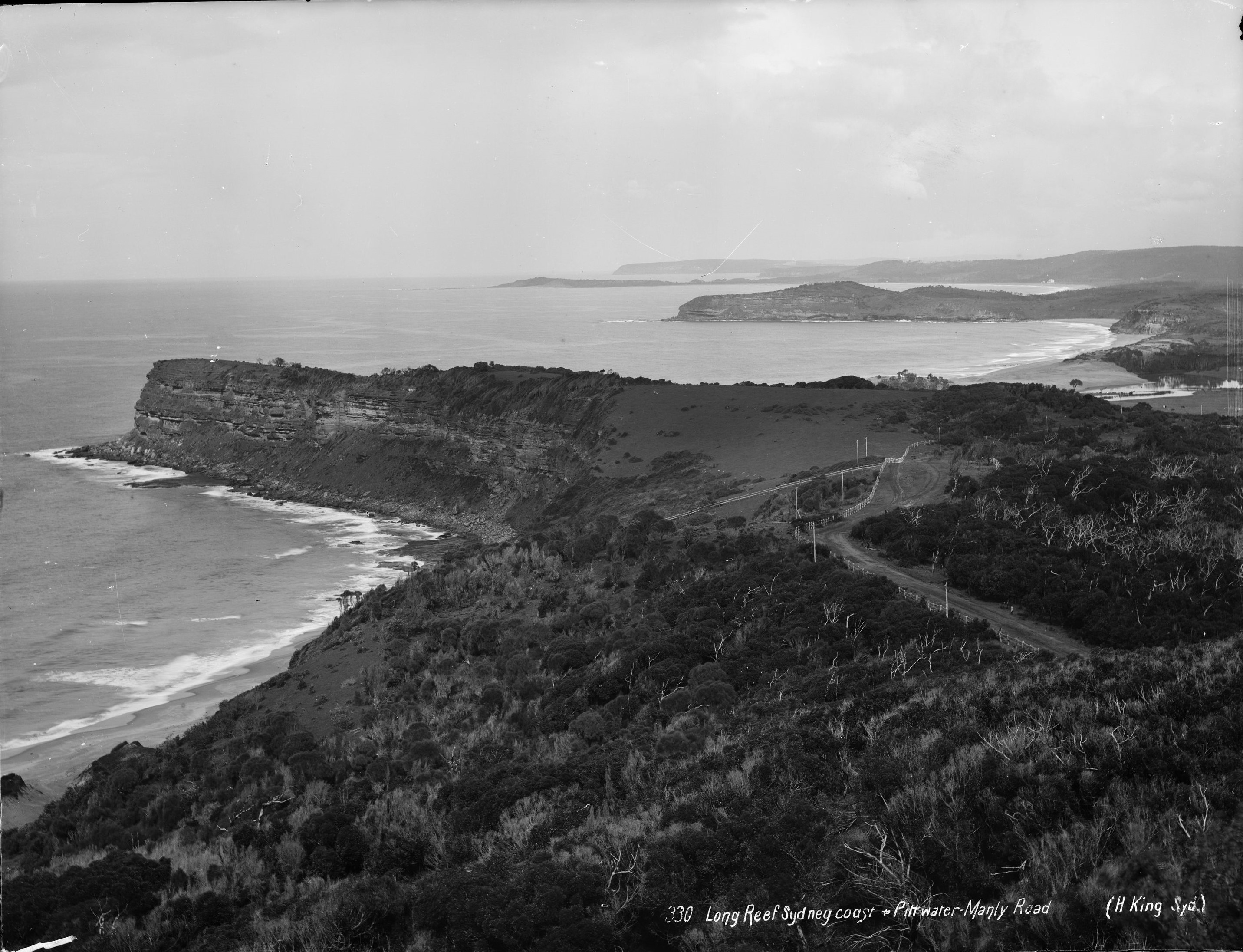
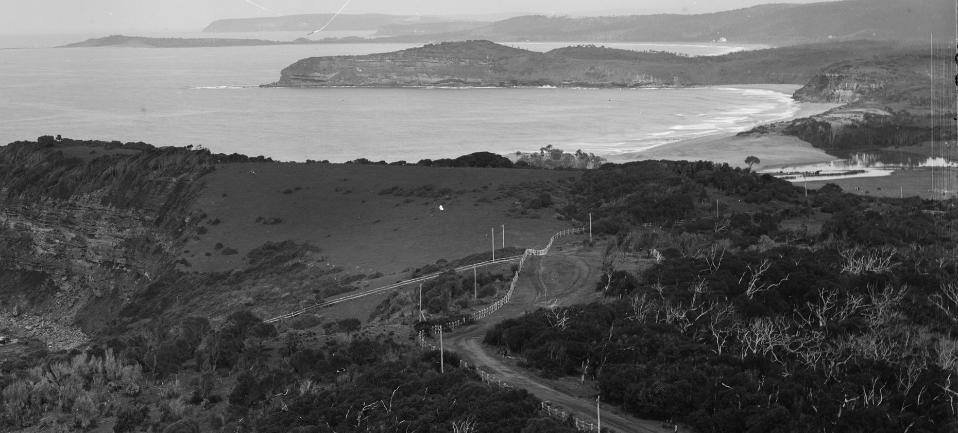
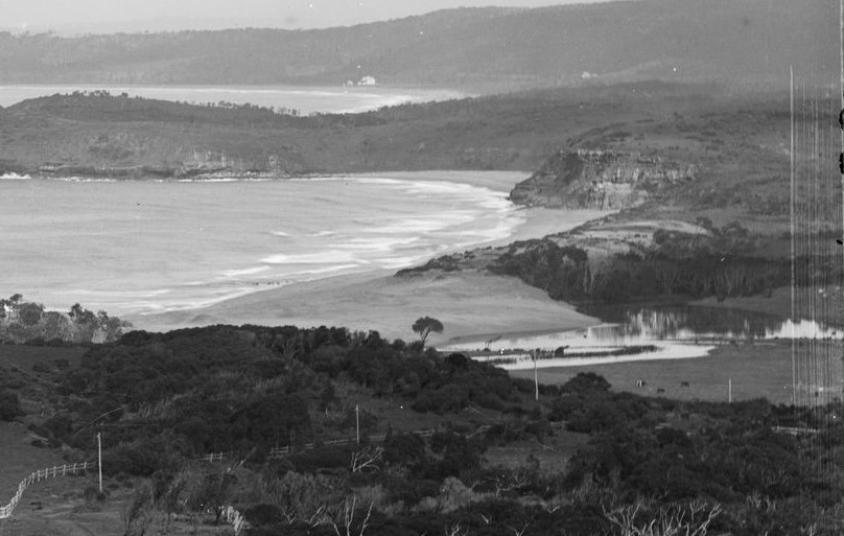
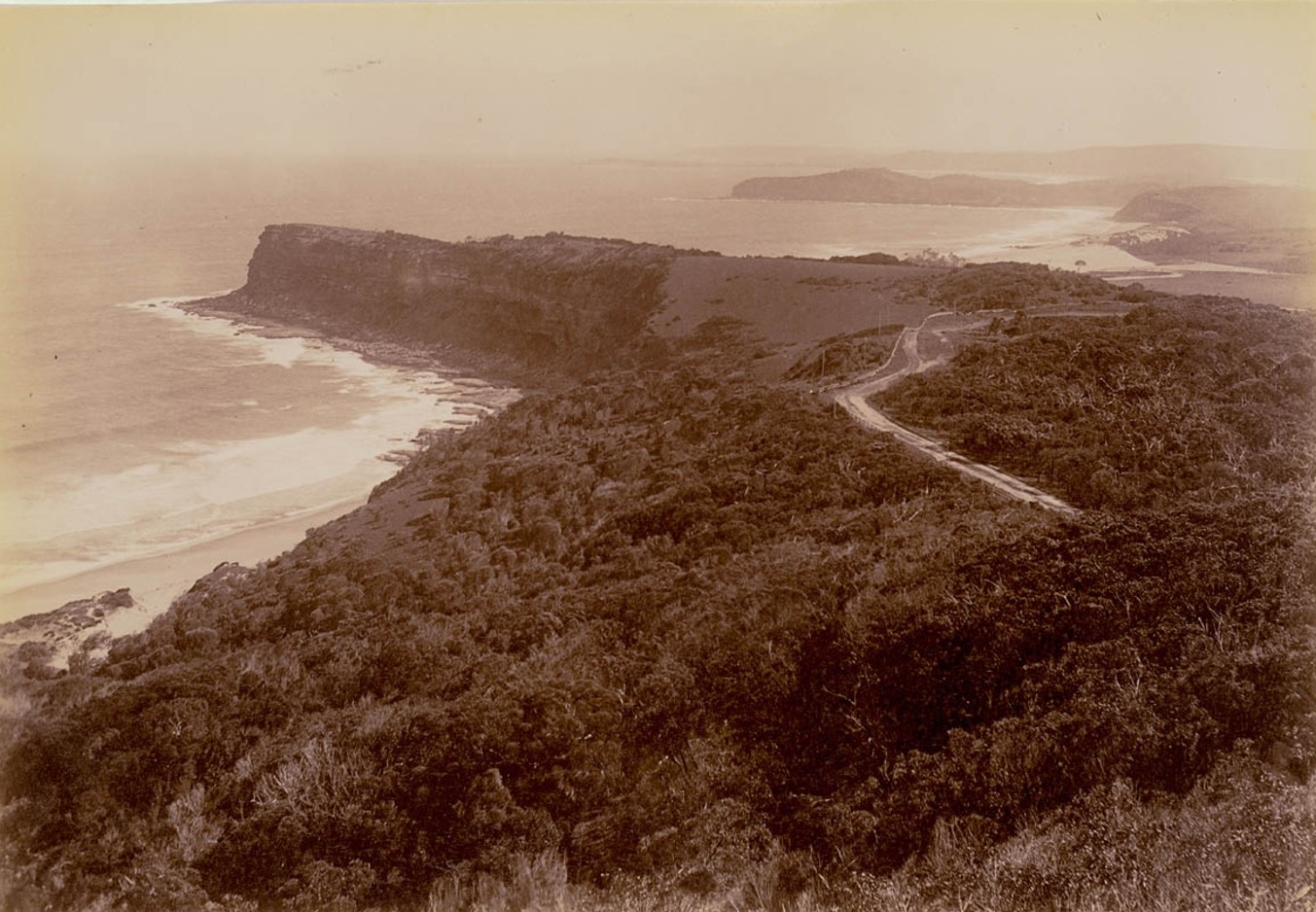
OCEAN FRONTAGE BLOCK, WITH SANDY BEACH.
~ PITTWATER, MONA VALE, adjoining Brock's Estate, and on the main road.
LOT 33, SECTION 3, MONA VALE ESTATE,
2 ACRES 0 RD. 34 PERS.
About 204 FEET to MAIN PITTWATER ROAD, by depths of about 377 FEET on one side, and about 353 FEET on the other side, with delightful sandy
Beach frontage. Torrens Title.
For Sale in 1 Line or 4 Lots.
Plan on view at the Sale Rooms.
HARDIE and GORMAN have received instructions to sell the above by public auction, at their rooms, 138 Pitt-street, at 11.30 o'clock on
NEXT WEDNESDAY, 12th APRIL,. 1911.
Messrs. Dobbin and Spier. 350 George-street,
Vendor's Solicitors. Advertising (1911, April 8). The Sydney Morning Herald (NSW : 1842 - 1954), p. 23. Retrieved from http://nla.gov.au/nla.news-article15246399
Francis transferred the title to William John Adams of Sydney, gentleman, on December 15th, 1911. Both were founding members of the Athenaeum Club, so the sale may have transpired through private conversations. The Athenaeum Club is a private club situated in Melbourne, Australia. The club has been in operation since 1868.
William John Adams may have listed his occupation as 'gentleman' by 1911, but he was a lot more than that. The William John Adams story dates back to 1884 when he began a trading business marketing famous brands of railway equipment in the booming Melbourne economy. On December 12th 1884 the Victorian Government's Act No. 821, Railway Construction Act 1884, was passed. This authorised fifty-nine new lines to almost every corner of the colony, and became known as the Octopus Act.
Mr. Adams was born in Limehouse, son of William and Isabella Adams, he founded the Australasian firm of Messrs. William Adams and Company, Ltd., of which he was chairman of directors until his second son 'Barton' worked in that role.
He was born at Limehouse in 1853 in the neighbourhood of the West India Docks where his grandfather, John Samuel Adams, was engineer, and he was a cousin of the late Professor Henry Adams. Mr. Adams was the son of William Adams, M.I.Mech.E., who was locomotive superintendent to the North London, Great Eastern, and London and South Western Railways successively. He became a pupil of his father at the locomotive works of the North London Railway at Bow and after five years' training he joined Messrs. Tannett, Walker and Company, of Leeds, as a draughtsman. A year later, in 1877, he was made erecting engineer, and superintended the installation of hydraulic machinery. In 1879 he entered into partnership with his friend Mr. Percival Everitt and founded the firm of Everitt, Adams and Company, Ryburgh Works, Norfolk, inventors of the penny-in-the-slot machine. After dissolving the partnership in 1880, Mr. Adams became manager of the Vacuum Brake Company, Ltd.
In 1883 he married Alice Emily Slater, the marriage registered at Wandsworth during the April-May-June lists. Wandsworth is a borough in southwest London and part of Inner London. They left for Australia with agencies for several British engineering firms, and on his arrival he established the firm with which he was associated for the remainder of his life. Founded in 1884, a company was formed to take over the original firm of William Adams & Company, wholesaler and distributor for construction equipment and engineering industries. Incorporated in New South Wales on September 5th 1912 as 'William Adams and Company Limited' they soon became one of Australia's leading distributor's of steel and aluminium, machine tools, power transmission equipment, earthmoving and materials handling equipment, facsimile transceivers and telephone answering equipment. Following a successful bid by Tubemakers of Australia Limited, the company was removed from the Stock Exchange on 7 December 1983.
This was a HUGE Business with branches in all states as well as connections to America and New Zealand.
Both his sons, Dudley and Alfred Barton, became Engineers as well - educated in Sydney initially they were both sent to London to serve apprenticeships with the railways. Alice and William had two daughters as well, Dorothy Mary and Alice Windett, Dorothy being born in 1886 in Sydney:
BIRTHS.
ADAMS.—April 11, 1886, at 143, Macquarie-street, Sydney, the wife of William John Adams, of a daughter. Family Notices (1886, April 17). The Sydney Mail and New South Wales Advertiser (NSW : 1871 - 1912), p. 827. Retrieved from http://nla.gov.au/nla.news-article162817085
The family lived at Whitmore, Wentworth-road, Burwood initially but by the late 1890's the family had a home at Turramurra, their first 'Cooinoo'- in Kissing Point road. This building would later become a boarding house under Jean Murray who, at that time, had already been running the nearby 'Hillview' along the same lines, and was sold in the early 1930's. It has long since been demolished, turned into flats. Mr. Adams seemed to lose interest after Alice died in February 1906 while they were on a visit to New Zealand. Her Death Certificate, registered in New Zealand, gives her age as 55.
In December 1909 the house and its contents, some of them listed as new, are put up for sale, including a magnificent and large billiard table, described in the advertisement as 'valuable billiard table, by HEIRON AND SMITH A Full-sized Table, manufactured in picked fiddle-back Tasmanian Blackwood. Nearly New, and fitted with all the Latest Improvements, together with GASALIEIR, BALLS. CUES, and a Full Complement of Billiard Requisites'.
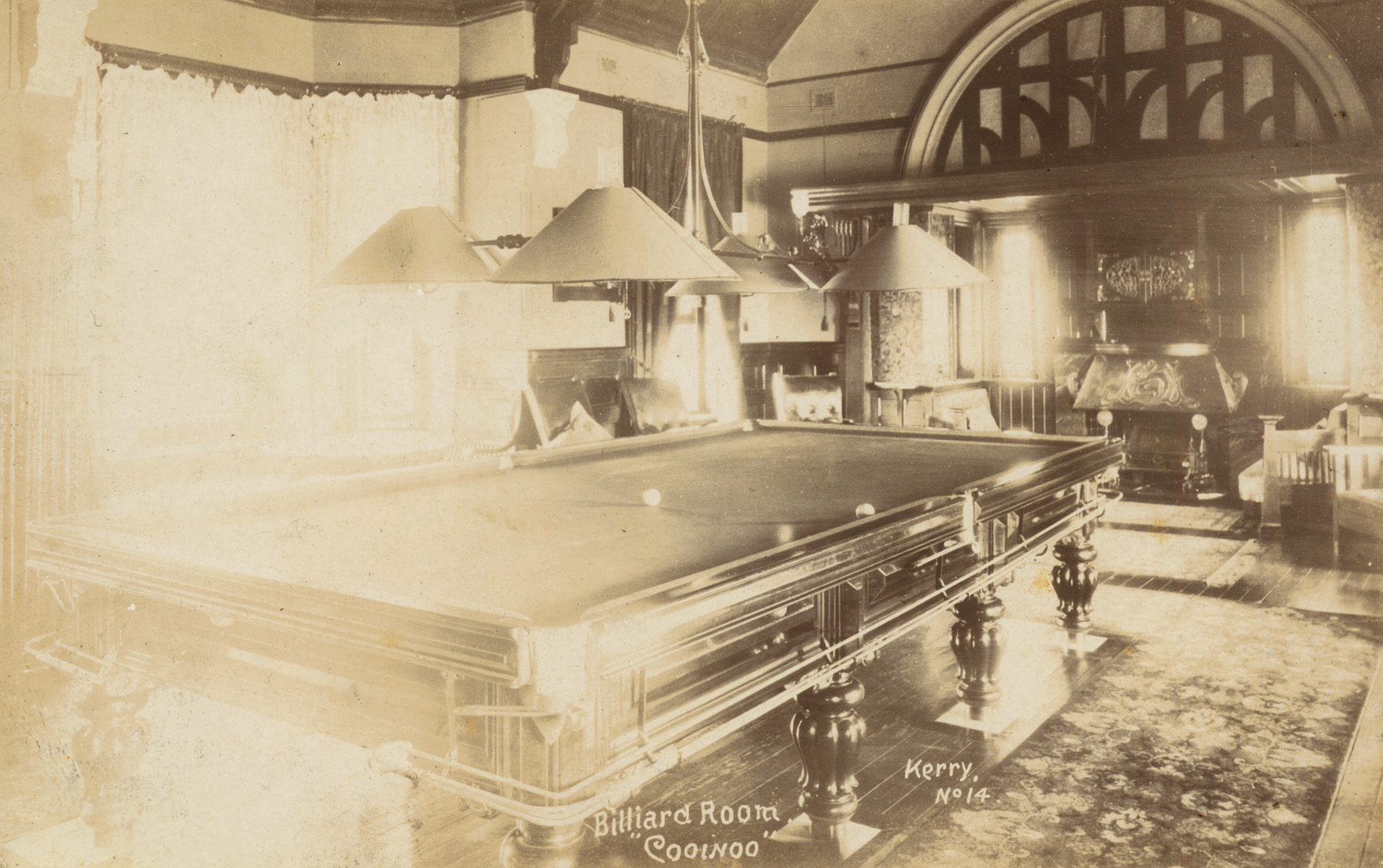
Cooinoo '9' Turramurra Billiard Room - photo by Kerry, circa 1909, from and courtesy Caroline Simpson Library SLM
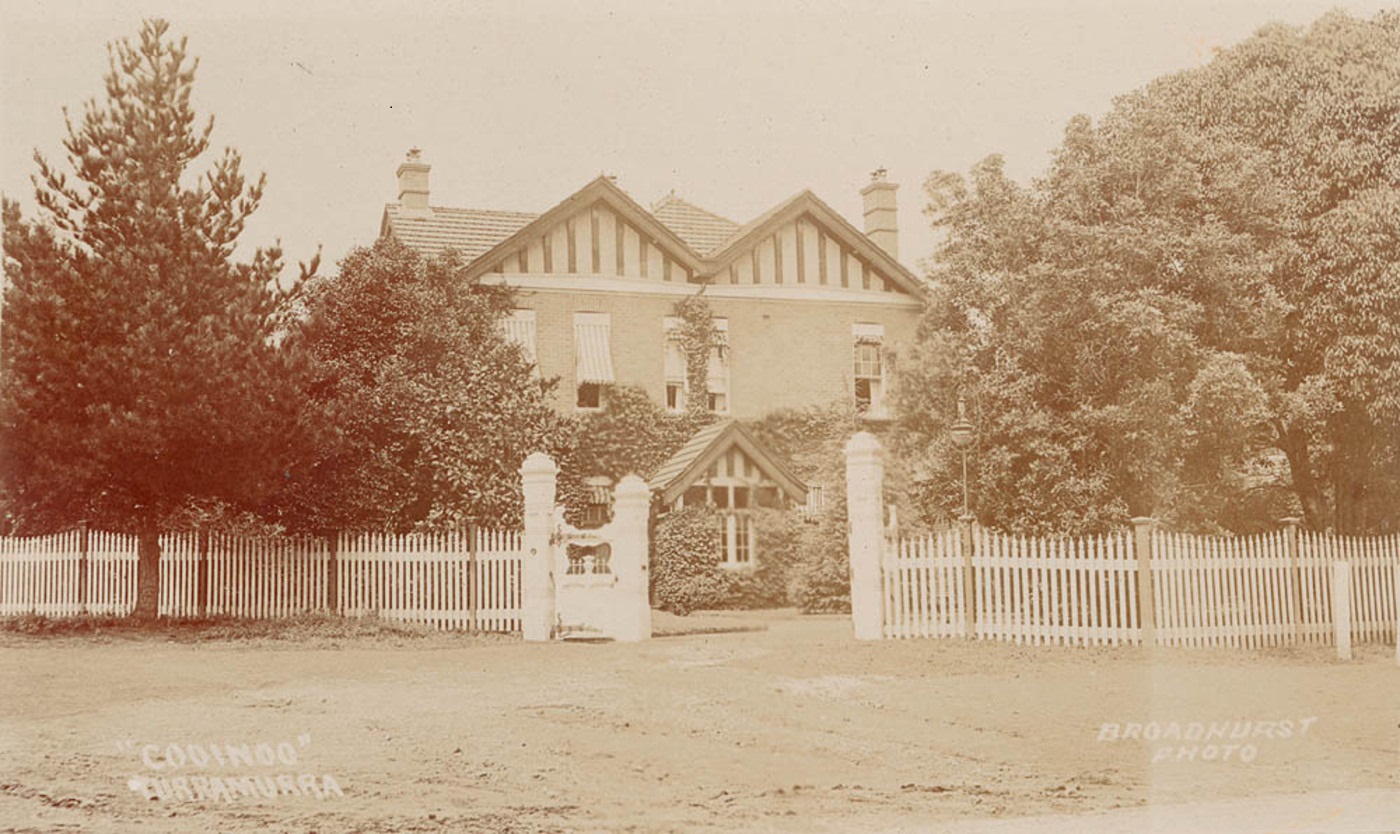
'Cooinoo', Turramurra a106334h - from Scenes of Turramurra Album, ca. 1900-1927, Sydney & Ashfield : Broadhurst Post Card Publishers, courtesy the State Library of New South Wales.
William J Adams and his sons were also early members of Manly Golf Club, with his second son Barton playing with his second wife Clara (nee Cowell) there in 1911. The gentleman who helped with the formation of his company, John Henry Slater, had a daughter who married in Manly in September 1910. The Referee, a sporting newspaper of those times recorded his sons sending messages to the club when both served during World War I, along with one tragic notice. Examples:
Major Barton Adams, No. 1 Squadron, R.F.C., sends greetings to the Manly Club from Flanders. Lieut. Dudley Adams, R.F.A., also sends greetings from Flanders — I hear that there is a chance of his being promoted to captain. GOLF NOTES (1918, January 2). Referee (Sydney, NSW : 1886 - 1939), p. 11. Retrieved from http://nla.gov.au/nla.news-article120317413
GOLF NOTES
More Golfers Fall in Action in France
By AULD REEKIE.
The Manly Golf Club records with deep regret the death, at the front, of Captain Dudley Adams, of the Royal Artillery — killed in action, in France, in March. He was a son of Mr. W. J. Adams, a very esteemed member of the club. He is the eleventh member of the club who has given his life for King and country. His brother, Major Barton Adams, is with the Royal Flying Corps, in France. … GOLF NOTES (1918, April 10). Referee (Sydney, NSW : 1886 - 1939), p. 16. Retrieved from http://nla.gov.au/nla.news-article120313996
It is also worth noting that Major A. Barton Adams had an association with Sir Ross Smith and that William Adams Ltd. were the agents for Vickers-Vimy in Australia during the historic 1919 flight of Sir Ross Smith and his brother and two others from England to Australia. This company provided the plane they flew in. They landed in Sydney on February 14th 1920 but, between when they reached Darwin in December 1919 and then, problems with the aircraft saw Barton heading to Queensland in January 1920 to sort them out at the requuest of Ross.
Prior to Sir Smith and his three fellow fliers heading south to collect the £10,000 cheque from W.M.Hughes as their prize for successfully completing this flight in under 30 days, they were in Sydney for a few days and so he may have been a guest at 'Cooinoo' for some relaxation.
This would be the third Bungan Beach family W. M. Hughes was associated with as friends over a long time - Alfred Yewen, Francis Gellatly, and now the Adams through this historic flight. He too may have been a visitor to Bungan Beach and be among the luminaries who also frequented the little bay and ridge - he certainly spent his off-times at Palm Beach during the 1920's, 1930's and 1940's - playing golf as well as swimming. Lands Minsiter Beeby, Sir George Stephenson Beeby KBE (23 May 1869 – 18 July 1942), after whom Beeby Park in Mona Vale was named, and who was behind the resumption of acreage at Long Reef for the public and also a friend of Alfred Yewen's, also came here for 'fresh salty breezes and relaxation' during the Summers and of a weekend:
WEARY STATE MINISTERS.
WEEK-END RESPITE IN THE COUNTRY.
Last week-end the bigger portion , of the Ministry went to several parts of the country clothed 'in political working attire) and had a strenuous time. This week-end, however, finds about the same proportion hieing themselves away to various resorts in holiday garb, glad of the respite afforded after a particularly heavy week in Parliament. .... Beeby to Newport,...WEARY STATE MINISTERS. (1912, November 17). Sunday Times (Sydney, NSW : 1895 - 1930), p. 7. Retrieved from http://nla.gov.au/nla.news-article120674560
The Mona Vale Wintergreen Estate of September 1913 shows the structure already in place as part of its pamphlet for this sale, while another photograph with The Oaks/La Corniche in its background shows the cottage already in the landscape, so construction took place between December 1911 and had been finished by this date.
CARPENTERS wanted. Apply Kent’s job, Newport-road, Mona Vale. Advertising (1912, March 4). The Sydney Morning Herald (NSW : 1842 - 1954), p. 13. Retrieved from http://nla.gov.au/nla.news-article15314521
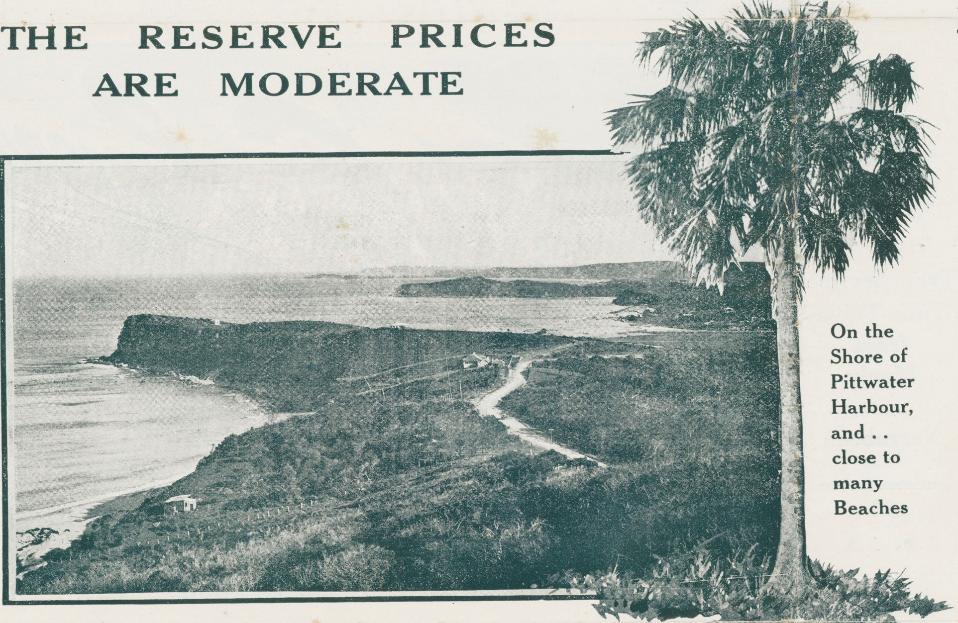
Winter Green Estate Mona Vale Newport, advertised September 1913 for October 25th 1913 sale, Item No.: c050400040, from Newport Subdivisions folder, courtesy State Library of NSW.- enlarged section from to show details
The Mona Vale, Newport and Bungan Beach of 1911 to 1913 was still a relatively rural area – there was a ‘golf’ championship played at La Corniche (Brock’s Hydro) in 1911 that brought a lot of people who would later buy lots of land at Palm Beach, as well as lots of land being sold as ‘Brock’s estate’ and at Newport as the ‘Ocean Beach Estate’ in 1912, the Basin Cup, the tram line was extended to Collaroy and by the end of 1913, to Narrabeen, and there were visitors who broke in to holiday homes, notably just down the road from 'Cooinoo'. Mr. Scott-Fell had a home in the grounds of 'The Oaks', which had been burnt in January 1912.
REMARKLABLE CONFESSION. Alleged Burglars Exploits.
Norman Edward Keals, 27 years of, of Zealand, was before Mr Smithers S.M., at the -Manly Police Court on Friday on several charges of breaking and entering and stealing.
On a charge of breaking into Mr. Scott-Fell's house at Mona Vale, on June 16, the evidence showed that the house had been left properly secured on June 3.
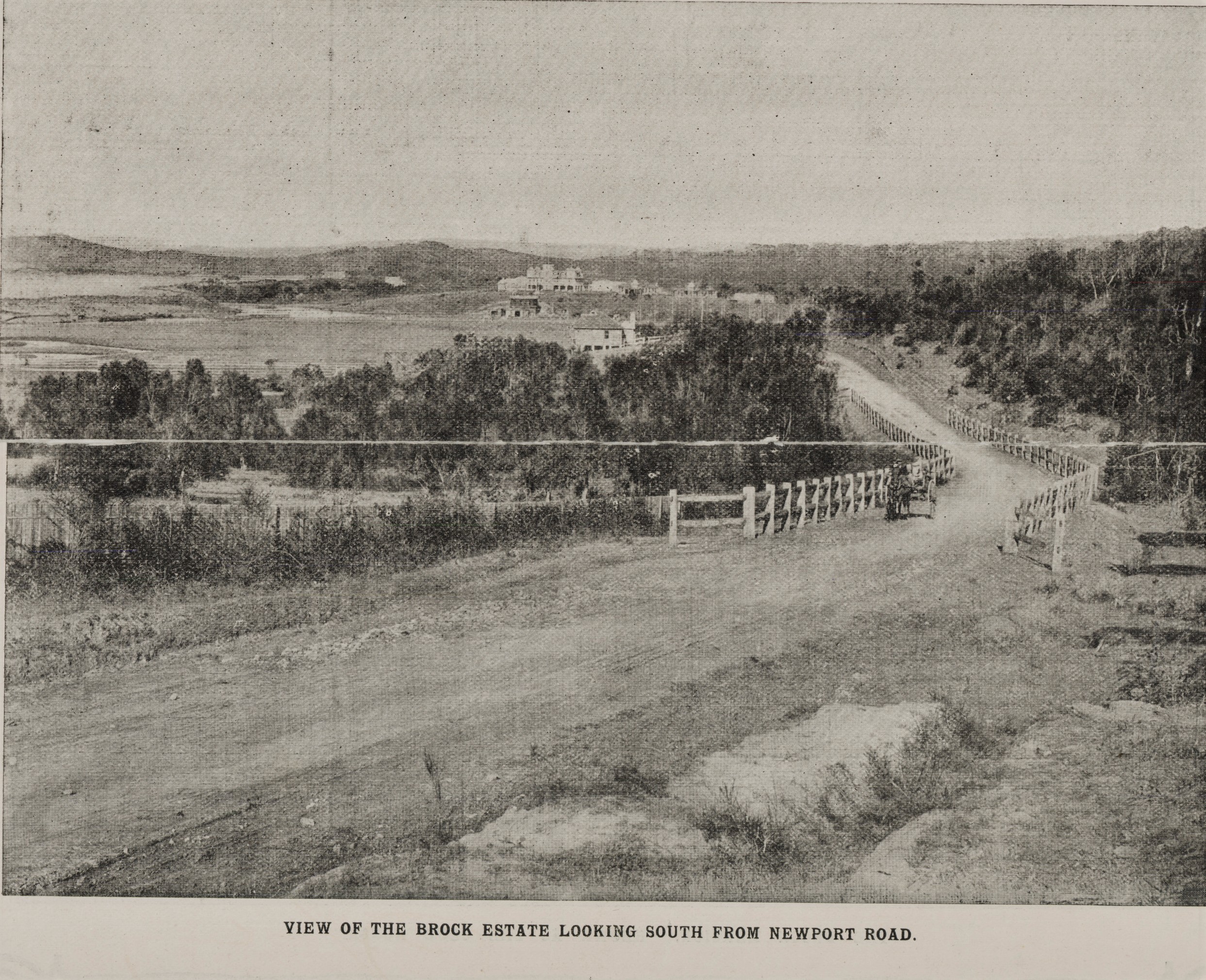
The Brock Estate - 1907, inner page brochure, Item No.: c046820079, Mona Vale Subdivisions, Courtesy State Library of NSW
Mary Rose M'Namara, who visited Scott-Fell's house on June 14, for the purpose of cleaning the place, stated that then she opened the door she found the furniture disarranged and the door open. She begun to work, when a man, whom she identified as the accused, came in from the court-yard. She asked him, "When did you come here?” He replied, "The day before,"
Witness asked him if he was sent by owner, and he said "Yes." Witness started to clean the room, when accused said it didn't want cleaning. He also said the conservatory didn't require any cleaning up. (laughter.) witness then rang" up Mrs. Fell and constable Hewitt-Constable Jones, watchouse-keeper, Manly slated that on the 17th, while he had the accused in custody, Keals voluntarily made the following statement and signed it:-
“on November last I was in Glenbrook looking for work. I came across a tent in Emu Plains camp belonging to Arthur Thompson. I wet into the tent and stole a bicycle from there. I rode the bicycle to Lawson and exchanged it for another which I found leaning up against a church. I afterwards saw in the papers that a young man named Ellis was fined £10 at Penrith Court for stealing a bicycle from Thompson's tent. I did not know Ellis, and he lad no part or share in the stealing of the bicycle. Afterwards I obtained a job on the railway at Glenbrook till February, when I left and went to Pitttwater. The bicycle I took from the church at Lawson I left in the bush at Glenbrook- When passing the Salvation Army Industrial Farm at Dee Why I entered the dining-room, where I obtained some food. I afterwards stole a bicycle from the outside of the shed there I rode the bike the rest of the way to Pittwater. That evening I entered Simpson's store at Bayview, and stole some tinned fish, biscuits. I postcards, and about 2/6 in silver; also some bottles of soft drinks. These things I put in a boat there, and sailed down the bay. I got into broken water, and the boat capsized: I got ashore on to the rocks, where I spent the night The next day I took a boat belonging to Dr. Stiles from the beach in front of his house (which I entered, and from which I stole some food) at Mackerel Beach, Broken Bay. I pulled to Careel Bay. I stole two coats, trousers, and shirts from a tent there. I went to Manly that night, and from there to Sydney, where I pawned my watch. With the money I received on the watch I paid my fare to Woy Woy, and got work at Wyong. I left there and went to Newcastle, and got work at Hexham on a farm. Then I went to Williams's place, outside Tarree, and stole some clothes and money. Then I boarded a steamer at Newcastle and returned to Sydney. After working at Balmain for a while I went to Seven Hills, with the intention of leasing a farm there. I failed to get the farm, and on my return to Sydney I bought a revolver at Mick Simmons's, with which I intended to commit suicide. I went to Manly and to the Salvation Army Farm at Dee Why, where I stayed for a few days in a hayloft, and took some food from there, also from the Home of Rest. From there I went to Newport, and after a few days I broke into Scott Fells house at Mona Vale, and stayed there for a few days, and lived on the food that I found in the house. On June 14 I left Scott Fell's house, and went to another furnished cottage owned by Mr. Edward Scott-Scott, where I broke in, and remained until I was surprised by a party of weekend campers. I jumped out of the window, and ran away, but they caught me, and sent for Constable Hewitt, and gave me in charge. I wish to add that on my way to Pittwater the first time I entered the Salvation Army premises at Collaroy Beach, and stole a hymn-book.
Accused, who had nothing to say, was remitted for trial at the Darlinghurst Quarter Sessions. Accused was also committed for trial on two other charges, one of breaking into and stealing goods and money to the value of £15 from the shop of Arthur Morris Simpson, at Bay View, on February 11, and the other of stealing a boat from Dr. Stiles, Mackerel Beach, Broken Bay, on February 13. He was allowed Bail in each case. REMARKABLE CONFESSION. (1912, July 2). Singleton Argus(NSW : 1880 - 1954) , p. 1. Retrieved from http://nla.gov.au/nla.news-article80063111
Through William John Adams the holding was transferred, on the 24th of February 1918, to the Adams Investment Company Limited - another family owned company. This item from early the next year shows the family name may have been applied to Bungan Beach for a short while:
SHIP'S BOATS SIGHTED
TWO NEAR MONA VALE
The Navigation Department was notified this morning that two ship's boats were adrift off Adams's Beach, near Mona Vale, and about five miles out to sea. A message was sent to the pilot master through the signal station, and the Captain Cook proceeded north to investigate. SHIP'S BOATS SIGHTED (1919, April 2). The Sun (Sydney, NSW : 1910 - 1954), p. 6 (FINAL RACING). Retrieved from http://nla.gov.au/nla.news-article221455530
At Bungan and Newport the place was ‘going ahead’ as a holiday destination with the Yewen land sale of 1920 and the change in the landscape very visible from 1910 to 1920, as these sections and panoramas from the Enemark collection held by the National Library of Australia show:
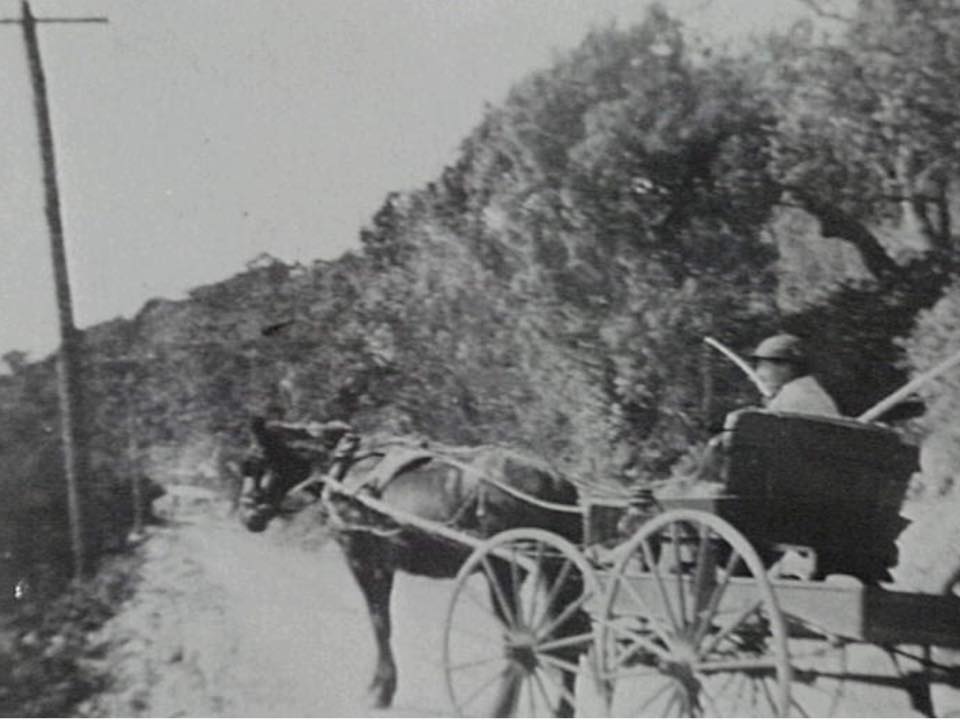
Mrs. Yewen (Bungan Beach-Newport) in her horse drawn cart on Barrenjoey Rd., 1918
The Yewens lots of land are shown as sold in the 1892-1894 land sales by Pile & Allum, although Alfred Yewen may have bought his sections in 1906 with his fellow Journalist. A stone cottage, apparently hand built by Mr. Yewen, commenced from then. The Yewens had cows for milk, which they named, chickens for eggs, an orchard and a nice home called 'Bungania', complete with Billiards room and a substantial library. They entertained politicians, philosophers and writers. Other families built homes on the grounds surrounding the beach, the most quirky of which was Bungan Castle built by Adolph Alber in 1919. Both these buildings were constructed from the local onsite sandstone.
The landscape may be read of in: On Bushrangers Hill and Pittwater Reserves: The Green Ways; Bungan Beach and Bungan Head Reserves: A Headland Garden
New Tourist Resort.
Bungan Head, Newport is no longer an exclusive lone hand promontory only visible to the public from a distance. It is now part of a public domain, and has opened out one of the tourist drives of the district, as well as made available one of the finest areas for seaside residences that the most artistic taste could desire. The Lookout is part of the reserve dedicated for public use, which extends on the high land, as well as along the foreshore from Bungan Beach right round to the Little Reef Beach. From the Lookout and Indeed, from any of the sites on the headland a view of unsurpassed charm can be obtained in ordinary weather, while a scene of great grandeur Bungan Head road skirts the northern and southern slopes of the headland, and leads to the bluff from both sides, On the southern slope the view embraces the Intervening headlands. Little Reef, with glimpses of the beaches to the South Head Light. Looking south-east there are the ships and boats that pass to and from, as well as in and out of Sydney Heads. Away south-west stretch the terrace of hills that rise from Manly to French's Forest, Gordon, Pymble, to Kuringai Chase. On the northern slope the view along the coastline extends to Cape Three Points, taking in a full view of Newport Beach, a, portion of Bilgola Beach, and headland; the pleasing side of the South Head of Broken Bay, together with the hilly lands that melt into the sky In the distance. To the west, right In the foreground, and mount. Loftus and Bayview, revealing part of Pittwater as well as apart of Kuringai Chase. Tin north- east aspect Is bounded by the Pacific horizon.
Away from the Crowd.
Bungan Beach, not being observable from the main road, makes it private and select. Little Reef is somewhat the same. They are both little known at present. Bungan Beach is excellent for surfing. Bathing sheds are provided by the Warringah Council. Little Reef is not suitable for bathing. It Is an ideal rambling ground, and has a good rock fishing spot.. All the building sites have been u arranged that the maximum advantage of the natural position of the land has been obtained. Land that possesses great natural beauty. as well as lbs surf and beach. Is a magnet for all time, especially when It Is within easy reach at calm water for boating and sailing. In the past, before the call of the surf, mod people were content to spend their lives In the city and suburbs. The slow means of travel were partly responsible for It, but the era of the motor car has passed that out. Even aircraft may bring Bungan Head within a quarter of an hour of the city. Lance Gidding will offer the Bungan Head Estate on Boxing Day (Monday week). Building and Building Land. (1920, December 15). Evening News (Sydney, NSW : 1869 - 1931), p. 8. Retrieved from http://nla.gov.au/nla.news-article117298393
Bungan Head Estate attracted a crowd of buyers on Boxing Day. Bidding was brisk and competition keen. The auctioneer, Mr. Lance Giddings of 115 Pitt Street, had no trouble disposing of over £5000.00 worth of allotments. It is expected that numerous private sales will be affected during the week. LAND SALE AT NEWPORT. (1920, December 28). Evening News (Sydney, NSW : 1869 - 1931), p. 4. Retrieved from http://nla.gov.au/nla.news-article117296291
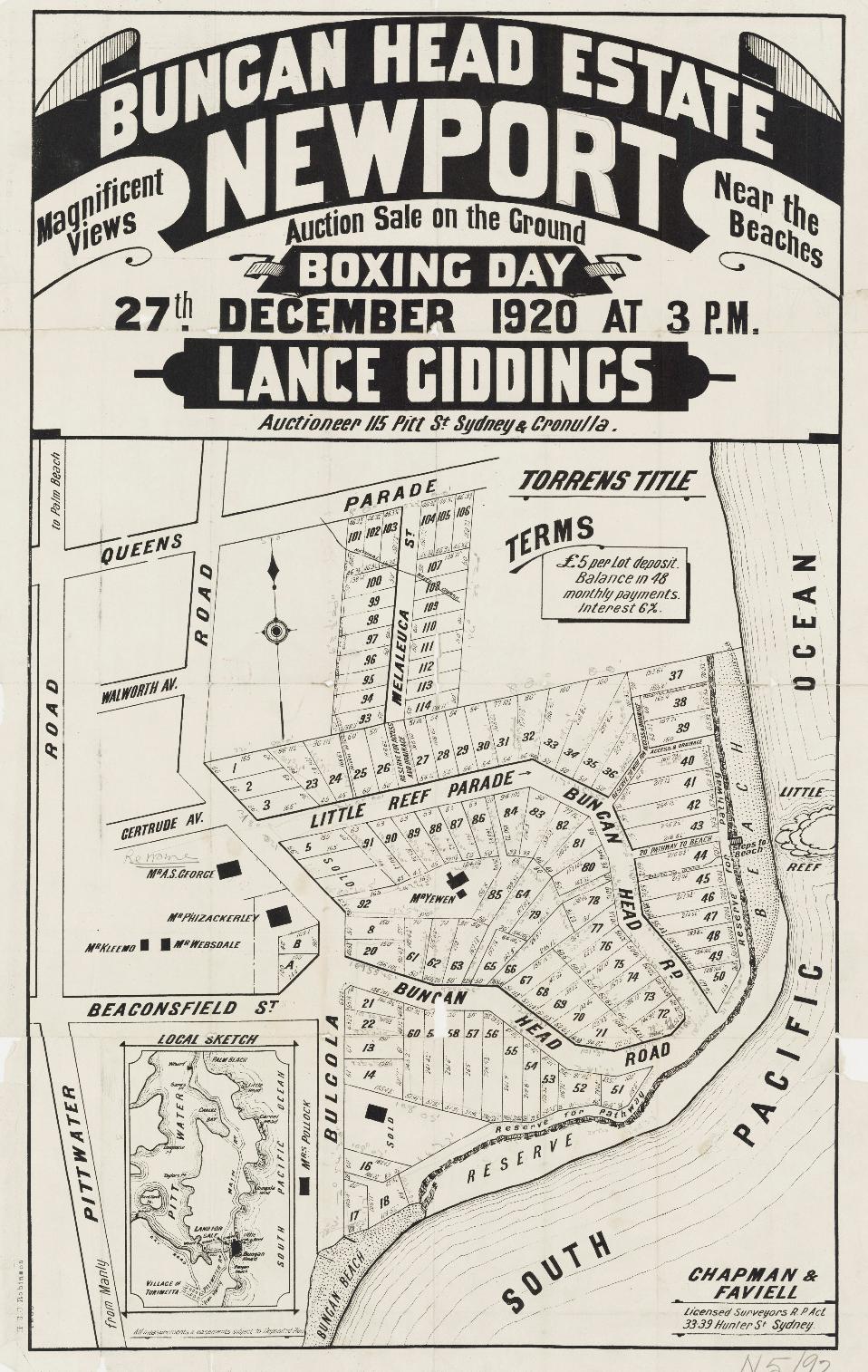
Bungan Head Estate, December 1920 - Item No.: c050400068 - Bulgola Road (renamed Myola Road in 1927), Bungan Head Road, Beaconsfield Street, Gertrude Avenue, Little Reef Parade, Melaleuca Street, Walworth Avenue, Queens Parade - Boxing Day is strangely December 27th in 1920 flyer - from Newport Subdivisions folder, courtesy State Library of NSW
LAND SALE AT NEWPORT
Bungan Head Estate, overlooking Newport Beach, attracted a crowd of buyers on Boxing Day. Bidding was brisk and competition keen. The auctioneer, Mr. Lance Giddings of 115 Pitt-street, had no trouble in disposing of over £5000 worth of allotments. It is expected that numerous private sales will be effected during the week. LAND SALE AT NEWPORT (1920, December 28). Evening News (Sydney, NSW : 1869 - 1931), p. 4. Retrieved from http://nla.gov.au/nla.news-article117296291
Mr. Lance Giddings sold on Boxing Day 40 allotments In the Bungan Head Estate, Newport, on behalf of A. G. and M. A. Yewen, at prices ranging from 25/ to £3/10/ per foot. The total of the sales amounted to £5293. REAL ESTATE. (1921, January 8). The Sydney Morning Herald(NSW : 1842 - 1954), p. 9. Retrieved from http://nla.gov.au/nla.news-article28090109

View From Bushranger’s Pt Near Newport Hill [NSW] c1920s. Vintage silver gelatin photograph, typed title on accompanying slip, Shows Bungan and Mona Vale Beaches. By NSW Government Printer (Aust., commenced 1842). Item #CL174-113 - Price (AUD): $1,250.00 - from Josef Lebovic Gallery
.jpg?timestamp=1622161012135)
.jpg?timestamp=1622160983886)
.jpg?timestamp=1622160940342)

EB Studios (Sydney, N.S.W.). (1917). Panorama of houses on top of Bungan headland, looking north towards Newport Beach, New South Wales ca. 1920s (and enlarged sections from) Retrieved from http://nla.gov.au/nla.obj-162419012
.jpg?timestamp=1622161139375)
.jpg?timestamp=1622161206549)
.jpg?timestamp=1622161248916)
.jpg?timestamp=1622161324152)
EB Studios (Sydney, N.S.W.). (1917). Panorama of Newport Beach, New South Wales, ca. 1920s (and enlarged sections from) Retrieved from http://nla.gov.au/nla.obj-162404370
The place was advertised for sale as ‘Cooinoo’ during 1923, and again in 1926. This time the place sold – to John Bateman, Hotelier, the deed of transfer dated March 16th, 1926.
The 1923 advertisement describes the premises as:
"Cooinoo," a large residence situate on the main Newport-road, Mona Vale, just past the 11-mile Store. This bungalow is constructed of rustic weatherboard on stone foundation with an iron roof, and is built in such a position that while commanding glorious views and overlooking the beach, is well sheltered from the westerly and southerly winds. There is a fine verandah and a very large billiard room (35 x 20), while off the billiard room there are two sleeping cubicles. In addition there are four bedrooms, a large living room, bathroom, maid's room, kitchen, and and domestic offices.
Detached is a garage, together with man's room and laundry. Electric light is supplied by a windmill generator, with an oil engine as a standby. Water is amply provided for, there being seven tanks, each with a capacity of 1000 gallons. The land has a frontage of about 261ft., with a depth on one side of 377ft. and of 380ft. on the other, extending to high-water mark of the Pacific Ocean, and is laid out in lawns and gardens, and in addition, is a six-hole putting green. As far as travelling facilities are concerned a motor 'bus to Narrabeen passes the door. This is a property that should appeal to a gentleman about to retire from business or for people desiring a comfortable summer residence. INDOOR AUCTIONS (1923, January 10). The Sun (Sydney, NSW : 1910 - 1954), p. 2 (FINAL EXTRA). Retrieved from http://nla.gov.au/nla.news-article223456494
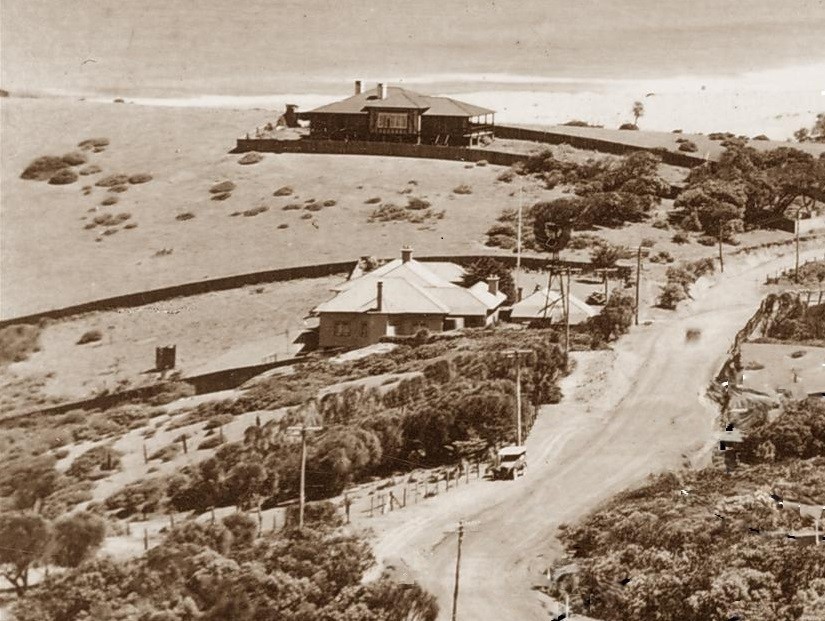
Cooinoo, circa 1926-1933 - section from, courtesy State Library of Victoria
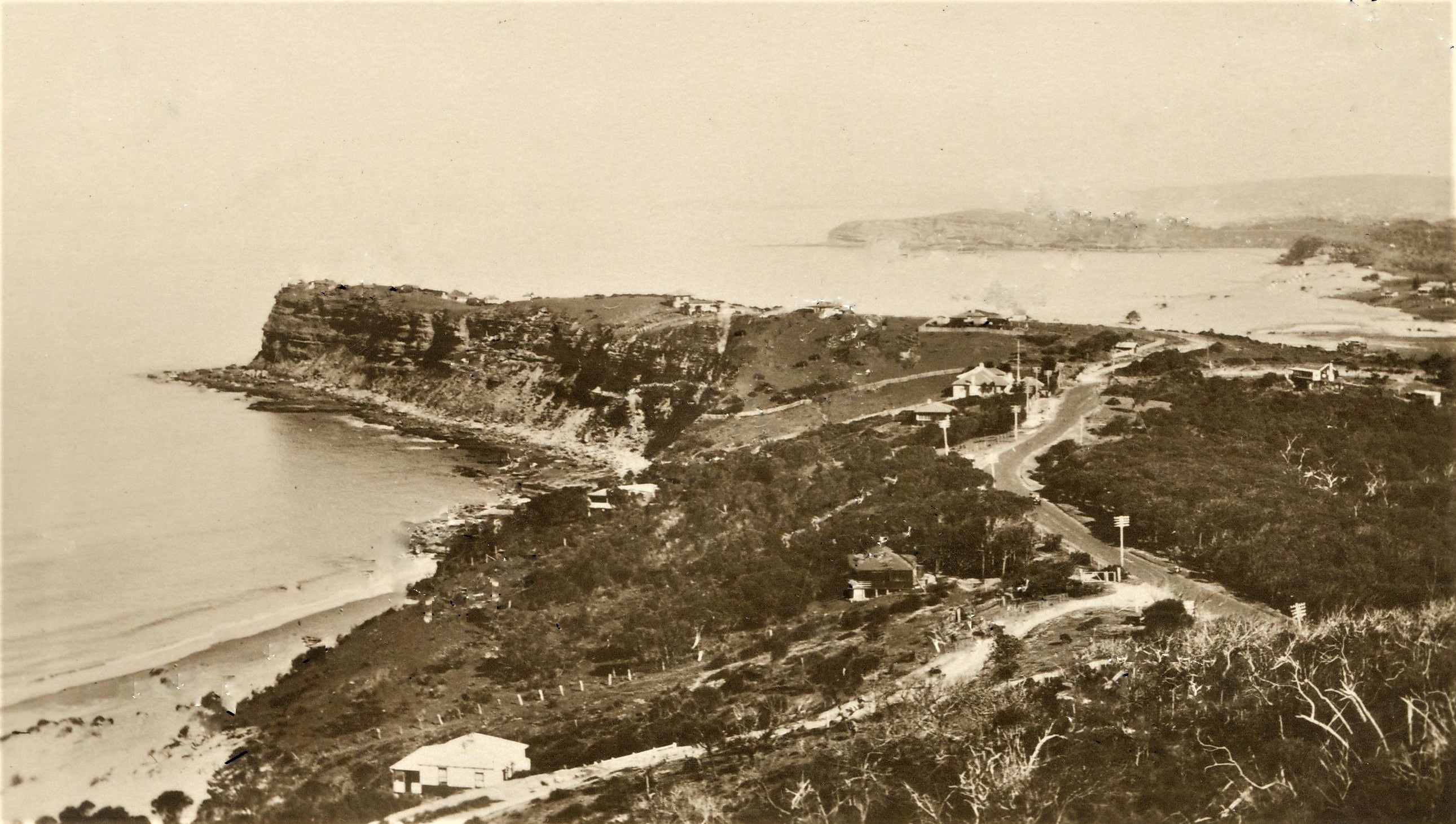
Other Items on the list include a recently constructed weatherboard bungalow on the Bungan-road, Newport …INDOOR AUCTIONS (1923, February 7). The Sun (Sydney, NSW : 1910 - 1954), p. 11 (LAST RACE EDITION). Retrieved from http://nla.gov.au/nla.news-article223449902
a bungalow at Bungan Head, Newport, was passed in at £1150. REAL ESTATE. (1923, February 10). The Sydney Morning Herald (NSW : 1842 - 1954), p. 11. Retrieved from http://nla.gov.au/nla.news-article28078229
There will also be offered Cooinoo, a residence on the Newport-road, Mona Vale. REAL ESTATE. (1926, February 27). The Sydney Morning Herald (NSW : 1842 - 1954), p. 9. Retrieved from http://nla.gov.au/nla.news-article16266027
The bungalow, Cooinoo, on the main Newport-road, Mona Vale, was sold for £2000. REAL ESTATE. (1926, March 6). The Sydney Morning Herald (NSW : 1842 - 1954), p. 10. Retrieved from http://nla.gov.au/nla.news-article16272712
Interestingly, this sales lithograph shows the Summer house in 1924:
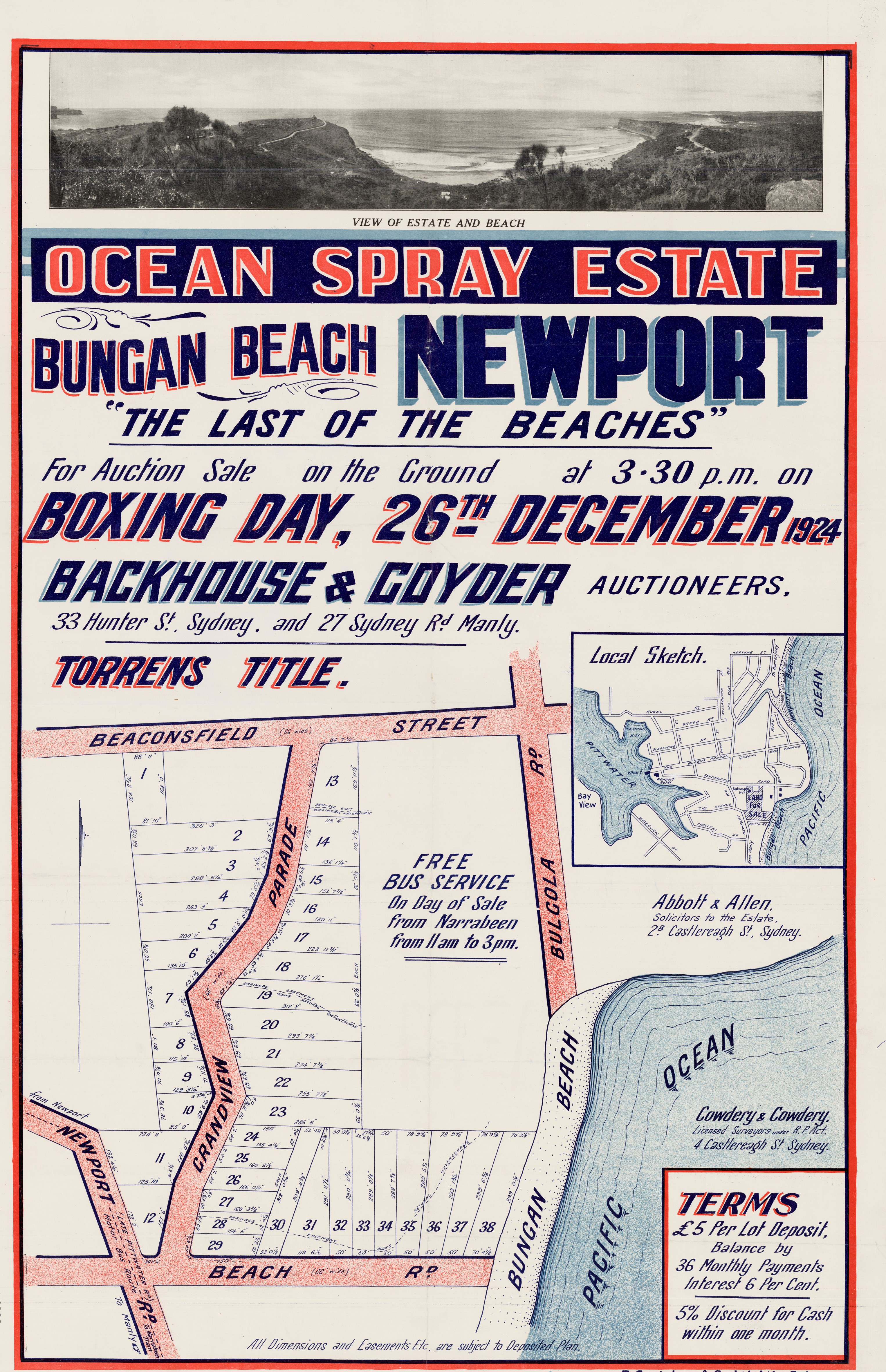
Ocean Spray Estate - Bungan Beach 1924. Grandview Parade, Bulgola Road, Beach Road - 'Newport Road' is Barrenjoey Road Item No.: c050400074 - from Newport Subdivisions folder, courtesy State Library of NSW - and enlarged sections from

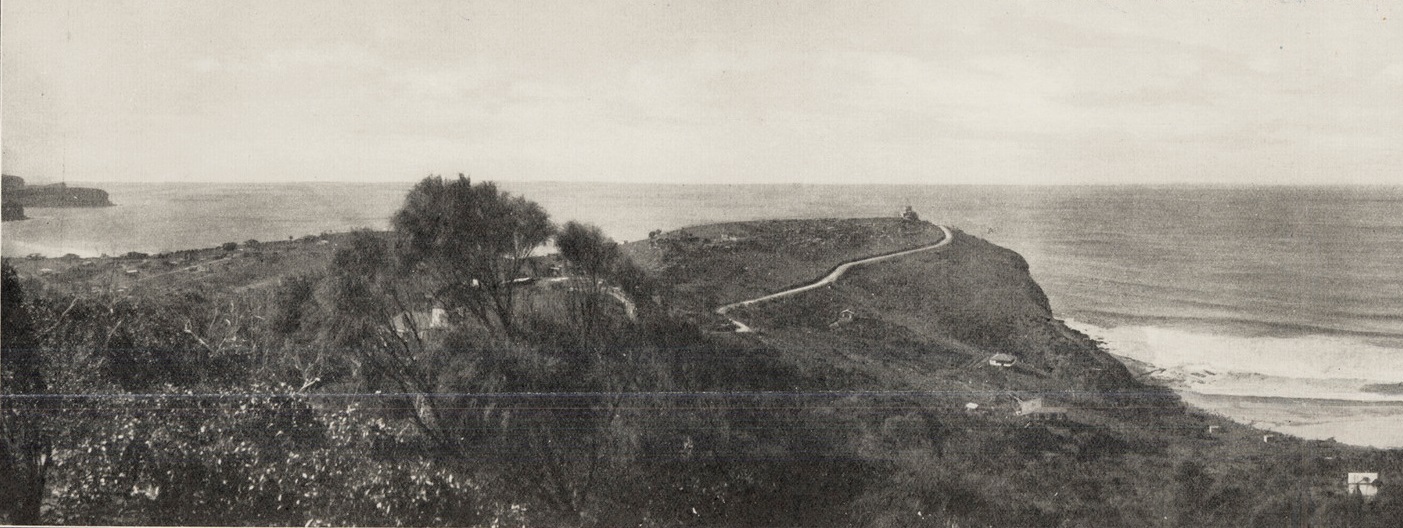
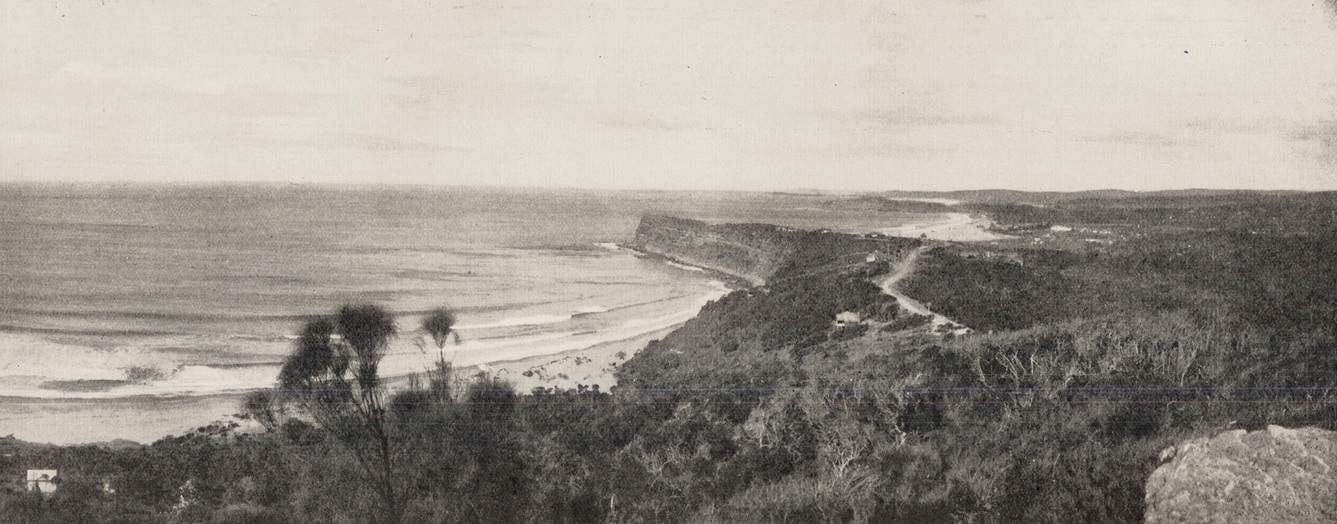
OCEAN SPRAY ESTATE.
BUSHRANGER'S HILL-NEWPORT-BUNGAN BEACH.
"THE LAST OF THE BEACHES."
SIGHTLY, MAGNIFICENT, and APPROPRIATELY PLANNED.
TO BE AUCTIONED ON THE GROUNDS,
DECEMBER 26. 1924--BOXING DAY
AT 3.30 P.M.
£5 DEPOSIT,
' BALANCE SO MONTHLY PAYMENTS; AT 6 PER CENT.
FREE 'BUS SERVICE from NARRABEEN from 11 a.m. till 8 p.m. on DAY OF SALE.
LET US SEND YOU A LITHOGRAPH.
BACKHOUSE and GOYDER, AUCTIONEERS, 88 Hunter-street, Sydney and 27 Sydney-road, Manly. Advertising (1924, December 17). The Sydney Morning Herald (NSW : 1842 - 1954), p. 22. Retrieved from http://nla.gov.au/nla.news-article16203227
Mr Bateman made some improvements and enlarged the footprint of the home:
Newport—Additions Newport Road.—J. Bateman, Newport Road, Newport. Buildings and Works Approved (1935, December 4). Construction and Real Estate Journal (Sydney, NSW : 1930 - 1938), p. 2. Retrieved from http://nla.gov.au/nla.news-article222917637
The Cooinoo remained in the Bateman family until John passed away in May 1940. It then, under the terms of his will, came under the oversee of the Permanent Trustee Company who tried to sell it, advertising the property in December 1940, and when no offers were made, advertising it for lease for £8/8 per week for six months.
Those advertisements - the first showing some modifications have taken place during Mr. Bateman's ownership:
RAINE A, HORNE LTD
Auctioneers
Under instructions from PERMANENT TRUSTEE CO. OF N.S.W. LTD
Executors of Will of late John Bateman, Newport
"COOINOO" NEWPORT ROAD
With WATER-FRONTAGE to BUNGAN BEACH. On main bus route, Palm Beach - Wynyard; just beyond Mona Vale.
AN ATTRACTIVE OCEAN FRONTAGE PROPERTY, in splendid order, replete with every modern comfort and convenience, and commanding MAGNIFICENT PANORAMIC OCEAN VIEW.
THE MAIN COTTAGE is of Rusticated Weatherboard on brick piers with roof of iron and comprises a very large LIVING ROOM, large DOUBLE BEDROOM, second BEDROOM, modern BATHROOM (with Roman bath, syphonic suite and pedestal basin) and has WIDE VERANDAHS on three sides.
ANNEXED and built around a Garden Courtyard, are large BILLIARD ROOM (with Fireplace and Ingle nook and 2 large Alcoves the whole measuring about 28ft by 36ft) 2 BEDROOMS in Basement also 2 MAIDS ROOMS, staff DINING ROOM, MAIDS' BATHROOM, KITCHEN (sink and 2 stoves) LAUNDRY etc.
ELECTRICITY, CITY WATER, 6 TANKS DETACHED are GARAGE, MAN'S ROOM, TOOLSHED, SUMMER HOUSE, extensive FOWL RUNS.
THE GROUNDS are extensive and well laid out with Terraced Kitchen Garden, gravelled Drive, well grown Hedges etc.
The land has an area of 2 acres 0 rood 34 perches, with a frontage of 264ft to NEWPORT ROAD by depth of about 360ft through to Bungan Beach, where there is a rock Bathing Pool
TORRENS TITLE
Furniture may be acquired.
Vendor's Solicitors: Messrs. Norton Smith and Co.
RAINE and HORNE LTD, in conjunction ROBEY, HANSON and STRONG PTY LTD Manly, will offer the above at PUBLIC AUCTION, in THE ROOMS, 70 PITT STREET on THURSDAY 12th DECEMBER, 1940 at 11 a.m. Advertising (1940, December 4). The Sydney Morning Herald (NSW : 1842 - 1954), p. 21. Retrieved from http://nla.gov.au/nla.news-article17701531
TO-MORROW, THURSDAY 12th DECEMBER, 1940, at 11 a.m. NEWPORT.— "COOINOO," NEWPORT ROAD Water-frontage home, about 9 rooms, etc., Garage. Land over 2 acres. Torrens. (By order of Permanent Trustee Co. of N.S.W., Ltd.) Advertising (1940, December 11). The Sun (Sydney, NSW : 1910 - 1954), p. 11 (LAST RACE ALL DETAILS). Retrieved from http://nla.gov.au/nla.news-article231150775
NEWPORT FURNISHED
COOINOO. NEWPORT ROAD
Delightful Views Overlooking Ocean
Cottage residence dining room, breakfast room, billiard room, 5 bedrooms and all offices, extensive verandah Detached garage and man’s rooms, water, electricity, septic tank. Available 6 months £8/8/ per week
PERMANENT TRUSTEE CO. OF N.S.W. LTD. 23-25 O’CONNELL STREET, SYDNEY. Advertising (1940, December 28). The Sydney Morning Herald (NSW : 1842 - 1954), p. 13. Retrieved from http://nla.gov.au/nla.news-article17700735
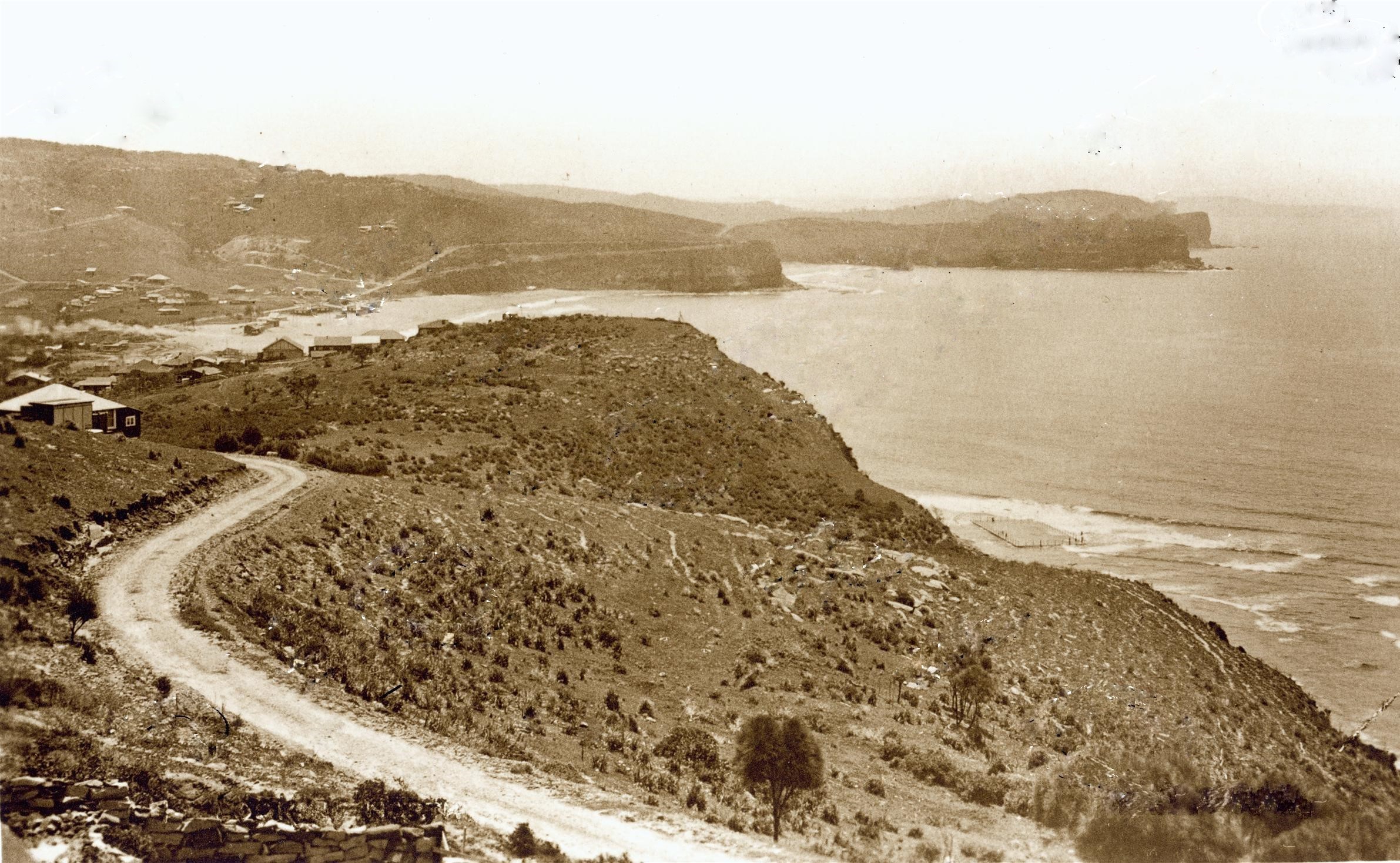
Bungan Head, 1920 - Land sales at Bungan - Yewen 'Bungan Head Estate' - note pool, circa 1926.
The above pool can be seen in the photograph below it from 1920 which was used to advertise land sales for the Yewen family at Bungan Head. Some remnants of this pool remain - images taken when went 'investigating' in 2016:
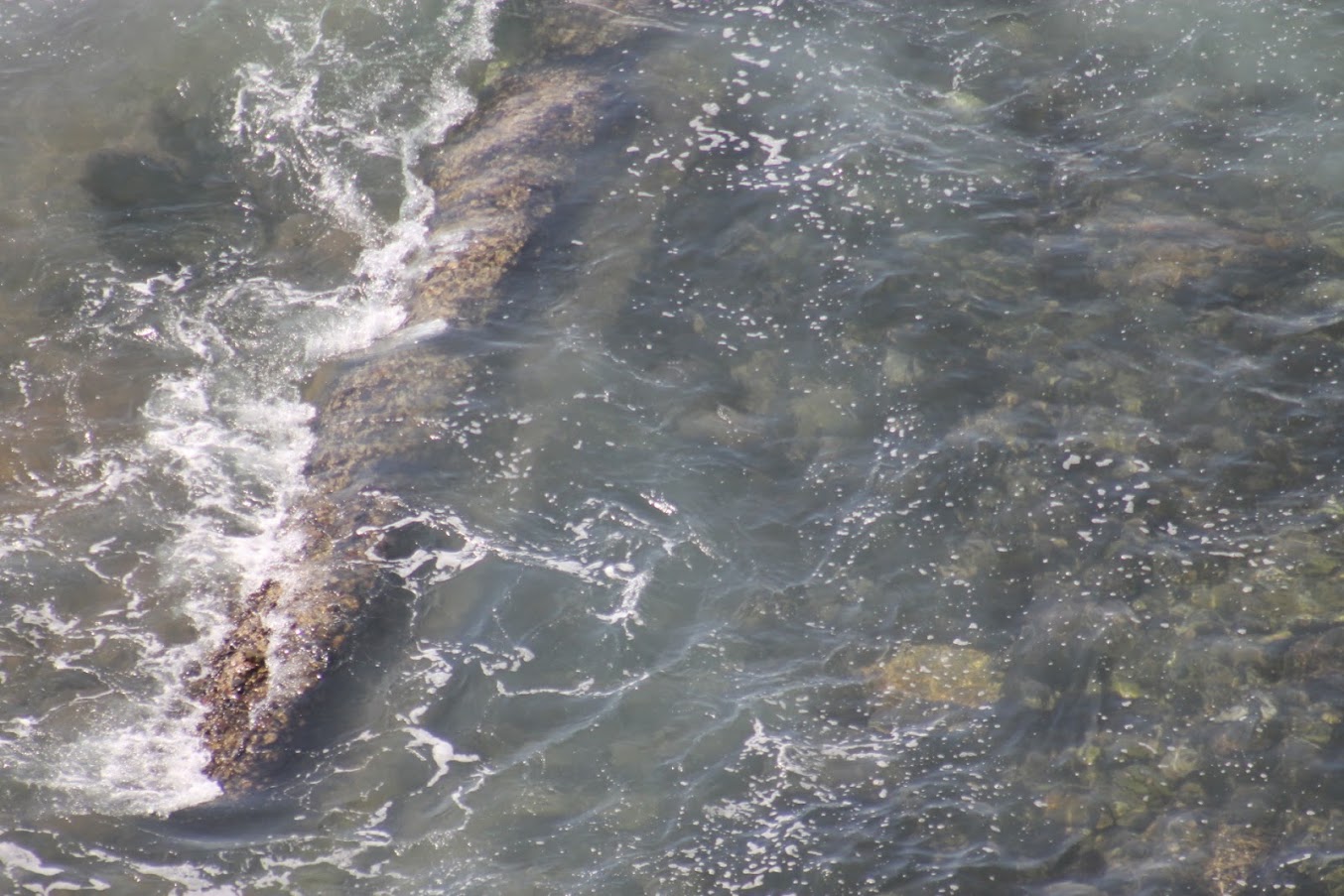
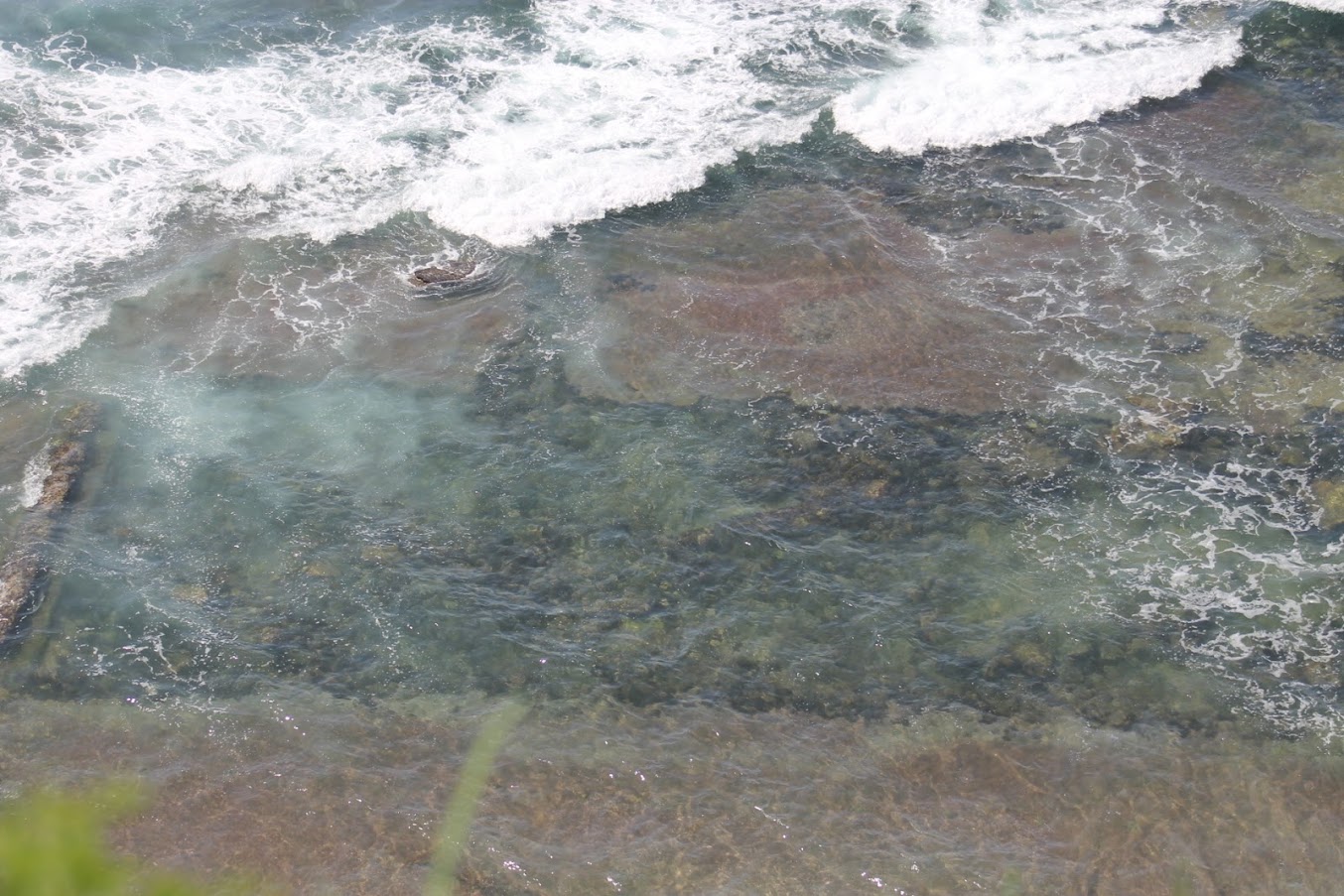
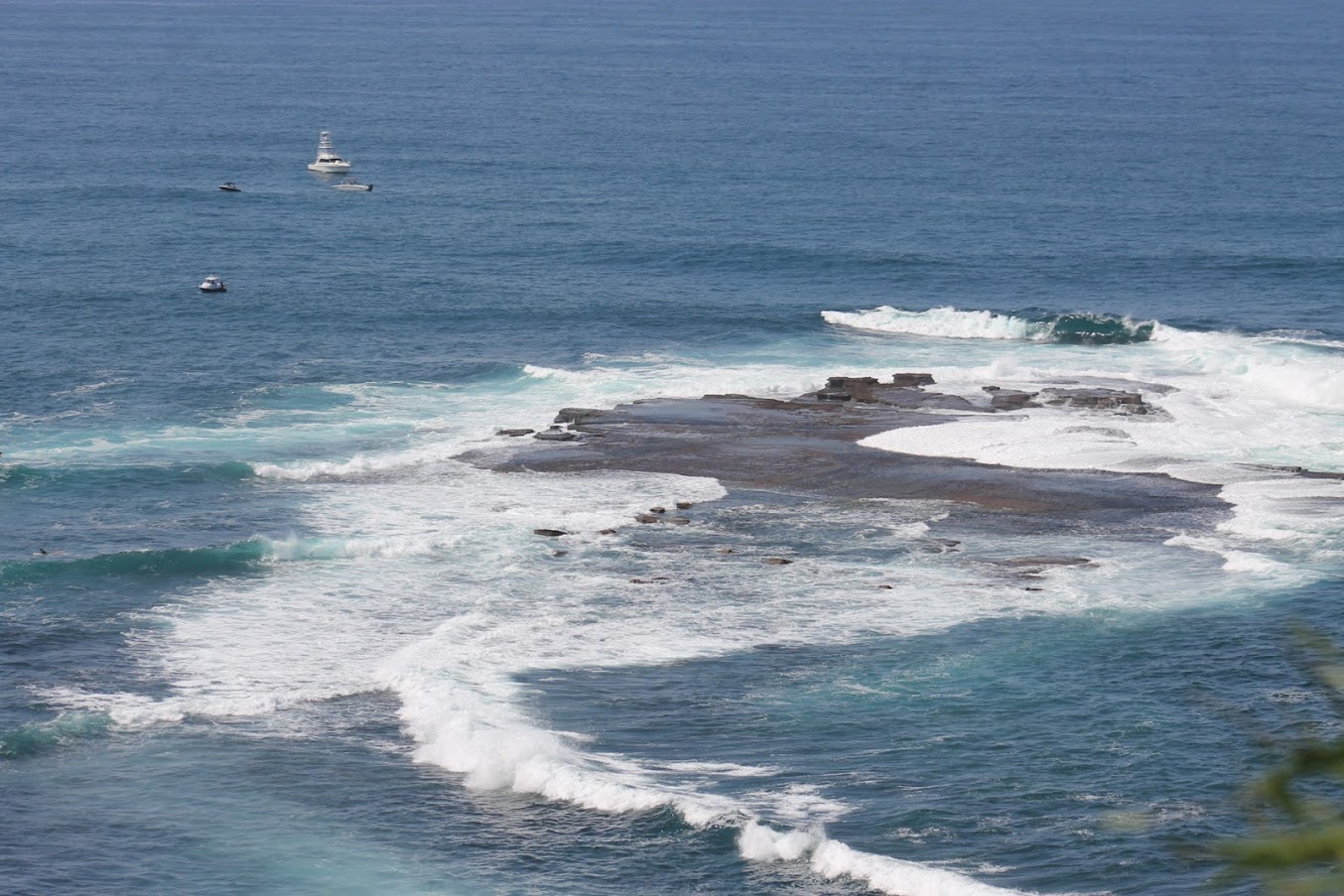
Finding Newport's second rock-pool, Easter Saturday Investigation!, March 26th, 2016. Top is close up of cement edge and below this the whole of - can be seen from view available at 'cross-waves' - Newport Beach-Bungan Ridge. A J Guesdon photos.
A few notes - the first rock pool at Newport was built at the northern end:
CIVIC SPIRIT AT NEWPORT.
At yesterday's meeting of the Warringah Shire Council, a letter was received from the Newport Progress Association requesting that a special Improvement rate of /1 in the £ be levied In Newport. It was also suggested that tenders be called for the construction of a rock-bath at the southern end of Newport Beach. The association stated that local residents would contribute towards the cost of the bath.
The civic spirit of members of the association was applauded by several members of the council, and it was decided to ask for particulars of the area to be included under the proposed special rate, and also for information regarding the improvements to be carried out. It was also decided to call for tenders for the proposed rock-bath, and to accept the offer of co-operation in the matter. CIVIC SPIRIT AT NEWPORT. (1924, September 2). The Sydney Morning Herald (NSW : 1842 - 1954), , p. 12. Retrieved from http://nla.gov.au/nla.news-article16168520
A few swimming seasons later:
MONA VALE'S DAY At Newport's Carnival
MONA VALE did well at Newport's carnival yesterday. Jock Blackwood, a N.S.W. Rugby Union forward, and Lester Hill, son of Billy Hill, noted amateur all-rounder, won the 75 yards relay handicap from Carmanola and Dudley Laidlaw, of Prymont. C. Robertson collected the 75 yards handicap in 49 1-5 sees., from Dyer and Blackwood. Misses Mattle and Ethel Mealing, N.S.W. champions, gave exhibitions, the former 75 yards backstroke in 03 2-5, and the latter the same distance free style in 60 4-5 secs. MONA VALE'S DAY (1926, January 31).Truth (Sydney, NSW : 1894 - 1954), , p. 4. Retrieved from http://nla.gov.au/nla.news-article168723733
New Bath for Newport A number of swimming enthusiasts assembled at Newport yesterday to witness the opening by the Chief Secretary (Mr. Lazsarini) of the new rock baths. They are very fine, and have cost £560. Miss Mattie Mealing swam 75yds backstroke in 63 2-5 sec, and sister Ethel covered the same distance free style in 50 4-5sec. Their efforts were loudly cheered. SYDNEY RACING (1926, January 31 - Sunday).Sunday Times (Sydney, NSW : 1895 - 1930), , p. 11. Retrieved from http://nla.gov.au/nla.news-article128124866
NEWPORT'S OPENING. Good Sports Work for New Bath
NEWPORT'S new bath was opened with due ceremony, and it promises to fill a long-felt want in the district. The pool built up on the rocks is 113 feet long by 50 feet wide, and has an average depth of 4ft 6in. Its situation will allow splendid accommodation for spectators, and yesterday's show was a fine one. Amongst the hard workers for the new club are Geoff Snell, a captain of Mosman Club in its early days, and Gus Widmer, an ex-100 yards track champion of New South Wales, and rep. Rugby Union player.NEWPORT'S OPENING (1926, January 31).Truth (Sydney, NSW : 1894 - 1954), , p. 4. Retrieved from http://nla.gov.au/nla.news-article168723782
On June 20th, 1941 the Cooinoo was transferred by deed to Albert John Swan of Sydney, Accountant.
During this time much of Bungan Beach and that ridge between Newport and Mona Vale was marked by tank traps to create barriers against invasion. The Japanese submarine as an official war grave off Little Reef, Bungan, bears testament to the danger that was present.
Albert had married a local girl in 1915:
SWAN—WICKHAM.—November 22, 1915, at St. Phillip's Church, Sydney, by the Rev. Canon Bellingham, Albert John, second son of Mr. and Mrs. W. J. Swan, of Melbourne, to Violet, eldest daughter of Mr. and Mrs. H. F. Wickham, of Manly. Family Notices (1915, December 24). The Sydney Morning Herald (NSW : 1842 - 1954), p. 6. Retrieved from http://nla.gov.au/nla.news-article15633516
Their first and only child was born in the Spring of the following year:
NSW BDM's - Birth: SWAN BETTY 30684/1916 ALBERT J VIOLET MOSMAN
SWAN. — At a private hospital, Mosman, to Mr., and Mrs. A. J. Swan, "Sherbourne," Reginald Street, Mosman— a daughter.
SWAN.— September 11, 1916, at a private hospital, Mosman, Violet, beloved wife of A. .J, Swan, 'Sherbourne,' Reginald Street, Mosman, aged 25 years.
SWAN. — The Friends of Mr. A. .J. SWAN, of "Sherbourne," Reginald Street, Mosman, are kindly invited to attend the Funeral of his late dearly beloved Wife, Violet, to leave Our Funeral Parlors, 111Walker Street, North Sydney, THIS (TUESDAY) AFTERNOON, at 1 o'clock, for the Church of England Cemetery, Gore Hill WOOD. COFFILL and COMPANY. Ltd Family Notices (1916, September 12). The Daily Telegraph (Sydney, NSW : 1883 - 1930), p. 4. Retrieved from http://nla.gov.au/nla.news-article239217059
Violet died in childbirth: SWAN VIOLET 12049/1916 HENRY F ELIZABETH MOSMAN
Her father was also a Manly resident of long standing and had also been a Journalist:
OBITUARY.
MR. H. F. WICKHAM.
A former Sydney journalist, Mr. Henry Falkland Wickham, died on Friday at Manly, where he had resided for about 25 years. He was in his 76th year. Born in Brisbane, a son of the then Lieutenant-Governor of Queensland, he came to Sydney and was for many years on the staff of the old "Evening News" until it ceased publication. He also wrote for a number of magazines. Mrs Wickham died about 18 months ago, and one daughter, Mrs. A. H. Walker, survives Mr. Wickham. The funeral took place on Saturday at the Manly Cemetery, following a service in T. Waugh and Company's funeral chapel. OBITUARY. (1936, March 23). The Sydney Morning Herald (NSW : 1842 - 1954), p. 17. Retrieved from http://nla.gov.au/nla.news-article17345793
Mr. Swan held the home and land for just over four years and then sold it to Frederick William Emmett of Manly, Welfare Officer, the deed of transfer/title is dated May 25th, 1945. Mr. Emmett took out a mortgage on August 11th, 1949, with the Bank of New South Wales, discharging the same on November 29th, 1950.
On the 5th of December 1950 Mr. Emmett sold a portion of the land to John William Ormsby, of Newtown, General carrier. The land within described caused a new Certificate of Title to be issued from – produced January 15th, 1951 and entered into Torrens/Deeds on April 6th, 1951 as Vol: 6324 – Fol: 190.
The Deed was Cancelled and Certificate of Title Issued to Vol 6324 Fol. 189 as regards the residence. Vol 6324 Fol. 189: Shows Mr. Emmett held onto 1 acre, 2 roods and 9 perches.
This photo from the late 1940's, early 1950's shows the 'Cooinoo' of then:
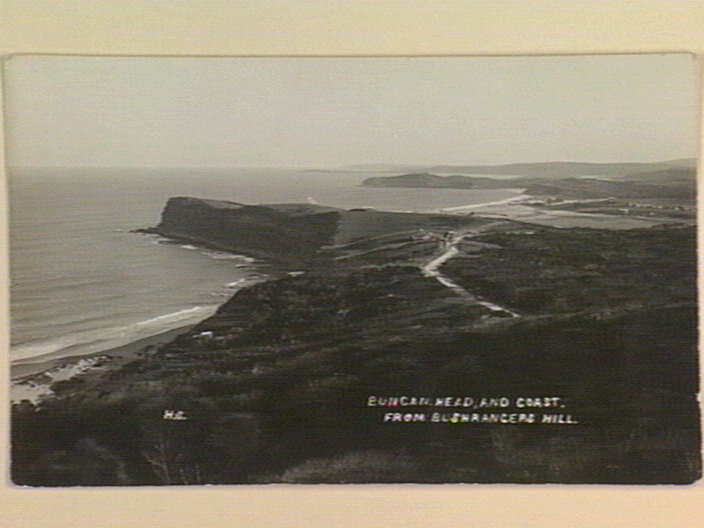
Bungan Beach from Bushrangers Hill - From Osborne Collection - State Library of Victoria
John Ormsby died soon after:
NSW BDM’s: ORMSBY JOHN WILLIAM 16076/1952 Parents: NETTERVILLE ARRAN MARY CATHERINE SYDNEY
ORMSBY John William-August 10 1952 Sydney Hospital beloved husband of Alice and loved father of Lyle and Norman late of Newtown and Newport Road Newport aged 44 years Requiescat In pace. Family Notices (1952, August 11). The Sydney Morning Herald (NSW : 1842 - 1954), p. 10. Retrieved from http://nla.gov.au/nla.news-article18277127
In Vol: 6324 – Fol: 190: His wife, Mary Alice Ormsby, widow, is shown as the holder of the Deed by October 29th, 1953.
'Alice' remarries, and her holding is now named as to Mary Alice Jenkins, wife of Alfred Kingston Jenkins of Camperdown, Structural Engineer, formerly Ormsby. The deed shows she sells to Bertie Bradstock Line, of Parramatta north, retired businessman (formerly a Draper), on May 5th, 1954.
On January 9th, 1958 Francis James Martin of Woollahra, Customs agent, and Edna Mavis Martin, wife, and Brian Francis Martin, also of Woollahra, Journalist, are registered as proprietors within the lands described as joint tenants. [Transfer G871406 , dated December 12th, 1957]
January 20th, 1959 – Claude William Teague and Vera Teague are listed as joint tenants of Lot 1 D.P. 29316
Gustav Einar Carlsson is listed as having had transferred to him (February 16th 1959) Lot 3 and Lot 4 D.P. 29316, together with carriageway/access footpath
Lot 2 D.P. 29316 is transferred to William Henry Hasall and Dorothy Gertrude Hasall as ‘joint tenants’ on December 5th, 1958 – registered April 30th, 1959
Lot 5, D.P. 29316, is transferred to Walter Vincent Burns on April 2nd, 1959.
On May 4th, 1956, Bertie sells some of his land to Albert Edward Norman of Vaucluse, Manager. Albert issues a mortgage to Bertie for some reason on May 2nd, 1956. By October 5th this mortgage has been discharged.
On September 28th 1956 William Gladstone Niness/Hiness and Violet Ethel Niness are joint tenants of Lot C of plan annexed together with Right of Carriage Way and Footway over another part of the land in this Certificate of Title – entered April 23rd, 1957.
This Deed was then cancelled and a new Certificate of Title issued as Vol 7381 – Fol 85
Paul John Reader of Northbridge, Sports Store proprietor, purchases the accessway on September 25th, 1959 – cancelled in 1979. Sheila Reader then in charge – reference to original Volume 7710 Fol. 2
Vol.; 7710 – Fol 2, shows Walter Vincent Burns of Daring Point, Investor is now the proprietor of this estate in fee simple.
By September 1960 Gustav Carlsson of Newport, Builder owns the pathway to the beachfront lot. By November 1961 Charles Richard Stampf of Newport, Company Director, owns the pathway.
What stands out most during these early decades of Bungan Beach becoming a holiday resort and then and suburban home for many is the amount of journalists associated with the purchase of those early lots. Once Bungan Castle was completed their ranks were added to by some of the best Australian Artists visiting. During the 1930's, 1940's, 1950's, 1960's and 1970's their ranks were swelled by vsiiting Russian Ballet Dancers and permanent residents in Musicians, Photographers and Film people.
Adolph. W. Albers, by B E Minns, Dec, 1920 - just one of the pages in the Bungan Castle 'Visitor's Book' - Bungan Castle was built in 1919
This experience recounts the experience of one homebuilder during the post WWII building materials scarcity:
Conventions Grip On Home-builder
By OUR HOUSING CORRESPONDENT
CONVENTION has laid heavy hands on Sydney home design and is reluctant to let go. A film man who sought something different for his new house is finding this to his cost. The baffled homeseeker is Mr. Geoffrey Powell; assistant producer of the films division of the Department of Information.
Last year he bought a block of land at Bungan Head, Newport Beach and set about getting a home in keeping with the windswept, rocky site which would do justice to the excellent views. He began his home quest by consulting an architect noted for the modernity of his designs and suggesting some-thing rather low "to hug the site rather than stick up like a pimple." He casually indicated some American designs to show what he meant.
The architect said he would do his best, but would not be able to capture entirely that slinky American look. American authorities were content with ceilings 8ft from the floor, but New South Wales councils insisted on 9ft.
Subsequent chronology includes:
January: Council approves plan for timber and fibro house. It has the conventional tiled roof but some councillors are a bit doubtful about some departures from pattern-the house is to be on two levels to take advantage of the slope, with a glazed step ' in the roof to get the benefit of afternoon light, and there are a lot of glass louvres and plate-glass so people in the house could see the view without even rising from their chairs.
February-March: It becomes apparent the councillors need not have worried. No builder has had a house like this before and none is" keen to try it except at a cost breath-taking even in 1947.
April-May: Plan abandoned; new one worked out to use prefabricated panels. There are to be stone foundations and one wall is to consist of full-length glass doors. The Powells, parents of two children, have realised there will be a third, so time and money are important,
June: Council rejects the plan because it has a very low pitched roof which, it is claimed, will have inadequate insulation properties. The prefabricators had worked out this asbestos cement roof in an attempt to short-circuit the tile shortage.
Council Adamant
Mr. Powell protests that he proposes to put wide pergolas on two sides of his house to get an effect of hugging the hill and a high-pitched roof would spoil this. But the council is adamant and Mr. Powell consents to a conventional pitched roof.
To save money he decides to dig the foundations himself and cut and to cart the stone.
July: He learns that the roof rejected by the council had been found by the Commonwealth Experimental Building Station to have adequate insulation qualities. But he lets that pass.
August 22: Plan amended to show high-pitched roof taken to council office where it is stamped "approved." Mr, Powell approaches building society which was to finance the house. It is pointed out that the council omitted to stamp the specifications u well h the plana.
August 26: Mrs. Powell takes specification back for stamping. "Approved" stamp is placed on it, but then another inspector discovers it is "one of those prefabs" and the "approved" stamps are cancelled, with the 'note that "timber framework must be in accordance with council regulations."
Mr. Powell reproaches the prefabricators for not putting enough timber in their panels. They produce evidence that the Commonwealth Experimental Building Station in its report on their system chides them with using too much.
The argument turns on those uprights in a timber house called "studs." Council regulations require that they be at least 3in by 2in at 18in centres, while the prefabricated panels have 3 in by 11in studs built into them at intervals of a foot.
The experimental building station report urged that timber should be saved by reducing these studs to 3in by 1in, which could be done "without in any way impairing the stability of the construction."
September 26: Council building committee decides "to adhere to rejection of the specification.
This week: Councillor H. Gregory Forster urges the council to reverse this decision on the spot.
Mr. Powell has spent all his deferred pay on the work he has 'done so far and is desperate for a home, Councillor Forster says. It was "a very grave wrong" for officers. of the council to approve the plan and then cancel the approval.
Anyway, the council has decided to refer the matter back to the building committee for another look. Conventions Grip On Home-builder (1947, October 3). The Sydney Morning Herald (NSW : 1842 - 1954), p. 2. Retrieved from http://nla.gov.au/nla.news-article18045072
The letters of Alfred Yewen to newspapetrs under 'Bungania' speak of great fishing at Bungan Beach. This was also a reculsive place, hidden from the main roads and great fpor those who liked to live rivately or have visitors for whom privacy was needed, away from public spotlights and positions of responsibility. It remains so.
The meaning of the word 'Cooinoo' clearly stems from a language of the original custodians of this place and has been applied and is still the name for a number of houses, outback stations and open green reserves, even within Sydney. It has elements of 'Cooee' as a call, stated by some to have originated in Pittwater, and elements of Cooinda, 'A happy place'.
Either way, some parts of it echo of the original lanuagues and their meanings heard here - and it is easy to see why others 'come here' to this 'happy place'. From the pages of the past:
Coo-wee or Coo-ee ?
ORIGINAL BUSH CALL
By C. G. C. Christie, for S.M. Herald.
It is popularly believed that the Australian blackfellows' call, 'coo-ee,' was heard for the first time by Ensign Francis Barrallier in 1802, when he reached the junction of the Wollondilly and Nattai rivers whilst attempting to find a southern route over the Blue Mountains. But a small party from H.M.S. Sirius, under Captain Collins, Captain Johnson, and Surgeon White, recorded having heard and used this strange call thirteen years, earlier on an expedition which set out from the north side of Port Jackson to find an overland path to Pittwater. After a long and fatiguing trip of nine hours they arrived at Pittwater on June 7, 1789. When they came upon some natives they called to them 'in their own manner, coo- wee,' which, says the record, signifies 'come here.'
This spelling and pronunciation recorded by the Sirius party are unusual to us now, but it seems to be a more correct form when it is recalled that in aboriginal words and speech, the blackfellows' tongues were much given to a pronounced use of consonants, especially labials, before the sounds equivalent to our double vowels. We get, too, many words in which the ' wee ' sound is very pronounced, such as Weeroona, Wee Waa,-and Warrawee. Coo-wee or Coo-ee?. (1942, January 10). The Scrutineer and Berrima District Press (NSW : 1892 - 1948), p. 2. Retrieved from http://nla.gov.au/nla.news-article124194088
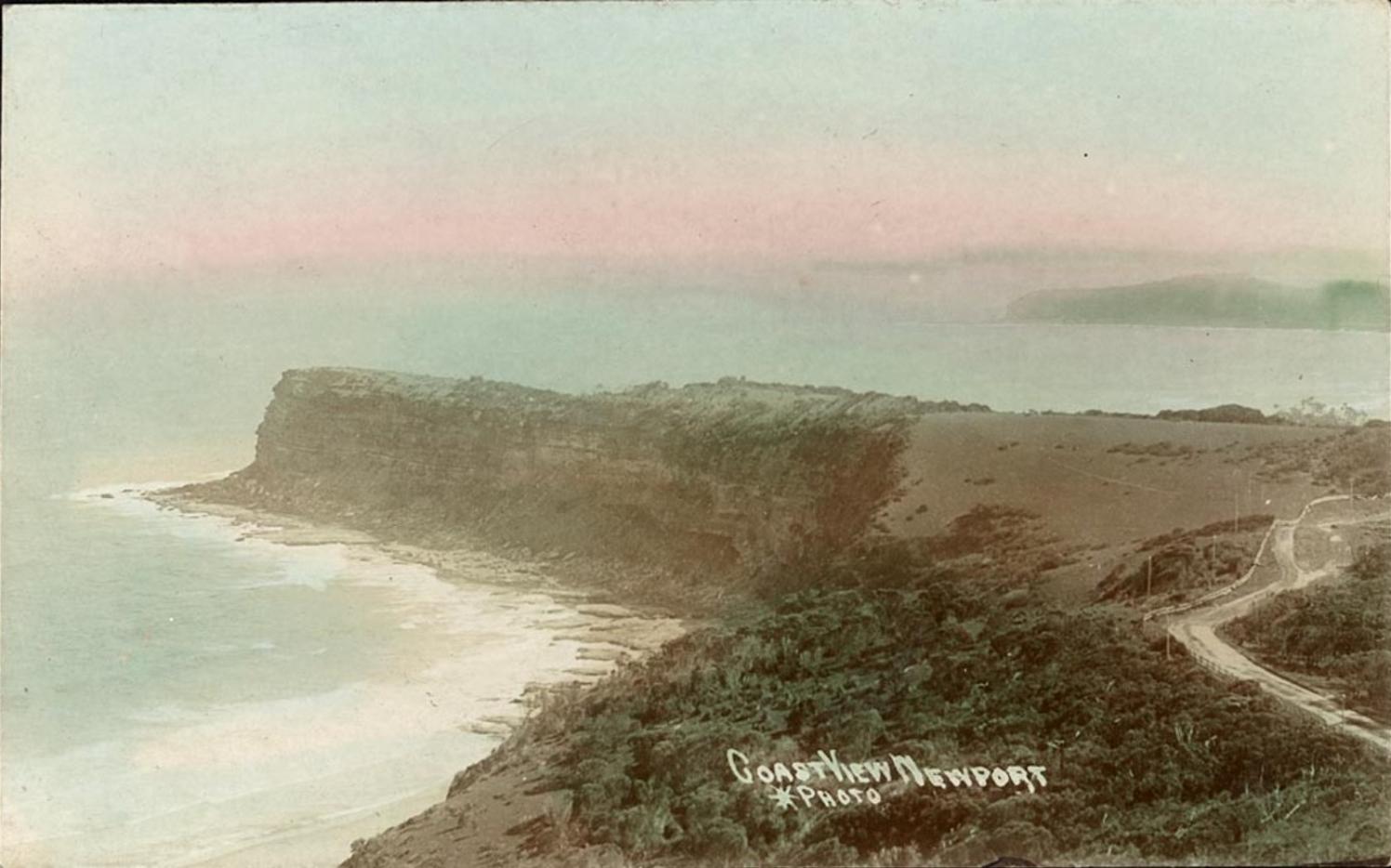
'Coast View, Newport, circa 1906/07 - ca. 1900-1927, Sydney & Ashfield : Broadhurst Post Card Publishers, courtesy State Library of NSW
References and extras
- TROVE - National Library of Australia
- State Library of NSW
- State Library of Victoria
- Pittwater Roads II: Where The Streets Have Your Name - Bungan Beach
- Pittwater Roads II: Where The Streets Have Your Name - Newport - Gellatly bought land around Calvert Parade in 1906 as well. His father James, Arthur and he also held land at Willoughby and Neutral Bay
- Pittwater Roads II: Where The Streets Have Your Name - Mona Vale, Bongin Bongin, Turimetta and Rock Lily
- Pittwater Roads II: Where The Streets Have Your Name - Great Mackerel Beach
- Pittwater Reserves - The Green Ways Bungan Beach and Bungan Head Reserves: A Headland Garden
- Roads In Pittwater: The Barrenjoey Road
- The Oaks - La Corniche - Mona Vale
- A Visit To Bungan Castle By ABHS - 2018
- Pittwater Reserves: The Green Ways; Mona Vale's Village Greens A Map Of The Historic Crown Lands Ethos Realised
- Pittwater Roads II: Where the Streets Have Your Name - Newport Beach.
- Cooinoo, Turramurra [photograph] images available at Caroline Simpson Library & Research Collection.
- Bungan Beach and Waters
- Opportunity To Visit Submarine War Grave Renews Memories Of 75 Years Ago - 2017
- The Origins of the CSIRO: https://csiropedia.csiro.au/wp-content/uploads/2015/12/Origins-of-CSIRO-9780643105553_WEB.pdf
ON BUSHRANGER'S HILL
by THE SPECTRE
Rest, and be thankful. On the verge
Of the tall cliff, rugged and grey,
At whose granite base the breakers surge,
And shiver their frothy spray,
Outstretched, I gaze on the eddying wreath
That gathers and flits away,
With the surf beneath, and between my teeth
The stem of the "ancient clay."
" Here you are," said our guide, " here's where the bushrangers used to come and hide in the old days."
The bushrangers showed good taste, truly, in their selection of a retreat, though it is hardly likely that artistic considerations influenced them in their choice. The knowing old hands - the men who had run the old gamut of villainy and were now being hounded down again by the law - only chose the resort because of the commanding view of the country all about. Lying perdu here they could keep their eye on the whole coast from Port Jackson to Broken Bay ; the track to Newport ran almost under their nose, and, given a proper watch, a surprise was impossible. So the bush- rangers' hill became famous in the convict days, and from all parts of the country the men who had taken to the bush drew toward the lonely eyrie. Then, when the place began to get unwholesomely crowded, the troopers would make a rush; but long ere they could reach the hill its occupants would be gone, and nothing but a smouldering camp fire left to mark the spot. Some old hand, doubtless, standing where the trigonometrical cairn now makes a black mark against the sky, had seen the heliograph-like flash of the troopers' swords hours before; had watched the little band as it forded the Narrabeen Lagoon, and long before it could even reach the track which leads up to the foot of the hill, had given the alarm signal which had once more scattered his mates all over the bush.
The process must have been repeated many times, and so, years after, when a scanty fringe of settlement began to creep up and around Pittwater, and to dot its indented shores with little flower-covered homesteads, the place kept its name. And then in later days a man, armed with a theodolite and a compass, and various other mathematical instruments, struggled up the top of the mass of rock. He also found the commanding position of the hill of value, though he acted from motives far different from those which guided the old bushrangers. He simply wanted a prominent point to form the apex of one of his primary triangles, a point which could be looked up to and its angle measured for miles around. So, to make sure of the point, and to prevent any blundering surveyor measuring the angle subtended by the wrong piece of rock, he planted a stout pole, having a pyramidical cairn of stones by way of foundation. Then he put a couple of discs, like railway following signals, on top of the pole, and went away quite contented with his work.
No one goes to the place much now ; a few city visitors sometimes find their way up the hill, and after saying "how pretty, " remark that it must be time for lunch, and so find their way down again. Even the little black-and-tan hotel dog has got tired of the hill. He wagged his tail joyfully when he saw that we were going for a walk, and even condescended, in his patronising way, to accompany us along the dusty road. But when we commenced the ascent of the hill he protested. "Can't see what you stupid people want to climb the hill for on a hot day like this. There's nothing at the top except some ugly rocks, not even a 'possum or a wallaby to chase. Besides I've been there before." So he wagged his little tail and set out on his own account. When we came back to the hotel a few hours later he was quietly resting in the shade of the doorway. "I told you so," he said as he gave us greeting. " Hope you'll take my advice next time."
The absence of the dog, however, did not prevent us toiling steadily up through the tangled masses of fern and flannel flower, till we reached the cairn at the top. It is a pleasant place to sit and think whilst the dull boom of the breakers makes muffled music right under your feet, and the kingfishers flash brightly to and fro in the branches all round. There is a grandeur about the shore line as seen from this bird's-eye point of view. From Barranjoey to the Heads the coast stretches, not straight, but in a series of noble curves fringed with a shining line of yellow sand, and a glistening white circle of breakers. Here and there the reefs jut (with long finger-like points) provokingly out into the blue waters, and the sea lashes at them impotently, sending up clouds of white mist over and around those immovable rocks. It is an old story, as old as the world. For ages the sea, lazily sending in its breakers one after the other, has been striving against those rocks, and for ages the rocks, secure in their position, have declined to move out of the way. The sea is in a quiet mood today. The long blue Pacific rollers are gentle, almost languid in their movements, and they break on the rocks with a deprecating couldn't-help-it kind of an air. They are no longer angry with the rocks, a truce has been patched up, a truce which may last for a day or two at the most, until Mr. Russell sends along another storm, and all is again commotion. The water inside the narrow sand line which forms the lagoon has undoubtedly the best time of it. Nothing makes much difference in this sheltered quarter. Whether it be storm or calm outside, the lagoon remains smooth and peaceful. At intervals, indeed, the sea forces a passage through the sandy barrier, but beyond agitating the water inside a little, no great harm is done. It is curious, indeed, the habit which this Narrabeen Lagoon has of opening and closing its own entrance, sometimes shutting itself off entirely from the sea, as if it aspired to become an inland lake, and at other times admit- ting the great waters freely until it becomes little else but an arm of the sea. Further on still, one can just see the great white college at Manly clearly outlined against the black background of the North Head, and beyond this again the houses of Vaucluse shine out on the southern side of Sydney Harbour. All is clear and bright and distinct as it ought to be on such a day, when the southerly gale of the last week has consented to leave off blowing for a while, and all nature is taking a well-earned rest.
But to leave the ocean and turn round. There is water on this side as well. Not the rough blue heave of the ocean, but the quiet calm of an inland lake. It is Pittwater, that highly-favoured arm of the sea, sheltered in such a way as to be a lake in all but the name. The narrow peninsula slopes sharply down to the water's edge, and the little blue lake extends before us for miles, until at last it seems to turn the corner and disappear, going far away north to meet the ocean again in the stormy Broken Bay. There are tiny ships on this lake -small coasting schooners, which come round here at intervals and load firewood for Sydney. You can see piles of this wood stacked along the bank, waiting until it can be taken off in a primitive fashion to the vessels which are anchored a short way from the shore.
The houses are few and far between, and for the most part have a comfortable old settled look, hidden away as they are beneath the masses of almost tropical vegetation. And behind, the orchards slope chequer-board fashion up the green hillsides. At the far end of the bay, where one sees two or three cottages grouped rather closely together, an attempt is being made at settlement on a new plan. The owner, by subdividing his property and selling it in allotments, is trying to gather round him a little artistic colony. Here he hopes the men who wield the brush and the pen will make for themselves homes and create a new art centre. The idea is a happy one, and nature, as if in accord with it, has done her best to make the place of settlement beautiful. She has provided picturesque gullies, full of ferns and palms, and has even laid on a waterfall a couple of hundred feet high. All that is wanted now are a few red-roofed chalets, peeping out from among the foliage, and these, I suppose, will come in time. One artist, indeed, has already built himself an ingeniously designed dwelling - something between a Norwegian hut and a Swiss chalet. Others will doubtless follow, when the public learns the value of local art and extends it a full measure of patronage. For this sort of elegant rusticity, though very pretty and pleasant to look upon, requires a good deal of money, the very thing which artists, as a rule, are lacking in. So the settlement - for the present at any rate - progresses but slowly, and artists, when they want a spell in the country, have to be content with the old-fashioned log hut, leaving tiled roofs and gable ends to the capitalist who can afford to indulge in such luxuries.
There are plenty of other things to be seen from the top of the hill, and though the view at present lacks animation, one can easily pardon this fault for the sake of the peace and quietude all around. Some day, perhaps - one can only look forward with dread to the time - Pittwater, now such a happy smiling inlet, will be the centre of a rushing, bustling, commercial activity. The banks will be covered with wharfs, and the smoke of factories will pollute the pure air of the bush. At present one little steamer weekly suffices to take away all the produce grown in the neighbourhood, and to bring up all the supplies needed by the few fruit-growers who have settled around the shore. But as time goes on this must alter. There is abundance of rich land available, there are miles of deep-water frontage, and there is a harbour practically unlimited in size, and unrivalled for safety. So that, as far as one can see, there is nothing to prevent Pittwater from going ahead, and the hill which the bushrangers loved to frequent may one day overlook a busy city. ON BUSHRANGERS' HILL. (1891, November 28). The Sydney Morning Herald (NSW : 1842 - 1954), p. 5. Retrieved from http://nla.gov.au/nla.news-article13868244
THE CONTRIBUTOR
A GLORIOUS OUTLOOK NEAR SYDNEY.
BY A QUEENSLANDER.
I have visited all the environs of Sydney, stood on all the principal points of vantage, and viewed a multitude of beautiful scenes from commanding hills. Therefore, my opinion as an absolutely impartial observer on what appears to me as the grandest views from any point within ten miles of Sydney, may be of some interest.
The spot to be indicated appears to have been comparatively unknown and neglected by the tourist, the picnicker, and the citizen in search of a perfect suburban site. Allured by the tram or ferry facilities, or fascinated by wily auctioneers' advertisements, Sydney people have been artfully led away to all points of the compass, sometimes to create new suburbs where the auctioneers' 'Pactolian streams rippling over silver sands' proved to be inglorious muddy ditches meandering slowly to the swamps; and the sun-clad heights, that on every new morn 'grew radiant with the glory at the dawn,' became in reality mere masses of barren sandstone, suitable only for a Troglodyte or the crazed hunters who desired to 'catch the wild goat by the beard and hurl their lances' — or a brickbat — in the sun.
We shall go to Manly by the steamer, and land on that historic beach named by Governor Philip. About four miles beyond Manly, on the road to Newport and Pittwater, we arrive at a locality remarkable historically and geographically. A sandstone tableland, covered by heaths and honeysuckle and astonishing profusion of wild flowers, slopes gently upward to a commanding eminence 489ft above sea level. On the crest of that hill is the Manly Trignometrical Station, chosen for its altitude and the vast expanse of country which it overlooks.
From this hill, and the sloping tableland can be seen the most magnificent of all the scenes around Sydney. This is due entirely to the unique geographical position of that plateau which stands happily on the spot that commands the largest area of the splendid panorama of sea and land. The view includes far south to Bondi, Coogee, and Botany. At Bondi and Coogee the surf lies apparently motionless, like great snow wreaths, at the foot of the dark cliffs. Nearer to us, the waves break in white foam on the grim sandstone crags of the 'Gap' and South Head. There is seen the harbour in and about South Head and Watson's Bay; the noble entrance; the scrub-covered slopes on North Head, and the township of Manly, with its white and red tiled houses, nestling calmly in the bosom of a wave washed peninsula. The long white beach ends where Curl Curl headland vibrates to the thunder of the surge, and behind and under the shelter of that headland sleeps, the Curl Curl lagoon, shooting its long arm far up among heath-covered I swamps and green gardens. Then the second beautiful bay ending in the rocks of Deewhy Point which curves into that third beach, behind which slumber the blue Deewhy and Manly lagoons, the old favoured home of the swans, 'Deewhy' and 'Marroo.' Deewhy point was known to the blacks as 'Arragong,' the name of the hardwood shield.
Beautiful
Beautiful beyond description are the ever changing marine colours on Deewhy beach, seen from the crest of the hill. The long white sand bars guard the lagoons from the over ocean, as a mother's bare arm stretched forth to save her child. The white foam on the beach merges into bright green, growing darker as it fades into light blue, dissolving into dark blue, finally lost in the measureless azure of the vast ocean stretching away to the horizon. Next is the majestic far-flung headland of Long Point, the 'Carrowang,' or 'long Nulla' of the blacks, with its projecting reef of hardstone rocks swept by the dangerous 'long rollers' marked on the old charts, the reef on which the 'Collaroy' was wrecked. Beyond 'Carrowang' sweeps the magnificent Collaroy white beach to a headland known to the blacks as 'Warrigalba,' a place frequented by 'warrigals,' the name of the dingo.
Beyond that point is a small beach ending in Narrabeen Head, the 'Guarrabeen' of the blacks, the name of the honeysuckle. Beyond these are two more romantic headlands, and then the sheer precipice of Bungy Head with its grey, white, and yellow sandstone, at the foot of which lie confused enormous boulders, torn down by the wild surf that has assailed the rugged rock fortress since a dark unrecorded morning when man was not.
This wild foreland received its present name in 1815 from the blacks who called it m 'Bung-gie Bung-gie' their name for a musket and the noise of the report, because ten of their people were shot there by a party of soldiers sent out to bring in a convict man and woman, Ben Squires and Jane Dalton, who had lived at peace with the blacks for five years.
Behind 'Bung-gie Bung-gie' rises 'Bushrangers Hill,' the 'Bannaweera' of the blacks, from 'banna' rain and 'weera' bad, literally much rain, or a bad place for rain. This is the site of another trignometrical station, the height of which is 221 feet. Beyond 'Bung-gie' is Bulgolo Head, and also the bays and headlands ending in the lofty promontory of Barrenjoey, and beyond that the dark blue outline of the Three Capes. Looking still further, we see the hills of the Barrenjoey Peninsula, all the hills of Kuringai Chase, the blue and beautiful harbour of Pittwater, all the hills in which that harbour is embosomed, all the grey and green hills ribbed with grey and white standstone stretching west, the blue Narrabeen Lake and the hills by which it is encircled— all these are spread before you in the north and west head eastern view from that remarkable hill only four miles from Manly.
Look south once more, and you see the whole city of Sydney from the South Head to the heights of Balmain. And far away in the background, out on the horizon, rises that once dark, mysterious range that barred the white man's pathway to the interior, where 95 years ago the vast solitude was first trodden by Wentworth, Blaxland, and Lawson. That range seems to 'watch and wait always' and to-day It has the same colour that suggested the name by which it shall ever be known, the 'darkly, deeply, beautifully blue in which those mountains appear from the crest of the Manly hill. Now we come to the historic romance of that sandstone-covered Beacon Hill. In the year 1795 or 1796 a transport called the Britannia came out with convicts, among whom as a, young red-headed Scot named Wilson, who escaped a month after he landed, and finally trusted himself among the blacks from Manly to Pittwater. A man with red hair was safe among any tribe of Australian wild blacks. Wilson lived for years with the blacks, who called him 'Boonbooi' and 'Moojellba,' from Moojell, red. When he came in and surrendered he was naked, and tatooed with the 'wirroong' and 'cong-arri' scars (the 'Moolgarra' of Moreton Bay). The Governor made use of Wilson's aboriginal knowledge of the country and the blacks, and sent him out with exploring parties. Wilson shot the first known specimen of the lyre bird (Menura superba) somewhere in the Illawarra district. Finally after many adventures he took a woman from the Pittwater tribe without her parents' consent, or even her own, trusting that his possession of a gun would save him. Her relatives followed, caught him in the embraces of his dark Diana, and killed him. The Manly hill was Wilson's favourite lookout. From there he could see signal fires made by convict confederates north to the Hawkesbury and Barrenjoey, and south to Sydney and Botany.
On the tableland coming down from the hill, on a level spot, is the site of a once favourite corroboree ground, and the Deewhy headland, the site of an ancient bora circle. Boonbooi's lookout was used for the same purpose by the blacks. At this spot during a corroboree he would meet such a well known old-time blacks as Colbee, Mooroobra, Booroowanyee, Yemerrawanni, Beemulwy, Boonggarie, and the famous Benillong, whom the Governor took to England, and brought back in H.M.S. Reliance. Think of the wild, weird scenes on that tableland a hundred years ago. The wild men dancing in the firelight and singing, while the wild women beat time on the stretched opossum rug or on the hollow thighs. Around them the dark rocks and the silent trees, with no other sound save that of the incessant moan and wail of the sea, where the waves died on the beach or dashed themselves on the rocks and over all heaven's azure roof, studded with silver stars. Today that old wild race is gone. The white man looks from Boonbooi's hill, where the eagle eye of the savage once scanned the far horizon for the smoke of the signal fires, and sees, not the bark canoes and the dark spearmen watching the track of the fish, but mighty steamers going and coming to and from all the nations of mankind, and the white-winged ships that in the words of Kendall, 'look like sheeted spectres fading down the distant sea.' He sees the children sport upon the shore, And hears the mighty waters rolling evermore. But who shall explain how that look-out of Boonbooi, or Moojellba, has wisely been made a reserve, and so escaped the speculator, the land agent, and the auctioneer, who could have exhausted all his eloquence and pictorial art, and still been far short of the reality? And how is it that there is not a tram from Manly to Newport, and hundreds of people settled along that beautiful coast? That is to a visitor a truly astounding conundrum. That surely must soon be the popular route to and from the Hawkesbury and Pittwater, the most attractive of all your tram routes and seaside resorts, and Sydney's most beautiful marine suburb.
On my first visit to Beacon Hill I was accompanied by W. B. Dalley, B. D. Morehead, and two English visitors. Dalley objected to the climb, and expressed a wish for the wings of Pegasus, or even those of Daedalus and Icarus. Once on the summit he expressed himself in raptures, declared it was a suitable site for the temple of an Australian Diana, and that no meaner beverage than nectar or nepenthe should be quaffed there. The nepenthe on that occasion was made in Scotland. Today a majestic palm stands on the shores of a serenely beautiful little bay between Bungan and Bulgolo points to mark the spot where Sydney's eloquent and classical son sought the companionship of the ocean and rest from the turmoil of the city. THE CONTRIBUTOR (1909, December 1).The Sydney Mail and New South Wales Advertiser (NSW : 1871 - 1912), p. 5. Retrieved from http://nla.gov.au/nla.news-article165737545
The vocabulary of the aborigines contained quite a large number of names that pleased the white man's ear, "and a review of the title by which the meanest selections are proud to rejoice with the wealthiest stations will show that ho has been 'neither slow nor -too proud to make use of them. The following are given as typical examples: Arawatta, Burrawang, Burrawinda, Cooinoo, Cuttabunda, Langawirra, Mllla Murra, Warraweena, Wongabindle, Wingadee, and last in alphabetical order, but (thanks to Miss Ella Shields) foremost in the public eye (and ear) — Yarrawonga. OUT-BACK NAMES (1922, June 4). The Sun (Sydney, NSW : 1910 - 1954), p. 15. Retrieved from http://nla.gov.au/nla.news-article223951611
NEWPORT BEACH Picked Position
VACANT POSSESSION
Exceptionally well built all electric, Fibro Cottage sandstone foundations fine sheltered elevated block 80 x 330 beautiful views large living dining loom 20
x 13 with Esse stove, 2 bedrooms semi-enclosed Sun verandah, l8 x 1-. Shower recess kitchen laundry septic sewerage many built In cupboards bookshelves
and other 1st class fittings plastered walls and ceilings throughout Garage cement paths. An attractive home newly painted for £3000
Apply No 15778 Herald for Inspection
MONA VALE Land 68ft front Ideal posit close Wynyard bus stop Iine, passed plans £450 Private sale Tele JA3674
NEWPORT Bungan Beach Ocean Frontage New Furnished Brick Bungalow 3 br large lounge kitchen dinette tiled bath septic, h w , refrig ,£4950 7966 Herald
NEWPORT -V P 3-bed House, close beach, transport adjoining block available Also other Allotments, same vicinity Apply Meadows Surf Road Whale Beach. Advertising (1949, August 24). The Sydney Morning Herald (NSW : 1842 - 1954), p. 13. Retrieved from http://nla.gov.au/nla.news-article18125767
Real Property Act: No. 35,148. Elizabeth Denchfield, 2 ac. 3 r. 24 ¾ p;. lots 1 to 6 Inclusive, Sec J, Township of Newport, corner of Gladstone and King sts., Newport. Advertising (1945, December 8). The Sun (Sydney, NSW : 1910 - 1954), p. 5 (LAST RACE). Retrieved from http://nla.gov.au/nla.news-article229029363
PHIZACKERLEY.-July 18, 1940, at his residence, Bungan-ridge, Newport, Isaac, dearly loved husband of Esther Adeline Phizackerley, aged 79 years. Melbourne and Tasmanian papers please copy. Family Notices (1940, July 19). The Sydney Morning Herald (NSW : 1842 - 1954), p. 6. Retrieved from http://nla.gov.au/nla.news-article17691471
Hambones
Sir.—In your last issue of your magazine you mentioned that "hambones" originated from the board riders of Bungan Beach. The only two boardriders who frequent Bungan are both locals and being one of these two locals I can assure you that neither of us has done hambones nor knows anything about them originating at our beach. The boardriders that you mention are eggs that sleep behind the sandhills and tht;ow parties, but definitely cannot ride. Incidentally if you decide on throwing a keg turn on Bungan. think twice, as the police are now burning the lights on the beach every Saturday night. EOLMOS. and again... (1964, March 26). Tharunka (Kensington, NSW : 1953 - 2010), p. 4. Retrieved February 3, 2021, from http://nla.gov.au/nla.news-article230412228
Francis Mephan Gellatly
Francis Mephan Gellatly (1872-1919), journalist and publicist, was born on 13 November 1872 at Ballarat, Victoria, eldest son of James Gellatly, a London-born lithographer, and his Scottish wife Christian née Ferguson. He was educated at the Church of England Grammar School, Ballarat, and at The King's School, Parramatta, New South Wales. In 1891 Gellatly joined the New South Wales Forestry Department as a cadet working in the Gosford district. Within twelve months he resigned to work on the Sydney Morning Herald. In 1896, under the pseudonym 'Yarrowee', he published a slight novel, Back from the jaws of death, in which he examined injustice within the legal system as a result of 'maladministration of the Law, the perversity of judges, or the stolidity of juries'.
Gellatly bought land around Calvert Parade at Newport in 1906 as well. His father James, Arthur Gellatly and he also held land at Willoughby and Neutral Bay.
Visit: Pittwater Roads II: Where The Streets Have Your Name - Newport
C. THE KING'S SCHOOL PARRAMATTA.
Francis Mephan Gellatly.—Geography, A ; English, B ; French, C ; Latin, C ; arithmetic, C ; geometery, B; Botany, B. University of Sydney. (1890, October 11). The Cumberland Argus and Fruitgrowers Advocate (Parramatta, NSW : 1888 - 1950), p. 4. Retrieved from http://nla.gov.au/nla.news-article86266442
In 1899 he married:
GELLATLY—JONES.—March 30, at North Sydney, by Rev. W. M. Dill Macky, Francis Mephan, eldest son Mr. James Gellatly, to Agnes Mary, eldest daughter of the late Mr. Edwin Jones, of Wellington, N.Z. Family Notices (1899, April 22). The Sydney Morning Herald (NSW : 1842 - 1954), p. 1. Retrieved from http://nla.gov.au/nla.news-article14210464
Children of the Union:
GELLATLY VIVIEN F 35692/1901 FRANCIS M AGNES M ST LEONARDS
GELLATLY DOROTHY M 6966/1903 FRANCIS M AGNES M ST LEONARDS
GELLATLY RUSSELL 39877/1907 FRANCIS M AGNES M ST LEONARDS
GELLATLY LINDSAY 40472/1908 FRANCIS M AGNES M ST LEONARDS
GELLATLY JEAN 32708/1914 FRANCIS M AGNES M ST LEONARDS
He passed away while quite young as a result of contracting pneumonia and influenza in 1919 - one of thousands who lost their lives prematurely to this in the wake of World War One:
Dr. Gellatly Dead.
Dr. F. M. Gellatly, Director of the Federal Institute of Science and Industry, died at Neutral Bay this morning from pneumonic influenza, aged forty-seven. Until April last deceased was financial editor of the Sydney Morning Herald. Dr. Gellatly Dead. (1919, September 25). Goulburn Evening Penny Post (NSW : 1881 - 1940), p. 4 (EVENING). Retrieved from http://nla.gov.au/nla.news-article98906910
DR. F. M. GELLATLY.
DEATH IN SYDNEY.
DIRECTOR OF SCIENCE INSTITUTE.
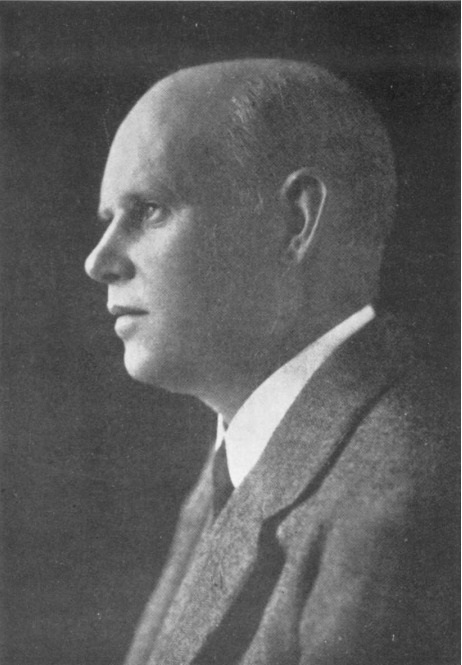 Dr. Francis Mephan Gellatly, Director of the Institute of Science and Industry, passed away at North Sydney at 4 o'clock yesterday morning.
Dr. Francis Mephan Gellatly, Director of the Institute of Science and Industry, passed away at North Sydney at 4 o'clock yesterday morning.
Dr. Gellatly contracted pneumonic influenza a little over a week ago, probably on his way from Melbourne, and, although- he possessed an unusually robust constitution, he was un-able to resist the progress of the disease, and his condition rapidly became critical. He was 46 years of age, and is survived by his wife, formerly Miss Agnes Mary Jones, two sons, and three daughters. His parents also survive him.
A wide experience in journalism, principally on the commercial side, and an advanced legal education, provided Dr. Gellatly with an excellent mental equipment for the responsible position of Director of the Instituto of Science and Industry, to which he was appointed by the Commonwealth Government in April last year. The scope of the work carried on by the institute is far-reaching, and his outstanding abilities were applied with great energy in its organisation and development. The main object of the institute is the initiation of scientific research in connection with, or for the promotion of, the primary or secondary industries of the Commonwealth. A vast amount of detail work has been Involved in placing such an undertaking upon a firm basis, involving, as it does, the establishment of laboratories at different centres in the Commonwealth, the promotion and utilisation of existing institutions, and the building up of the most competent staff available for the carrying out of the re-searches. " By hard work and much travelling in different parts of the Commonwealth, Dr. Gellatly accomplished a great deal in a short space of time. Concurrently investigations have been carried out in various directions, some of which have already yielded important results, as has been shown from time to time in speeches delivered by Dr. Gellatly before the Chamber of Commerce and other bodies. A consideration which Dr. Gellatly lost no opportunity to emphasise, and one which he kept constantly before him In establishing the work of the Institute of Science and Industry as rapidly and effectively as possible, was the influence which it should have in placing the Industries of Australia upon an equal, and, if possible, advantageous basis of competition with those of other countries. It was ¡provided that in his capacity of Director of the Institute, Dr. Gellatly should act as chairman of an executive council of three, the other two members being scientists, thus leaving him the connecting link between science and industry.
Prior to his appointment as Director of the Institute of Science and Industry, Dr. Gellatly had been financial editor of the "Sydney Morning Herald" for over twelve years. He was a Doctor of Laws of Sydney University, and a barrister-at-law of the New South Wales Bar of about seven years' standing, but had never practised. He was a native of Ballarat, and was educated at the Church of England Grammar School, Ballarat, the King's School, Parramatta, and the Sydney University. In 1891 he joined the New South Wales Forestry Department as a forest cadet under the late John Ednie Brown, and in this capacity he helped to clear, grub, burn off, and plant the Gosford State Nursery, afterwards performing similar services for the Jilliby Jilliby plantation in the Wyong district.
Shortly afterwards he entered journalism. He joined the "Sydney Morning Herald" staff in 1893, and, with a short interval during part of which he was a member of the Sydney actuarial staff of the Equitable Life Assurance Society of the United States, he remained on the "Herald" staff till last year. In 1903. upon the retirement of Mr. Peter Proctor, whose associate he had been for 10 years, Dr. Gellatly became financial editor of the "Sydney Morning Herald." It was while holding this appointment that he entered the law school of the University, and he took the degree of Bachelor "of Laws (LL.B.) in 1912. The same year he proceeded to Great Britain and Europe, returning after a tour extending over six months, via the United States. While in England he had the advantage of meeting several distinguished financial journalists, including Sir George Paish, joint editor of the "Statist," and Mr. Hartley Withers, now editor of the "Economist." Each of these gentlemen at different periods of the war was financial adviser to the British Government. Shortly after his return, Dr. Gellatly was called to the Bar. After an Interval he determined to read for the degree of Doctor of Laws, and in 1916 he was successful in taking that degree, his immediate predecessor being Dr. Waddell, upon whom It was conferred in 1903.
As financial editor Dr. Gellatly was a severe critic of prospectuses of ventures which asked on slender grounds for the support of public money, and, in many instances, he had the satisfaction of knowing that his Judgment was confirmed In the subsequent working of the companies against which he had warned the people.
Amongst the war-time contributions to the Press by Dr. Gellatly which attracted particular notice were three series of articles, one on s "High Finance," the second on repatriation, and the third ventitled "Big War Deals." The three series appeared in the columns of the "Sydney Morning Herald."
Dr. Gellatly was for some time a vice-president of the New South Wales Institute of Journalists, chairman of the New South Wales Journalists' Board of Advice, and a member of the War Savings Council.
The funeral will take place this morning at Gora Hill Cemetery.
MELBOURNE, Wednesday.
The Prime Minister, Mr. Hughes, to-day, on behalf of the Federal Ministry, sent a telegram of condolence to Mrs. Gellatly. DR. F. M. GELLATLY. (1919, September 25). The Sydney Morning Herald (NSW : 1842 - 1954), p. 6. Retrieved from http://nla.gov.au/nla.news-article15864196
PRIME MINISTER'S TRIBUTE.
"The news of Dr. Gellatly's death came as a very great shock to me," said the Prime Minister (Mr. Hughes) to-night. "The shock was the greater because he travelled over to Sydney/ with me recently, and was then apparently in excellent health. In Dr. Gellatly the Commonwealth has lost one who had the capacity and the will to do splendid service to Australia. He was wonderfully keen on his work, which he told me the other day was the most Interesting 'job' in the world. Personally, Dr. Gellatly had been a close and Intimate friend of mine for nearly a quarter of a century. With my regret that Australia should lose one who would have done her such good service there mingles, therefore, regret at the loss of a friend." PRIME MINISTER'S TRIBUTE. (1919, September 25). The Sydney Morning Herald (NSW : 1842 - 1954), p. 6. Retrieved from http://nla.gov.au/nla.news-article15864169
DR. F. M. GELLATLY.
FUNERAL AT GORE HILL.
The large and representative gathering at the burial of Dr. Francis Mephan Gellatly, Director of the Commonwealth Institute of Science and Industry, at the Gore Hill Cemetery yesterday morning was the last simple tribute to a man whose name will always live affectionately in the hearts of those among whom he moved. About him there was just that quiet charm that endeared him to troops of genuine friends. Only a few yards from his grave is the last resting place of Mr. Peter Proctor, who was Commercial Editor of the "Sydney Morning Herald" many years ago, when young Gellatly was his assistant, prior to becoming his successor. Their personal association was a lifelong one.
"The Commonwealth," said the Rev. R. H. Waugh, M.A., of the Neutral Bay Presbyterian Church, in officiating, "is the poorer for the untimely passing away of Dr. Gellatly. This large gathering reflects the genuine esteem in which he was held. He was a man of brilliant gifts, and one whoso sunny, genial disposition won for him many friends in all classes of the community. There was his brilliant University career, the distinctive place that he occupied in Journalism, and the high post for which the Commonwealth Government had chosen him to work which he was assiduously developing, and to the broadly useful results of which he was looking forward with such Interest. The Commonwealth has lost a good servant, and all those who know him a dear friend. Our sympathy goes out to those who have been so suddenly bereaved by his death-his aged parents, his widow and children, and others in his family circle."
The chief mourners at the graveside wore Mrs. Gellatly (widow), her daughters, Viva and Dorothy, and her sons, Russell and Lindsay, Mr. Jas. Gellatly (father), Mr. Arthur Gellatly (brother), Mrs. Stone (sister-ln-law), Mr. Arthur Jones (brother-ln-law), Miss Gellatly (cousin),'and Mr. R. Farr (Mrs. Gellatly's cousin).
Others at the graveside included Mr. J. 0. Fairfax (representing John Fairfax and Sons, Ltd., proprietors of the "Sydney Morning Herald" and "Sydney Mail"), members of the "Sydney Morning Herald" staff, Mr. H. E. Dadswell (representing Mr. W. G. Conley, General Manager)', Mr. J. Macgregor (representing Mr. C. Brunsdon Fletcher, Editor of the "Herald," and the editorial staff), Mr. H. K. Williams (Financial Editor), Messrs. C. Theakstone, Percy S. Allen, G. Marr Thompson, A. P. Cooper, A. R. Wilkie. J. E. Davonport, R. J. D. M'Callum, A. Miller, A. H. Stuart, H. Downey, R. A. Henderson, and A. T. Shakespeare, (representing the literary staff), and the following others, representing other branches of the "Herald," as well as ex-employees: Messrs. Arthur Cooper, J. K. Small, C. E. Richards, A. Semple, J. R. Pegg, Geo. Brown, Wilson J. Balley, and W. Stanley Hall.
Others present were Captain Niesigh (representing the Premier, Mr. Holman), Mr. T. W. Heney and Mr. T. W. Spencer (president and Bon. secretary respectively of the New South Wales Institute of Journalists, of which Dr. Gellatly was an ex-vice-president), Professor Douglas Stewart, Professor Watt, Mr. F. Levenger, and Mr. F. B. Guthrie (representing the New South Wales Advisory Council of the Institute of Science and Industry), Mr. C. C. Faulkner (representing the Australian Journalists' Association and the New South Wales Journalists' Board of Advice, of which latter body Dr. Gellatly was first chairman), Mr. H. W. Peters (chief of staff, "Daily Telegraph), Mr. 0. W. Todd ("World'a Nowa"), Messrs. A. A. Dunnlellft and E. Furley ("Dally Telegraph"), Mr. Robt. Nail, Mr. H. J. Taperell (Editor, "Evening News"), Mr. J. Gell ("Sun"), Mr. J. H. Earnshaw (representing the shipping papers), Messrs. J. R. Wallace and G. Whitney (Sydney and Melbourne Publishing Company), Mr. H. P. Williams and W. T. Albert ("The Land" newspaper), Professor Peden, M.L.C., ,-and Messrs. W. Mollinn and A. E. Gigney (representing the Lodge Athenaeum), Mr. H. F. Ward (Messrs. W. E. Ward and Co., York-street), Mr. E. Allen (Country Press Association), Mr. W. II. O'Malley Wood (Saving Bank Commissioner), Mr. B. Millin (secretary, Royal Exchange), Mr. C. W. Bridge, of Maitland (Professional Photographers' Association), Mrs. E. Lang, and Messrs, Jas. Bull, Ernest Blackwell, Geo. Giles, Carlton Boyce, II. C. Mitchell, A. MacQueen, R. H. K. Wood, A. W. Jones, and H. Haege.
Among the wreaths that were laid on the grave were noticed tokens from John Fairfax and Sons, Ltd., from the employees in the different departments of the "Sydney Morning Herald," "Old Comrades," "Daily Telegraph," the Premier (Mr. Holman), Mr. and Mrs. H. K. Williams, Mr and Mrs. G. J. Reeve, Mr. and Mrs. R. J. D. Mccallum, the Commonwealth Instituto of Science and Industry, the Country Press Association of New South Wales, the Worshipful Master and members of the Lodge Athenaeum, and Mr. Wood. DR. F. M. GELLATLY. (1919, September 26). The Sydney Morning Herald (NSW : 1842 - 1954), p. 7. Retrieved from http://nla.gov.au/nla.news-article15844127
In the Supreme Court of New South Wales.
PROBATE JURISDICTION.
Ill the will of Francis Mephan Gellatly, late of Ben Boyd road, Neutral Bay, near Sydney, in the State of New South Wales, doctor of laws, deceased.
PURSUANT to the "Wills, Probate and Administration Act, 1898," and the "Testator's Family Maintenance and Guardianship of Infants Act, 1916" : Notice is hereby given that every creditor or other person having any claim against the estate of Francis Mephan Gellatly, the abovenamed deceased, who died on or about the 24th day of September, 1919, and probate of whose will was, on the 3rd day of December, 1919, granted by the Supreme Court of New South Wales to Agnes Mary Gellatly, of Neutral Bay aforesaid, widow of the said deceased, is hereby required to send particulars in writing of such claim to the said Agnes Mary Gellatly, in care of the undersigned, at the office hereunder mentioned, on or before the 30th day of June, 1920, at the expiration of which time the said Agnes Mary Gellatly will proceed to distribute the assets of the said deceased amongst the persons entitled thereto, having regard only to the claims of which she then has notice; and notice is hereby further given that the said Agnes Mary Gellatly will not be liable, for the assets or any part thereof so distributed, to any person of whose claim she shall not have had notice at the time of such distribution.—Dated this 18th day of May, 1920.
FRANK HERBERT SPIER, Proctor for the said Agnes Mary Gellatly, 350 George-street, Sydney. PROBATE JURISDICTION. (1920, May 28). Government Gazette of the State of New South Wales (Sydney, NSW : 1901 - 2001), p. 3185. Retrieved from http://nla.gov.au/nla.news-article222081330

The Life of Sydney (1934, May 31). The Daily Telegraph (Sydney, NSW : 1931 - 1954), p. 13. Retrieved from http://nla.gov.au/nla.news-article246442888
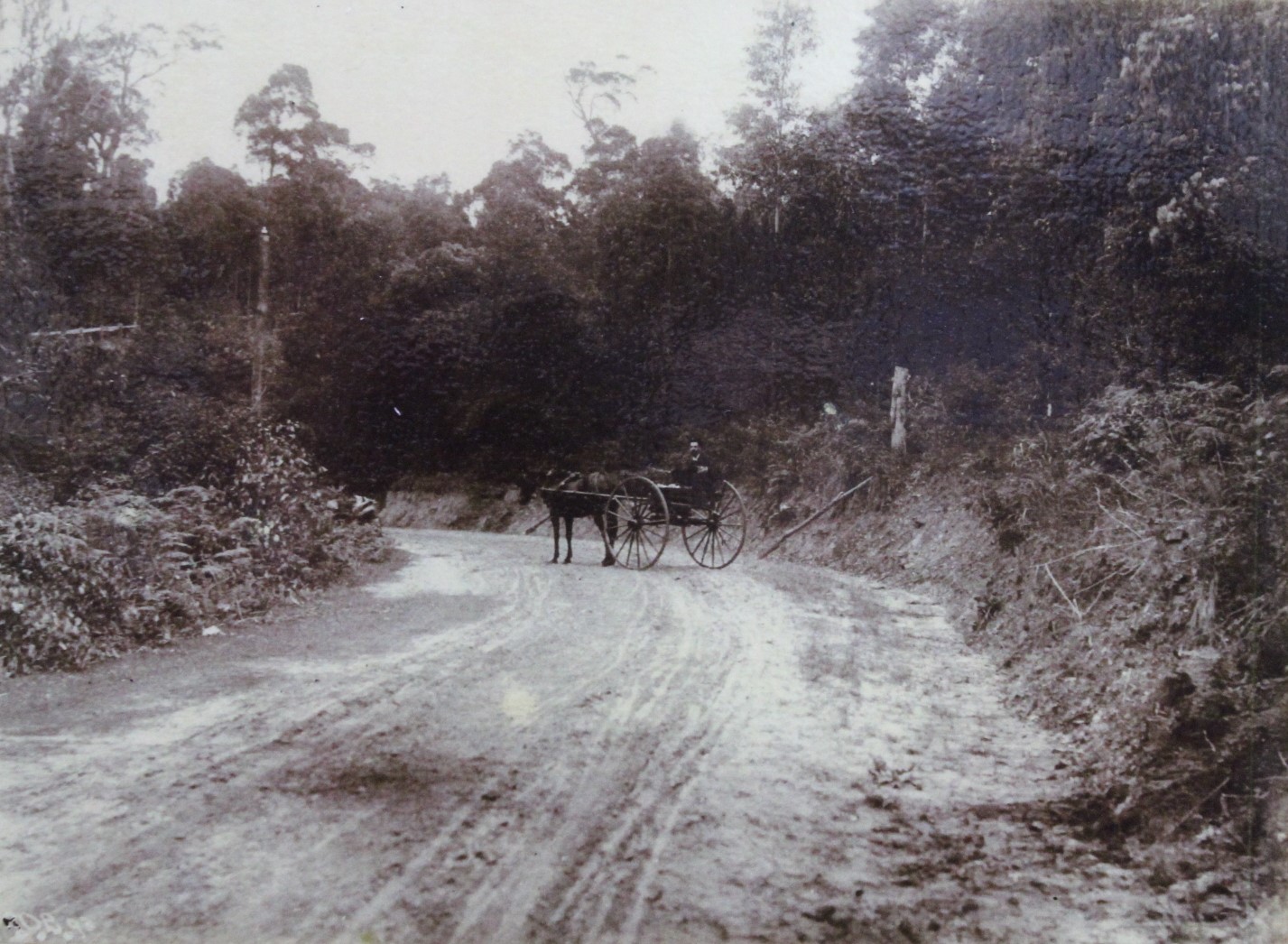
'On the Road to Newport' circa 1900 - Avalon Beach Historical Society Photo from 2018 Exhibition - possibly near the corner just prior to the 11 Mile Store - railing shown at side could be start of Hill View Crescent, Bungan Beach/Mona Vale
William John Adams
William John Adams
William John Adams (1853-1935), of Everitt, Adams and Co, 35 Queen Victoria Street, London, N.C.
1935 Obituary
WILLIAM JOHN ADAMS founded the Australasian firm of Messrs. William Adams and Company, Ltd., of which he was chairman of directors.
He was born in 1853 in the neighbourhood of the West India Docks where his grandfather, John Samuel Adams, was engineer, and he was a cousin of the late Professor Henry Adams. Mr. Adams was the son of William Adams, M.I.Mech.E., who was locomotive superintendent to the North London, Great Eastern, and London and South Western Railways successively. He became a pupil of his father at the locomotive works of the North London Railway at Bow and after five years' training he joined Messrs. Tannett, Walker and Company, of Leeds, as a draughtsman. A year later, in 1877, he was made erecting engineer, and superintended the installation of hydraulic machinery.
In 1879 he entered into partnership with his friend Mr. Percival Everitt and founded the firm of Everitt, Adams and Company, Ryburgh Works, Norfolk, inventors of the penny-in-the-slot machine. After dissolving the partnership in 1880, Mr. Adams became manager of the Vacuum Brake Company, Ltd. 1880 William John Adams was appointed manager of the Vacuum Brake Co, of Queen Victoria St, London
He left for Australia four years later, with agencies for several British engineering firms, and on his arrival there he established the firm with which he was associated for the remainder of his life.
He had been a Member of the Institution for fifty-four years, having been elected in 1881. His death occurred in Hampstead on 12th June 1935. - From: 1935 Institution of Mechanical Engineers: Obituaries
William Adams (1823–1904) WJ Adams father, was:
- Locomotive Superintendent of the North London Railway from 1858 to 1873
- Locomotive Superintendent of the Great Eastern Railway from 1873 until 1878
- Locomotive Superintendent of the London and South Western Railway from then until his retirement in 1895.
He is best known for his locomotives featuring the Adams Bogie, a device with lateral centering springs (initially made of rubber) to improve high-speed stability. He should not be mistaken for William Bridges Adams (1797-1872), a locomotive engineer who invented the Adams Axle — a radial axle box used on locomotives of William Adams's design.
Born: 1823 May 15th. Born in Mill Place, Limehouse, London, where his father (John Samuel Adams?) was resident engineer of the East and West India Docks Company.
After private schooling in Margate, Kent he was apprenticed to his father's works. The railway surveyor Charles Vignoles had previously worked on the construction of the London dock basins and this association then secured a position for Adams as an assistant in his drawing office. The final years of apprenticeship were spent at the Blackwall works of Miller and Ravenhill, builders of engines for steamships.
In 1848 Adams became assistant works manager for Philip Taylor, an ironfounder, millwright and former assistant to Marc Brunel, who had set up workshops in Marseilles and Genoa to build and install marine engines. Fluent in French and Italian, Adams soon found himself effectively the superintendent engineer for the Royal Sardinian Navy, although still nominally working for Taylor. (The Kingdom of Sardinia then encompassed Genoa and much of what is now north-west Italy.) In 1852 he married Isabella Park, the daughter of another English millwright working in Genoa, and returned to England.
On his return to England, Adams initially worked as a surveyor: considering possible routes for a railway on the Isle of Wight, overseeing construction work at Cardiff Docks and planning and equipping new workshops at Bow for the East and West India Docks and Birmingham Junction Railway, soon to change its name to the North London Railway. This led to his appointment as the company's locomotive engineer in 1854, a post he held for eighteen years. Here he introduced his noted series of 4-4-0 tank engines, the first to utilise the laterally-sprung bogie, and the first continuous train brake.
1859 Locomotive Superintendent of the North London Railway. Joined I Mech E.
1860 Resigned from I Mech E
1861 William Adams, civil engineer and locomotive superintendent, age 37, living Limehouse with his wife Isabella age 31, son William J Adams 7, Katherine A Adams 6, Isabella Adams 4, Charles Adams 2, John H Adams age 6 months.
1866 William Adams, Locomotive Superintendent, North London Railway, Bow, London. Rejoined I Mech E.
1869 Became a member of the Institution of Civil Engineers. He was also a member of the Institution of Mechanical Engineers and was a Past President of the Society of Engineers.
In 1873 Adams took up a similar position with the nearby Great Eastern Railway. There he did not well appreciate the different requirements of the line, a far-flung concern compared with the North London, and his locomotive designs for the company were found to be underpowered for main-line work. However his refitting of the company's Stratford Works using modern, standardised equipment saved a great deal of money and, when he left for the London and South Western Railway in 1878, his reputation was intact.
On the LSWR he designed and built 524 locomotives, supervised the expansion of Nine Elms Works and the transfer of the Carriage and Wagon Works to Eastleigh. Failing health forced his retirement on 1895-05-29. He lived in Putney until his death on August 7th, 1904.
1904 Obituary
 WILLIAM ADAMS died at his residence, Hillrise, Putney, on the 7th August, 1904, at the advanced age of 81 years, having seen 40 years' continuous service in the locomotive departments of the North London, the Great Eastern, and the London and South Western Railways.
WILLIAM ADAMS died at his residence, Hillrise, Putney, on the 7th August, 1904, at the advanced age of 81 years, having seen 40 years' continuous service in the locomotive departments of the North London, the Great Eastern, and the London and South Western Railways.
Born on the 15th October, 1823, he was apprenticed at the age of 17 to Miller and Ravenhill, marine engineers in London.
Subsequently he entered the service of Philip Taylor and Co at Marseilles, by whom he was employed for three years on the erection of marine engines and machinery, and in 1848 he joined the Sardinian Navy as an engineer, serving four years afloat.
Returning to this country in 1853, he was engaged by Mr. H. Martin as an assistant on various works until 1855. It was in the latter year that his long connection with locomotive engineering commenced on his being appointed to the position of Locomotive, Carriage and Wagon Superintendent of the North London Railway. While holding that post he introduced many improvements in the rolling stock under his charge, and organized and extended the workshops at Bow.
In 1873 he accepted a similar appointment with the Great Eastern Railway, with which Company he remained five years, reconstructing to a large extent the Stratford works and developing the rolling stock on the lines of his former experience, particularly in regard to the requirements of suburban traffic.
In 1878 he joined the staff of the London and South Western Railway as Locomotive Engineer, and continued in this position for seventeen years, retiring in 1895. Under his superintendence the Nine Elms Works were rebuilt and enlarged, and considerable improvements were effected in the rolling stock. Modern locomotive practice is indebted to Mr. Adams for many improvements introduced or effected by him during the course of a long and useful career.
The subject of this notice was a man of quiet and unassuming character, considerate to those under him, whose respect and esteem he enjoyed. He extended a ready support to any social and philanthropic schemes which came under his notice. especially those which promised to benefit railway servants. While at Bow he was largely instrumental in founding the Bow and Bromley Institute.
He was a Member of the Institution of Mechanical Engineers and of the Society of Engineers, of which he became President in 1870.
In 1895 he contributed to the Proceedings of the Institution of Civil Engineers, in collaboration with W. F. Pettigrew, a valuable description of 'Trials of an Express Locomotive,' carried out by them on the South Western Railway. For this Paper the Authors were each awarded a George Stephenson medal and a Telford premium.
Mr. Adams was elected a Member of the Institution on the 6th April, 1869. From: Institution of Mechanical Engineers: Obituaries - London
1904 Obituary
By the death on the 7th inst. of Mr. William Adams the world has lost another of the older school of engineers. Mr. Adams was 81 at the time of his death and he had retired from active life for several years. He filled at different times the responsible post of locomotive superintendent to the North London, the Great Eastern, and the London and South Western railways, and we do not think that we claim too much for him when we say that he was the first locomotive superintendent in the world who realised the conditions under which suburban railway traffic would have to be conducted, and provided for it accordingly. The outside-cylinder tank engines which he designed for the North London Railway may be regarded as the progenitors of the the tank locomotive, each group more powerful than the last , which are employed in every large city at this side of the Atlantic in the conduct of suburban traffic.
Mr. Adams, when his school education was completed, was engaged for two years in Mr. Vignoles' office. Subsequently he served a regular apprenticeship with Messrs. Miller and Ravenhill on the Thames. His apprenticeship over, he found employment with the English firm of Taylor and Company, of Marseilles, engine builders. Thence he entered the Sardinian Navy as a marine engineer. We next find him employed by Mr. H Martin, M. Inst.C.E. on various works, and at the age of thirty-one he was appointed locomotive superintendent of the North London Railway. After 19 years' service on that line he became locomotive superintendent of the Great Eastern Railway until 1878, when he succeeded Mr. Beattie as locomotive superintendent of the London and South-Western Railway, a post which he held until he retired in 1896 from active live.
He was one of the first British engineers to recognise the value of the bogie; and the North London Railway having curves with a radius as small as four chains, he invented and used the now well-known traversing bogie. It was illustrated in THE ENGINEER for January 12th, 1866. Across the centre of the bogie frame a stout, flat girder is fixed, on the top of this rests a casting which can slide on it. The upper surface of this casting is channelled circumferentially and in the channel is placed a heavy india-rubber ring. The flat girder is slotted in the middle to permit this casting to traverse each way about 4in. from the centre. The bogie pin is secured to the engine, and passes through a channelled casting, the counterpart of that resting on the bogie. The india-rubber ring before mentioned is compressed between the two and deadens shock. The engine is carried on three points, namely, the bogie centre and the centres of two compensating levers between the driving wheels. The advantages possessed by this bogie were so great that it became an immediate success on the North London Railway , where, indeed, many of the Adams engines are still at work. He found that considerable difficulty was encountered in preventing outside cylinders from getting loose, and he devised an arrangement by which the valve-boxes passing through the side frames constituted parts of hollow girders, so that the side frames were spared twisting stresses, the two cylinders virtually becoming one. In 1866 he brought out a standard inside cylinder engine for the North London Railway, and we illustrated that engine in our impression for March 2nd, 1866. The article accompanying this illustration may be read with peculiar interest now. The passenger coaches weighed empty only 7.5 tons each, and carried fifty passengers second class and thirty-two first class. Mr. Adams was, so far as we know, the first man out of America to employ a pressure of 160 lb. in regular railway practice, and his action was deemed by many persons as fraught with danger and altogether too audacious.
At a subsequent period he turned his attention to draught, and introduced the vortex blast pipe, which met with considerable favour.
In the introduction of minor details which would add to the efficiency or economy of a locomotive he was indefatigable. Those who knew him best will most regret him. 1904 Obituary
John Henry Adams (1860-1915) - 1860 Born in London the son of William Adams, brother of William John Adams
1916 Obituary
JOHN HENRY ADAMS was born in London on 10th September 1860. He was educated at Brighton Grammar School and Thanet College, Margate, and privately in Brussels. He began his apprenticeship in 1877 at the Stratford Works of the Great Eastern Railway, under his father, the late William Adams; and when in 1879 his father became Locomotive Engineer of the London and South Western Railway, he was also transferred to that Company's works at Nine Elms.
Upon the completion of his training he served as a fireman for nine months, and afterwards was an engine-driver of goods and passenger trains for fifteen months on the London and South Western Railway.
He then spent a year with Messrs. Tannett, Walker and Co., of Leeds, to gain experience in hydraulics. From July 1887 to September 1898 he was Locomotive, Carriage and Wagon Superintendent of the Donna Thereza Christina Railway, Brazil, and in January 1899 he became Assistant Manager of the South Eastern and Chatham Railway. Co.'s Locomotive Works. In March 1902 he was appointed Locomotive, Carriage and Wagon Superintendent of the North Staffordshire Railway, a position which he held till his death.
He introduced many improvements in the locomotive and wagon stock of the North Staffordshire Railway. He fitted up all the tender axle-box bearings with a 100-inch lining of white anti-friction metal, and a lubricating pad in the bottom of the axle-box; he also introduced the four-wheeled bogie into engines and coaches, and from 1903 onward he built all his new engines and nearly all his new bogie carriages in the Works at Stoke, after reorganizing the Works and equipping them with up-to-date appliances and tools.
His death took place at Congleton, Cheshire, on 7th November 1915, at the age of fifty-five. He was elected a Member of this Institution in 1902. From: 1916 Institution of Mechanical Engineers: Obituaries - London.
TO THE EDITOR, OF THE HERALD.
Sir,- I am agent for the Manchester Locomotive Builders, Messrs. Beyer, Peacock, and Co., Limited, I think it well to allude to an error in your paragraph in this morning's issue headed ''The Locomotive Contract " as follows :-
" Then there in another phase of the subject. If Beyer, Peacock can afford to land that class of engine here in steam at £4000 each, why did not that firm construct the 1ast lot at the same price , . , It shows that we have been paying too much for our engines in the past ''
I would point out that Messer's. Beyer, Peacock, and Co., Limited, had not landed any of the engines in question for £4000 in steam since 1896, when they delivered the first " T " class engines built to the Commissioners designs for less than £4000 each. At that date, however, the prices of metals, particularly copper and brass, but also steel and iron in a lesser degree, were very much lower than at the present time and quite sufficiently so to account for the difference in price now asked. The prices of locomotives vary almost directly in proportion with the variations in the markets for metals.
I am &c,
W. J. ADAMS.
By his Attorney,
J.H. SLATER. TO THE EDITOR OF THE HERALD. (1904, February 13). The Sydney Morning Herald (NSW : 1842 - 1954), p. 12. Retrieved from http://nla.gov.au/nla.news-article14599526
DEATHS.
ADAMS.—February 7, at Rotorua, New Zealand, Alice, the beloved wife of William John Adams, Cooinoo, Turramurra. Family Notices (1906, February 8). The Sydney Morning Herald (NSW : 1842 - 1954), p. 6. Retrieved from http://nla.gov.au/nla.news-article14732060
Rotorua is a town set on its namesake lake on New Zealand's North Island, and a place renowned for its geothermal activity and Maori culture. In Te Puia’s Whakarewarewa Valley, there are bubbling mud pools and the 30m-tall Pohutu Geyser, which erupts many times daily.
ADAMS.— The Funeral of the late Mrs. W. J. ADAMS, of "Cooinoo." Turramurra, will move from St. John's Church of England, Gordon, to Gordon Cemetery, THIS SATURDAY, 17th inst., at 3.30 p.m. Train from Milson's Point at 2.50 pm. WOOD and COMPANY, Family Notices (1906, February 17). The Daily Telegraph (Sydney, NSW : 1883 - 1930), p. 20. Retrieved from http://nla.gov.au/nla.news-article239444195
THE LATE MRS. ADAMS.
The funeral of Mrs. W. J. Adams, of 'Cooinoo,' Turramurra, took place at St. John's Cemetery, Gordon, on Saturday. Among those at; the grave side were Messrs. A. E. Jaques, T. Houghton, Remington, Jas. Moir, J. H. Slater, Professor Warren, W. Thew, Dr. O'Neill, G. Dowse, M'Culloch, J. Corns, G. Rich, Cameron, C. G. Wade, W. J. Newbigin, Vindin, Levick, F. Croft, T. Rolin, D. Kirkcaldie, H. Joseland, Cornwall, W. Slater, E. Warren, Gillespie, C. Willan, R. Hervey, A. Adams, C. J. Royle, Nettleton, F. Coffee, J. H. Slater. Hayes, Evans, Cowper, G. Rodda, and about 150 other gentlemen.
Wreaths were sent from Abbotsleigh School, Wahroonga, Mr. G. and Mrs. F. G. Sargood, Mr. and Mrs. Frank Coffee, Mr. and Mrs. Walter Parish, Mr. C. G. Wade, Mr. and Mrs. Thos. Read, Melbourne Staff William Adams and Company Limited, Mr. and Mrs. C. J. Royle and family, Mr. Alfred Adams, Mrs. C. Simpson, Mr. and Mrs. Tom Rolin, Mr. and Mrs. Nettleton, Mr. and Mrs. T. F. Clark, Mr, and Mrs. N. M. Thomson, Mrs. Rotheram (New Zealand), Mr. and Mrs. W. M. Cameron, Employees Wm. Adams and Company, Limited, Sydney, Mr. and Mrs. Farmer, Mrs. T. S. Cook, Mr. F. J. Arnold (Brisbane), Mr. Maurice Toohey, Rev. R. and Mrs. King, Mr. and Mrs. Wm. Thow, Mr. and 'Mrs. J.H. Slater, Mr. and Mrs. J. Corns, Dr. W. H., and Miss O'Neill, Mr. Wm. J. Newbigin, Mr. and:-f Mrs. E. j. Sievers, Katie M'Govern and Sister, Mrs. and Miss Mitchell. The funeral service was conducted by the Rev. R. Raymond King, and assisted by the Rev. Hilder. THE LATE MRS. ADAMS. (1906, February 19). Evening News (Sydney, NSW : 1869 - 1931), p. 3. Retrieved from http://nla.gov.au/nla.news-article114225072
A WAHROONGA GATHERING.
OPENING OF THE ABBOTSLEIGH RECREATION GROUND.
On Saturday afternoon, in the presence of a large and fashionable assemblage of upwards of 300 ladies and gentlemen from the city and the suburbs of the North Shore line, the recreation ground recently laid out in connection with the Abbotsleigh College (Wahroonga) was opened by Miss Darley. On the arrival of the guests at "Abbotsleigh," they were received by Miss Clarke, principal of the college, in the drawing-room, and cordially welcomed; they then partook of tea, coffee, ices, and other light refreshments, after which they repaired to the recreation ground, which is situated a short distance from the school.
Mr. C. H. Hayes, who had been requested to speak on the occasion, said that before asking Miss Darley to announce the opening of the ground, he might be permitted to say how pleased they were to welcome to Wahroonga the daughter of his Majesty's representative in this State — that upright and learned judge and most worthy citizen, Sir Frederick Darley. (Applause.) At the annual meeting of the Shipwreck Relief Society recently held in the Town-hall, when Miss Darley presented the medals to the brave men and girls and boys for valor displayed in saving life, he was reminded as he watched the proceedings of the occasion when Lady Darley, with her charming grace performed a similar duty, and the thought occurred to him that a splendid under-study had been left with them by Lady Darley to take her part as the leader of the social life of the State. (Applause.)
They were assembled to congratulate Miss Clarke upon the opening of a splendid adjunct to her school work, in a well appointed ground, with its tennis courts, basket ball courts, cricket pitch, and other facilities for recreation, and he had to express sympathy with her in the trials which she had passed through during the recent epidemic of influenza. It was certainly hard that after every precaution had been taken in the erection of the building on one of the most elevated sites of that beautiful suburb, from causes entirely beyond her control, she should have suffered as she had done, and that the whole burden of the trouble should have been cast upon her shoulders. However, her trouble was now but an unpleasant memory, and, thanks to her indomitable energy, the school was again in full work, and as flourishing as ever. Mr. Hayes then referred to the physical education of girls—the necessity for promoting it, and expressed the hope that parents would see to it that full advantage was taken of the opportunities which were provided in that splendid ground, so that sound minds in sound bodies would be the result of their children's training, fitting them for their work in the school, and for their avocations in life. (Applause.)
Dr. O'Neill, of Turramurra, dwelt upon the duty of parents with regard to the training of their daughters. He had noted with satisfaction the arrangement of the ground, and considered there was nothing in the games to be undertaken that would necessitate an exhausting effort on the part of the players. Miss Darley then, in a few complimentary remarks in reference to Miss Clarke and her school, thanked the assemblage for the cordial welcome accorded her, and declared the ground open.
Mr. Thompson, on behalf of Miss Clarke, thanked Miss Darley for her attendance. Miss Nelsie Herron, captain of the school, thereupon presented Miss Darley with a handsome brooch as a souvenir of the occasion, and expressed the hope that ofttimes it would remind her of a pleasant afternoon at Wahroonga.
The visitors afterwards dispersed, and watched with Interest the pupils indulging in various games, such as tennis, "basket ball," "purple monkey," etc. A move was made for home about 4.30, the guests first calling at "Abbotsleigh," where they were hospitably entertained, and being driven in drags and carriages to the railway station.
Among those who accepted invitations to be present on the occasion were: — Miss Darley, Captain Watt, A.D.C., Miss Cockshott, Mrs. and Miss Massie, Judge, Mrs., and Miss Fitzhardinge, Judge, Mrs., and Miss Docker, Mr., Mrs., and Miss J. T. Walker, Rev. A. T. and Mrs. Champion, Dr. and Mrs. W. G. Armstrong, Mr. and Mrs. Euston Squier, Mrs. Huxtable, Professor and Mrs. MacCallum, Mr. and Mrs. Hodges, Dr. Gordon, MacLeod, Mr. and Mrs. Sargood, Mr., Mrs., and the Misses Hayes, Dr. and Mrs. Thring, Mr., Mrs., and the Misses Toohey, Archdeacon, Mrs., and Miss Gunther, Mr., Mrs., and Miss Nall, Mr., Mrs., and Miss Vernon, Rev. and Mrs. H. Plume, Sir M. and Lady Harris, Mrs. Wilfred Docker, Miss Murray, Mr. and Mrs. Webb, Mr. and Mrs. A'Beckett, Dr. and Mrs. Clarence Read, Mr. and the Misses Gullett, Mr. and Mrs. Russell Jones, Miss Egan, Miss M. Park, the Rev. and Mrs. Maclean, Mrs. G. Slate, Mr. and Mrs. H. Manning, Miss M. Windeyer, Mr., Mrs., and the Misses Richards, Mr. and Mrs. Adams, Mr. and Mrs. Hunnington, Mr., Mrs., and Miss Cowlishaw, Dr. and Mrs. Bowman, Mr. and Mrs. Wade, Mr. and Mrs. J. A. Thompson. Mr. and Mrs. Windeyer, Mr. and Mrs. Arding Thomas, Mr. and Miss Holt, Mr. and Miss Stephens, Mr. and Mrs. Suliman, Mr. and Miss Deen, Mrs. Ferguson, Dr. and Mrs. Crabbe, Mrs. Gordon Legge, Dr. and Mrs. O'Neill, Dr. and Mrs. Pickburn, Mr., Mrs., and Miss Herrlng, Mr. and Mrs. Minter, Miss Duncan, Mr. and Miss Ninian Thomson, Dr. and Mrs. Richard Arthur. A WAHROONGA GATHERING. (1901, October 14). The Daily Telegraph (Sydney, NSW : 1883 - 1930), p. 7. Retrieved from http://nla.gov.au/nla.news-article237367527
WELCOME FROM OLD GIRLS
Miss Clarke Visits "Abbotsleigh"
AFTER 17 years abroad Miss Marion Clarke had much to tell her former pupils, who gave her a welcome at the Girls' Secondary Schools' Club yesterday afternoon. Miss Clarke was the founder of "Abbotsleigh" Girls' College. It was established first at North Sydney, then removed to Parramatta, and later to Wahroonga, where it remains. Since she retired in 1913 Miss Clarke has spent her time between England and Europe. The posy of gold roses and pansies with which she was greeted must have revived memories for Miss Clarke, as it was tied with the school colors, black and gold. Miss May Walker (president) was greeted with a posy of pink roses and blue hydrangeas.
HER HOSTESSES
Among those who welcomed Miss Clarke were Miss Helen Gilfillan (secretary of Old Girls' Union), Miss G. Watkins (vice-president), Miss Nancy Partridge (assistant sec-retary), Mesdames F. B. Mullens, David Storey, Young, Matthews, Maynard Pain, Page Rariken, F. A. Spicer, J. Harley, H. S. Beale, Vane, Ivan Mackay. H. Walker, Makinson, Stevens, H. Doyle, G. Marshall, F. Morrell, Morgan, Bowman, Evans, Graf ton Lees, Clifford, A. K. Jones, " D. Davies, and Misses -A. and W. Watkins, P. Mander Jones, E. Mackenzie, S. Docker, M. Yarwood, M. Cowlishaw, L. King, E. B. and S. Saddington, W. Fergusson. D. Adams, M. Brad-field, F. Kendall, and K. Hammond. WELCOME FROM OLD GIRLS (1930, December 3). Daily Pictorial (Sydney, NSW : 1930 - 1931), p. 18. Retrieved from http://nla.gov.au/nla.news-article246196944
Relative steps in after her death. 1907 - Federal Government Tariffs on Imports discussions - getting reactions from local companies and stating will be at 300% on some items, in their initial reports;
HOPE FOR REDUCTIONS.
Mr. J. H Slater, manager of Wm. Adams and Co., Limited, engineers and importers, Clarence-street: "I haven't looked carefully into the thing yet, and do not feel disposed to express a general opinion. I think, however, that the tariff will be cut down considerably In its passage through the House. In any case, whatever Increased duties are imposed, the extra burden will be passed on to the consumer-wo aro not going to suffer it. A casual glance at the list, by the way, shows some very absurd items. Take two: There is an additional id per gallon on oil, and the duty on turbines has been increased from 12 1/2 to 27 1/2 pur cent. Now, we can't produce the oil, and the duty can mean no protection for British stuff, because all the oil we got here comes from America and Russia. It is impossible to make turbines here, and all we get are for electrical and mining purposes; so what is the object of the increase in that case?" HOPE FOR REDUCTIONS. (1907, August 15). The Sydney Morning Herald (NSW : 1842 - 1954), p. 8. Retrieved from http://nla.gov.au/nla.news-article14904631
MARRIAGES. ADAMS—COWELL.—July 9, 1910, at St. George's Hanover-square, London, William John Adams, late of Turramurra, to Clara Cowell, of Chelmsford, Essex. Family Notices (1910, July 12). The Sydney Morning Herald (NSW : 1842 - 1954), p. 8. Retrieved from http://nla.gov.au/nla.news-article15187882
Mr. W. J. Adams has rented Mr. David Dickson's house, Holmwood, Darling Point, for some months. IN SOCIETY AND OUT (1916, March 15). The Sun (Sydney, NSW : 1910 - 1954), p. 7 (FINAL RACING). Retrieved from http://nla.gov.au/nla.news-article221357932
ROLL OF HONOUR
ADAMS -Killed In action in France March 21 1918 Dudley Adams, Captain Royal Garrison Artillery aged 27 years dearly beloved son of William John Adams, Holmwood, Darling Point Road, Sydney Family Notices (1918, April 1). The Sydney Morning Herald (NSW : 1842 - 1954), p. 6. Retrieved from http://nla.gov.au/nla.news-article15772765
LATE CAPTAIN DUDLEY ADAMS.
Among the many brave men who fell while repelling the great German thrust on March 21 was Captain Dudley Adams, of the Royal Garrison Artillery. The eldest son of Mr. W. J. Adams, of "Holmwood’’, Darling Point Road, the late captain Adams was born in Sydney in November, 1890. Educated first at the North Shore Grammar School, he later proceeded to England and became a pupil of Mr. Marsh, of the London, Brighton, and South Coast Railway. He remained there for three years studying engineering. After that he entered the electrical engineering branch of Messrs. Vicars, Ltd.. at Sheffield. He next studied electrical work and turbines at Messrs. A. Parsons. Ltd. Subsequently he gained further experience in his profession in America.
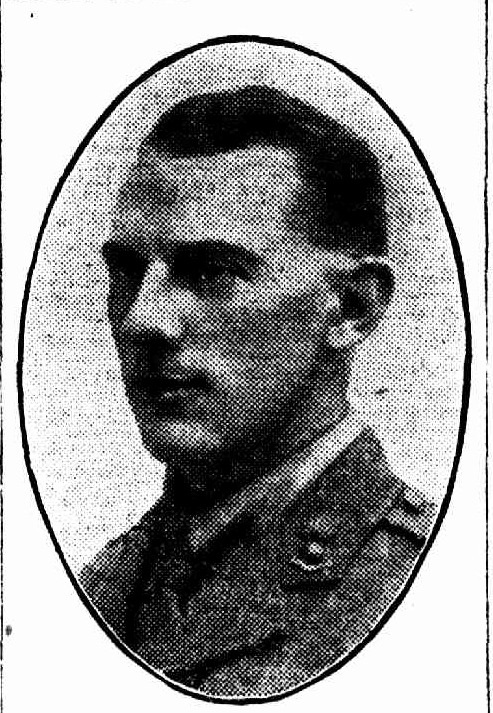
On his way back to Australia war broke out. He was keenly anxious to get to the front. In April, 1915, he and his brother left for England, where he Joined the Royal Artillery, going into training In Ireland. He remained there until the end of the same year, when he obtained his commission, and went to Gallipoli with reinforcements for the 97th division. After the evacuation he proceeded to Egypt, and then to France, where he saw some two years' service up to the time of his death. He gained his second star some six months ago, and on January 15 of this year was gazetted captain, second in command of his battery. In the same month he was transferred to near where he fell, east of Bapaume. LATE CAPTAIN DUDLEY ADAMS. (1918, April 5). The Daily Telegraph (Sydney, NSW : 1883 - 1930), p. 4. Retrieved from http://nla.gov.au/nla.news-article239261230
LATE CAPTAIN DUDLEY ADAMS.
HOW HE DIED.
The facts concerning the death of Captain Dudley Adams, who was killed in action on March 21 at Jussy, near St. Quentin, are that on the morning of that date the enemy heavily shelled the wagons lines and vicinity for several hours, killing and badly wounding many horses.
Captain Adams ordered his men into dug-outs, and then went himself to a hut to obtain a revolver to destroy the wounded horses. While In the hut It was struck by a shell, which wrecked It and mortally wounded Captain Adams. He was picked up and carried to a dressing station close by, but expired on the way.
His commanding officer further states: — "I need hardly say how keenly 1 feel Ills loss. We had been In the battery together tor over two years. He was a keen, capable, fearless officer, very thorough In all he did. I have not only lost a good officer, but a true, cheerful companion and staunch comrade, who will, Indeed, be very difficult to replace. He was much loved by officers and men alike." LATE CAPTAIN DUDLEY ADAMS. (1918, June 20). The Daily Telegraph (Sydney, NSW : 1883 - 1930), p. 5. Retrieved from http://nla.gov.au/nla.news-article239262723
WILLIAM ADAMS AND CO. LTD. The pavilion which houses this firm's exhibit is an exhibit in itself, and is quite unique. It is constructed with reinforced Adamax roofing, lined with beautifully tinted -Adamo wall-boards, manufactured by the Cumberland Board Mills, for which Adams .and Co. are the sole distributing agents. The exterior is of expanded metal ("Corr-mesh"), set in cement and roughcast flush. The centre of attraction in the exhibit is a 5-6 ton Sentinel steam waggon, a British product, fitted with an all-steel hydraulically-operated end-tipping body. It has ' already been sold to the Blue Mountains Shire Council. The waggon runs on coke or coal as a fuel, and is claimed to be much more simple than a petrol lorry, and cheaper to run. To send the waggon to Katoomba, for Instance, would cost £1 for fuel, or to Parramatta and back, at an average speed of 15 miles an hour. 2s 3d. The 4ton Sentinel trailer, to hook be hind, is all-steel construction. The firm's other exhibits are mainly represented by Australian manufactures. These include lathes, petrol launch engines, aid plumbers' brassware. There Is also a very fine display of furniture manufactured out of Adams wallboards. PALACE OF INDUSTRIES (1922, April 14). The Daily Telegraph (Sydney, NSW : 1883 - 1930), p. 6. Retrieved from http://nla.gov.au/nla.news-article246462984
WILLIAM ADAMS AND CO. LTD.
William Adams Steel Reinforcement Co. Ltd has been registered with a capital of £10 000 to acquire and take over as going concern and to develop the business of steel merchants now carried on by William Adams and Co Ltd. The managing director of William Adams and Company, Ltd writes, pointing out that the new company will take over only that portion of the business relating to steel bars for the reinforcement of concrete now carried on by William Adams and Co, Ltd and that the directors of both companies are identical. WILLIAM ADAMS AND CO. LTD. (1930, January 1). The Sydney Morning Herald (NSW : 1842 - 1954), p. 9. Retrieved from http://nla.gov.au/nla.news-article16614539
WILLIAM ADAMS AND CO.
William Adams and Company, Ltd., in the report covering the 12 months ended April 30 discloses a loss of £761. On the figures dis-closed at the October balance date the directors felt justified in declaring an Interim dividend at the rate of 5 per cent, per annum. The deficiency has been met by transferring £5000 from the dividend equalisation account. The preference dividend of 7 per cent, was paid for the year, accounting for £1750, and a credit balance of £770 is carried forward against £3870 brought into the account. A comparison with previous years is as follows:
Year ended April 30, - 1920. 1921. 1922.
Net profit .£10,706 £26,716 -
Loss . - - £751
To dly. equal account .. - 048 -
From div. equal account . - - 5,000
Dlv" p.c., ord. 10 10 S Div. amount . 18,938*> 23,943" 7,348» Forward . 2,010 3,870 770 LIABILITIES
Capital .197,370 248,223 248,956 Creditors .105,578 144,991 93,357 Bank . 101,472 08.473 89,158
Itescrve . 4,113 - -
Div. equalisation .... Ifl.SUO 15,853 11,000 Mortgage ._. 17,000 17,000 12,000
ASSETS
Freehold . 74,024 70,006 91,956
Debtors .182,005 135,804 »5,787 Stock, etc. .194,493 244,005 211,446
Machinery, cte. 14,130 22,742 28,050
Investments . 17,438 19,028 17,007 Cash . 3,457 2,523 769
Goodwill . 10,500 10,500 10,600
* Includes £1750 pref. div.
Apart from the general depression in trade during the last 12 months the report states that there wore one or two special factors which contributed to the unsatisfactory results disclosed. There was the depression in the mining industry. The company has always done a considerable amount of merchant business with metalliferous mines throughout Australia. Last year, owing to the drop in the price of metal many of the Australian mines were either practically closed down or working on a very reduced scale. The business of the company was thus affected, not only because of the reduced demand for supplies, but also from the fact that the special stocks carried for these mines, which would, under normal conditions, have been turned over rapidly, had become slow selling on a failing market. The appreciation of sterling, expressed in terms of dollars, seriously affected the value of the company's American stocks. Over a period of 12 months American stocks depreciated in value by approximately 20 per cent., and, while only a small proportion of the company's stocks were held during the whole period, the improvement in the sterling rate adversely affected the profit on all American goods during the year. The depreciation applied more particularly to goods landed during the first half, and sold during the second half of the financial year. In the previous report reference was made to the paralysing effect on the engineering trade of Mr. Justice Higgins' award in the A.S.E. case. During the whole financial year the depression in the engineering trade was most severely felt In oil departments of the company's business. The company's engineering works were carried on with about half their normal number of hands, and the trading departments also suffered owing to the depression in other engineering works, which normally draw a large percent-age of their supplies from the company's stocks. The new arbitration award of Mr. Justice Powers will give some measure of relief, and the directors are looking forward to better results during the current half-year. Further, the cessation of the Commonwealth Government's building programme in connection with war service homes also affected business. Up to a year ago the War Ser-vice Homes Department, with a view to accumulating adequate stocks of its immense building programme was ordering requirements in such quantities as, in many cases, to inflate prices. When the Government shut down Its building programme. Instructions were given to the War Service Homes Department to dispose of Its accumulated stores, and this action flooded the market with goods which have been sacrificed below the original purchase price-thus not only depressing the value of stocks held by merchants, but also closing to merchants avenues of sale previously open. These war service homes stores are now being absorbed, and the market for the mines represented Is becoming more stable. Generally, the report continues, the company's sales in terms of quantity have not been far short of previous years, but owing to the lower selling prices the sales in terms of money have been less. The com-bination of decreased demand, and a falling market has materially reduced gross profits, and as there has been no corresponding reduction in salaries, wages, interest, and other charges, the expenses have temporarily exceeded the gross profit, leaving a loss for the year. There are already indications of an early Improvement, in the opinion of the directors. The report notes that nearly half the company's share capital Is held by the directors and employees of the company and their Immediate relatives. WILLIAM ADAMS AND CO. (1922, August 10). The Sydney Morning Herald (NSW : 1842 - 1954), p. 8. Retrieved from http://nla.gov.au/nla.news-article16018113
WILLIAM ADAMS & CO., LTD.
MACHINERY MERCHANTS
Directors : W. J. Adams, J. H. Slater, A. Barton Adams, C. G. Colman, H. E. Slater, D. C. Morrison. PROS. and CONS. ON CHANGE (1932, September 4). The Sun (Sydney, NSW : 1910 - 1954), p. 19. Retrieved from http://nla.gov.au/nla.news-article229251663
OBITUARY.
MR. W. J. ADAMS.
 News has been received by cable of the sudden death in London of Mr. William John Adams, who for 50 years has been associated with various business activities in Australia.
News has been received by cable of the sudden death in London of Mr. William John Adams, who for 50 years has been associated with various business activities in Australia.
Mr. Adams was born in England in 1853. He came to Australia in 1884, when he founded William Adams and Co. Ltd., of which he was chairman of directors up to the time of his death.
Mr Adams was a member of the Institution of Mechanical Engineers, London and an associate member of the Institution of Engineers, Australia. He was also a member of the Royal Society of New South Wales and was one of the founders of the Athenaeum Club.
In addition to his association with William Adams and Co., Ltd., he was chairman of directors of William Adams Steel Reinforcement Co., Ltd., a member of the directorate of several other companies, and was for many years on the directorate of the original "Daily Telegraph Newspaper Co., Ltd. He was a member of the Royal Sydney Golf Club.
He is survived by Mrs. Adams, of Hampstead London, one son (Mr. Alfred Barton Adams, acting chairman of William Adams and Co., Ltd.), and two daughters Misses Dorothy Mary and Alice Windett Adams of Sydney. Another son Captain Dudley Adams, was killed in action in 1918. OBITUARY. (1935, June 14). The Sydney Morning Herald (NSW : 1842 - 1954), p. 12. Retrieved from http://nla.gov.au/nla.news-article17186549
DIED SUDDENLY
SYDNEY BUSINESS MAN PASSES IN LONDON
Mr. William John Adams, who for 50 years was associated with various business activities in Australia, died suddenly in London on the 12th inst.
He was the founder and chairman of directors of the firm of William Adams and Co., chairman of directors of William Adams Steel Reinforcement Co., Ltd., and for many years was on the directorate of the original "Daily Telegraph" Newspaper Co. He is survived by his widow, who lives at Hempstead, London, one son, and two daughters, both of Sydney. DIED SUDDENLY (1935, June 14). The Daily Telegraph (Sydney, NSW : 1931 - 1954), p. 6. Retrieved from http://nla.gov.au/nla.news-article246466225
DEATHS
ADAMS -June 12 In London William John late of Sydney beloved husband of Clara loving father of Dorothy, Betty and Barton. Family Notices (1935, June 14). The Sydney Morning Herald (NSW : 1842 - 1954), p. 10. Retrieved from http://nla.gov.au/nla.news-article17186576
In the Supreme Court of New South Wales.
PROBATE JURISDICTION.
In the will of William John Adams, late of Sydney, in the State of New South Wales, but at the time of his death residing in London, merchant, deceased.
PURSUANT to the provisions of the Wills, Probate and Administration Act, 1898, of the Testator's Family Maintenance and Guardianship of Infants Act, 1916, and of the Trustee Act, 1925: Notice is hereby given that all, creditors and other persons having any claim or demand upon or against the estate or otherwise interested in the property and assets of the abovenamed deceased, who died at Hamstead Heath, England, on the 12th day of June, 1935, and probate of whose will was granted by the Supreme Court of New South Wales, in its Probate Jurisdiction, on the 29th day of October, 1935, to Alfred Barton Adams, son of the said deceased, company director, of Sydney, and Perpetual Trustee Company Limited^ of 33-39 Hunter-street, Sydney, are hereby required to send, on or before the 11th day of January next, full particulars of their claims and demands upon the said estate or in respect of the said property and assets or any part thereof to Perpetual Trustee Company Limited, 33-39 Hunter-street, Sydney, at the expiration of which time the said Alfred Barton Adams and the said Perpetual Trustee Company Limited, as executors of the will of the said deceased, intend to proceed to administer the said estate and to convey and distribute the property and assets of the said deceased to and among the parties and persons entitled thereto, having regard only to the claims and demands of which they shall. then have notice; and the said Alfred Barton Adams and the said Company will not, in respect of the property and assets or any part thereof so conveyed or distributed, be liable to any person of whose claim they shall not have had notice at the time of such conveyance or distribution.— Dated this 31st day of October, 1935.
For Perpetual Trustee Company Limited, •
K. COPLAND LETHBRIDGE,
Managing Director. Stephen, Jaques and Stephen, Proctors. PROBATE JURISDICTION. (1935, November 8). Government Gazette of the State of New South Wales (Sydney, NSW : 1901 - 2001), p. 4406. Retrieved from http://nla.gov.au/nla.news-article223069222
SLATER.— August 7, 1938, at Manly. John Henry, husband of the late Susie Slater, father of Will, Ern, and Cal Slater, and Flo (Mrs. A. B. Cole). Family Notices (1938, August 8). The Daily Telegraph (Sydney, NSW : 1931 - 1954), p. 11. Retrieved from http://nla.gov.au/nla.news-article247352562
SLATER. The Funeral of the late JOHN HENRY SLATER will leave St. Margaret's' Presbyterian Church. Eastern Road. Turramurra, after' a short service, commencing at 2.30 p.m. TO-DAY, MONDAY, for the Northern suburbs Crematorium. Family Notices (1938, August 8). The Sydney Morning Herald (NSW : 1842 - 1954), p. 9. Retrieved from http://nla.gov.au/nla.news-article17486112
DEATH OF J.H. SLATER
Mr. John Henry Slater, who died at Manly recently, was one of the founders of the firm of William Adams and Co., Ltd. He was born in Sevenoaks, Kent in 1854, and came to Australia 63 years ago. In 1884, Mr. Slater helped the late Mr. W. J. Adams to establish the firm which bears the latters' name, and was its Managing Director until his retirement in 1922. He was also a director of several other companies during his business career.
Mr. Slater is survived by three of his sons, Sydney William (of Turramurra), Henry Ernest (Killara), and Clarence Arthur (Pymble), and one daughter, Mrs. A B Cole of Manly. DEATH OF MR. J. H. SLATER. (1938, August 13). The Sydney Morning Herald (NSW : 1842 - 1954), p. 16. Retrieved from http://nla.gov.au/nla.news-article17488197
Daughter's Marriage: 8995/1910 COLE ARTHUR B SLATER FLORENCE M MANLY
COLE—SLATER.—September 24, 1910 at St. Matthew's Manly, by the Rev. A. G. Stoddardt, Arthur Beaumont, second son of the late Henry Cole, to Florence Margaret, only daughter of John Henry Slater, of Drummoyne. Family Notices (1910, November 19). The Sydney Morning Herald (NSW : 1842 - 1954), p. 12. Retrieved from http://nla.gov.au/nla.news-article15179504
In the Supreme Court of New South Wales. (233,018)
PROBATE JURISDICTION.
In the will of John Henry Slater, late of Craigneish Flats, Reddall-street, Manly (formerly of Bobbin Head, road, Turramurra), in the State of New South Wales, retired merchant, deceased.
PURSUANT to the Wills, Probate and Administration Act, 1898-1932, the Testator's Family Maintenance and Guardianship of Infants Act, 1916-1934, arid the Trustee Act, 1925: Notice is hereby given that every creditor and any other person having any claim against the estate of John Henry Slater, the abovenamed deceased, who died on or about the 7th day of August, 1938, and probate of whose will was granted by the Supreme Court of New South Wales, in its Probate Jurisdiction,' on the 21st day of September, 1938, to Henry Ernest Slater, of Killara, iif the State aforesaid, company manager,-the sole executor of the will, is hereby required to send particulars in writing of such claim to the said Henry Ernest Slater, to the care of the undersigned, at their office hereunder mentioned, on or before the 5th day of February, 1939, at the expiration of which time the said Henry Ernest Slater will proceed to distribute the assets of the said deceased amongst the persons entitled thereto, having regard only to the claims of which he then has notice; and notice is hereby further given that the said Henry Ernst Slater will not be liable, for the assets or-any part thereof so distributed, to any person of whose claim he shall not have had notice at the time of such distribution.—Dated this 29th day of November, 1938.
W. E. SCOTTEE & SON,
Solicitors for the said Executor,
Stephen Court, 79 Elizabeth-street, Sydney. PROBATE JURISDICTION. (1938, December 2). Government Gazette of the State of New South Wales (Sydney, NSW : 1901 - 2001), p. 4642. Retrieved from http://nla.gov.au/nla.news-article225069309
IN the matter of ADAMS INVESTMENT COMPANY PTY LIMITED (In Liquidation) and in the matter of the Companies Act, 1961.—Notice is hereby given that a meeting of the abovenamed company will be held at 20th Floor, 6-10 O'Connell Street, Sydney, on the 31st day of October, 1980, at 10 o'clock in the forenoon, for the purpose of having laid before it by the liquidator an account showing how the winding up has been conducted and the property of the company disposed of, and of hearing an explanation of the account by the liquidator.—Dated this 2nd day of October, 1980. A. C. PIKE, Liquidator, c.o. Coopers & Lybrand, 6 O'Connell Street, Sydney. (9653) IN the matter of ADAMS INVESTMENT COMPANY PTY LIMITED (IN LIQUIDATION) and in the matter of the Com (1980, October 3). Government Gazette of the State of New South Wales (Sydney, NSW : 1901 - 2001), p. 5282. Retrieved from http://nla.gov.au/nla.news-article231164001
Alfred Barton Adams
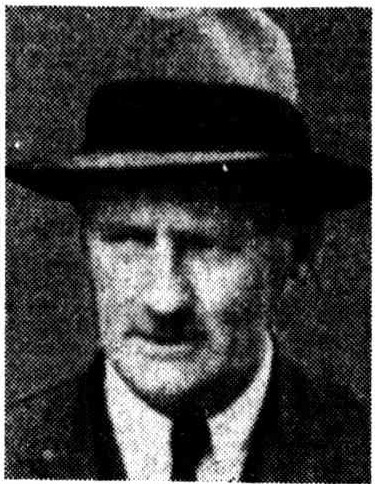
Mr. A. Barton Adams, chairman of directors of William Adams & Co., Ltd. The company, whose profits for the past year represented 20 ½ J p.c. on ordinary capital, is offering: new shares to shareholders in the proportion of one to- two held. No title (1938, July 17). The Sun (Sydney, NSW : 1910 - 1954), p. 14 (News Section). Retrieved from http://nla.gov.au/nla.news-article229126028
BATHERS' PAVILION AT BALMORAL.
SWIMMING CARNIVAL OF MARIST BROTHERS' SCHOOLS SPORTS ASSOCIATION. Help
THE BUILDING WAS OFFICIALLY OPENED YESTERDAY.
HARBOUR BRIDGE.
The first panel of the arch (on the southern side) was completed yesterday.
SPECTACULAR FIRE AT ALEXANDRIA CAUSES DAMAGE ESTIMATED AT £40,000. The outbreak occurred in an oil store occupied by William Adams and Co., Ltd., in Fountain-street. Nearly one hundred firemen fought the flames. SPECTACULAR FIRE AT ALEXANDRIA CAUSES DAMAGE ESTIMATED AT £40,000. (1929, February 21). The Sydney Morning Herald (NSW : 1842 - 1954), p. 14. Retrieved from http://nla.gov.au/nla.news-article16532948
BIRTHS.
ADAMS.—November 3, at Whitmore, Wentworth-road, Burwood, the wife of W. J. Adams, of a son. Family Notices (1890, November 17). The Sydney Morning Herald (NSW : 1842 – 1954), p. 4. Retrieved from http://nla.gov.au/nla.news-article13782417 - Dudley
NSW BDM’s: ADAMS DUDLEY 9333/1890 WILLIAM J ALICE E BURWOOD
Dorothy Mary
Alice Windett Adams (1889–1978) of Burwood, New South Wales, Australia.
Alfred Barton Adams (1892-1965)
Parents marriage (1883 ?): registered in April, May, June 1883 UK BDM’s –
ADAMS William John Wandsworth (District) 1d 845
Slater Alice Emily Wandsworth 1d 845
Slater Alice Emily Wandsworth
Wandsworth is a London borough in southwest London; it forms part of Inner London.
BIRTHS.
ADAMS.—April 11, 1886, at 143, Macquarie-street, Sydney, the wife of William John Adams, of a daughter. Family Notices (1886, April 17). The Sydney Mail and New South Wales Advertiser (NSW : 1871 - 1912), p. 827. Retrieved from http://nla.gov.au/nla.news-article162817085 - DOROTHY M
ADAMS ALICE R 5192/1889 WILLIAM J ALICE E BURWOOD
IN the Supreme Court of New South Wales.—Probate
Division.—Any person having any claim upon the estate of ALICE WINDETT ADAMS, late of Edgecliff, spinster, who died on the 22nd October, 1978, must send particulars of his claim to Patricia Ruth Crooke and James Hardie Jamison, care of Messrs Priddle Gosling, Solicitors, G.P.O. Box 983, Sydney 2001 (D.X. 366, Sydney), within two calendar months after publication of this notice. After that time the executors may distribute the estate, having regard only to the claims of which at the time of distribution they have notice. Probate was granted in New South Wales on the 14th December, 1978. IN the Supreme Court of New South Wales.—Probate (1979, May 4). Government Gazette of the State of New South Wales (Sydney, NSW : 1901 - 2001), p. 2196. Retrieved from http://nla.gov.au/nla.news-article219967620
1867-2017 — 150 years)
For over one hundred years, faithful souls have worshipped and served Jesus Christ as Lord and Master in the fellowship of His church in the Church of England (now Anglican) parish of St John the Evangelist, Gordon.
The site – said to be the finest piece of real estate in Gordon – was first used as a school in 1823, but it was not until 1872 that a church was built there.
The first church was built as a result of a petition sent to the Governor through the Bishop of Sydney by 36 local inhabitants. Robert Pymble, William Henry McIntosh and John Brown were appointed trustees and the land was knocked down to them for 37 pounds. The church was designed by Edmund Blacket and the foundation stone was laid on October 26, 1872.
The history of St John’s has been recorded in several publications. In 1923 a History of the Parish of St John the Evangelist, Gordon, was written by Mr Henry Selkirk, FRAHS; to mark the centenary of the church in 1972 a history was published by St John’s Parish Council; in 1997 the 125 Year History, edited by John C. Moon, AM, was published. This latter publication incorporated a reprint of the centenary history. Copies are available from the Parish Office.
The history of St John’s cemetery, which adjoins the church, began earlier than the church itself, the first recorded burials having occurred in 1867. Pioneers at Peace by Jill Lyons (Spurwood Press, 1994, ISBN No. 0 646 19503 4) relates the history of the cemetery. A cemetery map and an index of burials and commemorations are included.
PIONEERS at PEACE
The story of St John's Cemetery, Gordon
by
Jill Lyons Online at: http://gutenberg.net.au/ebooks15/1501111h.html ; ‘’ One of the loveliest memorials in the churchyard is the tall celtic cross (fig.7), with elaborately carved passionflowers intertwined with lilies (crucifixion and resurrection) on the grave [JJ-1] of Alice Emily Adams (d.1906 aged 55). Alice was the first wife of William John Adams, founder of the Australia-wide engineering company, William Adams & Co., which sold everything for the engineer. William and their children are commemorated on her memorial.’’
William Adams family:
The Bell-Wether — William Adams — an Australian company from foundation to takeover — 1884-1984. By Patsy Adam-Smith. Thomas Nelson Australia and William Adams & Co. Ltd., Sydney, 1984.
Alfred Barton Adams - About this object: From the register of early residents of Sandringham. Alfred Barton Adams and his wife Winifred Beatrice (Carter) lived at 8 Abbott Street, Sandringham from 1924, 22 Southey Street, Sandringham from 1931 to 1963 and then 13 Le Fevre Street, Hampton. Alfred was the son of William Adams of WM Adams and Company Ltd. He was Director 1920 - 1961 and Chairman 1935 to 1961. Includes research notes, newspaper cuttings, extract (incl photos) from published history of WM Adams & Co. Ltd.
SANDRINGHAM DANGE.
The Sandringham Memorial Hall was a scone of picturesque gaiety on Tuesday evening, July 6, when the newly formed Sandringham auxiliary for the Children's Hospital arranged a successful plain and fancy dress dance in aid of the 'hospital's appeal. The hall was decorated by the Victorian Railways Commissioners with their original posters- advertising the "eat-more-fruit" campaign. Eight giant lanterns fashioned from posters cast a soft glow over the hall, and great rustic baskets of citrus fruit (given by the local fruit shops) lent colour to this original scheme. This fruit was subsequently sold to increase the funds. During the evening Mr. Charles Hearden and Miss Gilbert gave a special exhibition of the 'Charleston," and Mrs. IT. S. Gullett, Mrs. Cato, and Mr. Will Dyson acted as ; judges for the fancy costumes. Mr. Campbell ("Pirate") and Miss Curtis ("Early Victorian") gained first prizes for the best fancy dress, and Miss Nancy Miller ("Pack of Cards") and Miss Brady ("Patches") came second. For the most original pair, Mr. Oliver and Miss Berlotto gained first prize as "White Cario," and Mr. Alan Sloss and Miss Marjone Sloss came second as "The Herald." In the competition for the best paper costume first prizes went to Mr. Barton Adams ("Toy Soldier") and to Mrs. Clive Gower ("Lady from Louisiana"), while Mr. Bowe ("Pineapple'') and I Airs. Ian Macfarlan ("Rose et Noir") gained second prizes. A consolation prize was awarded to the president of the dance committee (Mrs. James Gatehouse), who represented the " eat-more-fruit" slogan, … . SANDRINGHAM DANGE. (1926, July 10). The Australasian (Melbourne, Vic. : 1864 - 1946), p. 55 (METROPOLITAN EDITION). Retrieved from http://nla.gov.au/nla.news-article142159132
Barton played golf, as an amateur, later as a member of the Royal Melbourne club (in 1920/30’s) – thus the putting green at Bungan’s ‘Cooinoo’ – family members were part of the Manly Golf Club:
Barton Adams, who has been mentioned in despatches, is now a flight-commander, and wrote last from Dover. GOLF NOTES (1917, May 9). Referee (Sydney, NSW : 1886 - 1939), p. 11. Retrieved from http://nla.gov.au/nla.news-article120296831
GOLF NOTES
EASTER HOLIDAYS PLAY ON MOUNTAINS : KAMERUKA More Golfers Fall in Action in France
By AULD REEKIE.
The Manly Golf Club records with deep regret the death, at the front, of Captain Dudley Adams, of the Royal Artillery — killed in action, in France, in March. He was a son of Mr. W. J. Adams, a very esteemed member of the club. He is the eleventh member of the club who has given his life for King and country. His brother, Major Barton Adams, is with the Royal Flying Corps, in France. … GOLF NOTES (1918, April 10). Referee (Sydney, NSW : 1886 - 1939), p. 16. Retrieved from http://nla.gov.au/nla.news-article120313996
BIRTHS. ADAMS. - July 21, at Ripon, Holbrook-avenue, Kirribilli, to Mr. and Mrs. A. Barton Adams - a son. Family Notices (1922, August 1). The Sydney Morning Herald (NSW : 1842 - 1954), p. 8. Retrieved from http://nla.gov.au/nla.news-article16016475
ENGAGEMENTS
The engagement is announced of Patricia Ruth, only daughter of Mr and Mrs Barton Adams, of Sandringham, to Edward Menzies, twin son of the late Mr. and Mrs E. J. Crooke, of The Holey Plain, Rosedale, Gippsland. ENGAGEMENTS (1946, July 8). Gippsland Times (Vic. : 1861 - 1954), p. 3. Retrieved from http://nla.gov.au/nla.news-article65419811
MATTINSON—ADAMS.—The engagement is announced between Marjorie Winifred, elder daughter of Mr. and Mrs. W. H. R. Mattinson, Ecklin South, via Terang, and Dudley Barton (Mick), only son of Mr. and Mrs. Barton Adams, Sandringham. Family Notices (1953, June 15). The Argus (Melbourne, Vic. : 1848 - 1957), p. 10. Retrieved from http://nla.gov.au/nla.news-article23250275
Major Barton Adams, No. 1 Squadron, R.F.C., sends greetings to the Manly Club from Flanders. Lieut. Dudley Adams, R.F.A., also sends greetings from Flanders — I hear that there is a chance of his being promoted to captain. GOLF NOTES (1918, January 2). Referee (Sydney, NSW : 1886 - 1939), p. 11. Retrieved from http://nla.gov.au/nla.news-article120317413
William's second wife Clara played golf at Manly and elsewhere with him and his sons:
The Royal Sydney Golf Club held a mixed foursome 13-hole match.- The following were the best cards :— J. S. Marks and Mrs. W. H. Christian, 64—5= 59; C H. Reading and Miss Egan, 67, scr, 67; Dr. Morton and Miss J. Cape, 75—8=67; Dr. Forrester and- Miss Currie Elles, 79—11=68; Dr. H. Terrey and Mrs- Furber, 75— 6=69; W. J. Adams and Mrs. Adams, 81—12=69. GOLF. (1911, April 5). The Sydney Mail and New South Wales Advertiser (NSW : 1871 - 1912), p. 64. Retrieved from http://nla.gov.au/nla.news-article165739212
GOLF. MANLY CLUB.
Following are the draw and times for starting for the Open Mixed foursomes -
12 30, Barton Adams Mrs W- J Adams v R Sayers Mrs Macphail, … GOLF. (1914, November 13). The Sydney Morning Herald (NSW : 1842 - 1954), p. 10. Retrieved from http://nla.gov.au/nla.news-article15545464
Manly: Open mixed foursomes were played for the War Chest Fund, there being 64 entries. The following are the principal scores:— T. V. Healy and Mrs. Legg (9), 2 up; p. Mcagher and Miss P. Walier (Vt), 2 up; W. U. Foggitt and Mrs. Foggitt (10), 1 up; S. G. Kott and Miss Nott (11), 1 up; F. Waller and Miss Charters (IB). 1 up; G. P. Savers and Mr. Sayers (12J, square; O. H, Wines and, Mrs. Triggs (5), 1 down ; Captain E. Lloyd Davis and Miss Duret (10), 1 down; L. il. Oswald Sealy (I2j, ?- down; O. 1'. W. -Lloyd and' Miis 1). Lloyd (12;, 2 down; Major Barton Adams and Mrs Adams (7) 3 down; Captain J. P. Hill and Mte . Gregson (8), S down; A. II. Uther and Mrs. Uther (11), 3 down; G. E. R. McCarthy and Mrs. Brewer (11), 3 down; G. J. Wilkinson and Mrs. O'Callochan (14), 3 down; E. Durct and Mrs. Brown (38), 3 down; H. L. Tango and Mrs. Wilkinson (11), 4 down; G. S. Marich and Mrs. Marich, 4 down. The prize was two one pound War Chest buttons. ON THE MOUNTAINS. (1918, November 27). Referee (Sydney, NSW : 1886 - 1939), p. 12. Retrieved from http://nla.gov.au/nla.news-article120311538
GOLF NOTES
Noted Golfer's Death : Lady Carves Honor Board for the Manly Club
By AULD REEKIE.
Miss Jenkins, of Manly and Blackheath, has carved an honor board of very chaste and effective design, and presented it to the Manly Golf Club. It is beautiful work. The names of the fallen are engraved on it, and are Ernest A. Roberts (Nulla), Gallipoli; Arthur Verge, Egypt; Robert E. Hunt, Gallipoli; Frank Amphlett, France; Arthur R. Lloyd, Frank J. O'Brien, Kenneth Taylor, all in France; Hermann Hepner, Salonica; Arthur Mountie, France; G. B. Owen Tuck, France; Dudley Adams, France. GOLF NOTES (1919, March 26). Referee (Sydney, NSW : 1886 - 1939), p. 12. Retrieved from http://nla.gov.au/nla.news-article120311725
COMMERCIAL AVIATION.
AERIAL MAIL TO PORT SAID.
Commercial aviation between England and Australia, was discussed by members of the Employers' Federation yesterday afternoon. Alderman William Brooks, M.L.C., presided. Mr. C. Lloyd Jones said he had an overwhelming belief in the possibilities of commercial aviation. Ross Smith had flown to Australia in 5% flying days — he had blazed for them a wonderful trail. The aeroplane was a 50 per cent, saving in time on the train and 90 per cent, on the steamer. Australia had only to develop the aeroplane, and it was at their service. Major Barton Adams, late of the Royal Air Force, said the three difficulties in the way of commercial aviation were machines, pilots, and aerodromes, but provided that a company was. well provided under these three heads there was no reason why It should not carry on commercial aviation with success. With modern machines and mechanics 150 or 200 hours' flying was not at all excessive. Mr. Reginald Lloyd (of the Trans Australian Aerial Survey) said that Australia had pilots — Ross Smith had proved it — the machines, and she was the only country in the world with a complete set of landing stages from south to north. A series of landing places was required with a fresh pilot and machine at each. The establishment of such an aeroplane service could not be done without big expenditure. Were the business people of Australia going to do the work or allow others to do it? A mail and light freight service as far as Port Said would be established by the end of next year. The following motion was carried: — 'That this meeting recommends to the commercial men of Australia that ' they should financially support the promotion of Commonwealth aviation, both for internal and overseas communication.' COMMERCIAL AVIATION. (1919, December 16). Daily Commercial News and Shipping List (Sydney, NSW : 1891 - 1954), p. 4. Retrieved from http://nla.gov.au/nla.news-article159295408
Alfred Barton Adams ... Royal Air Force, Royal Flying Corps, R.A.F., R.F.C., Officers - Major
B884 V357803 ADAMS ALFRED BARTON : Service Number - V357803 : Date of birth - 16 Apr 1892 : Place of birth - LONDON ENGLAND : Place of enlistment - M BRIGHTON VIC : Next of Kin - ADAMS BARTON - re-enlisted to serve here in WWII
National Archives of Australia: Barton's only son -
ADAMS DUDLEY BARTON : Service Number - 418043 : Date of birth - 21 Jul 1922 : Place of birth - SYDNEY NSW : Place of enlistment - MELBOURNE : Next of Kin - ADAMS ALFRED
PLTOFF Dudley Adams 418043 - Squadron/s: 457 SQN, 85 SQN
Rank On Discharge/Death Pilot Officer (PLTOFF)
Mustering / Specialisation Pilot
Date of Birth 21 Jul 1922
Contributing Author/s Phil Listermann
Updated by Phil Nickols 2020
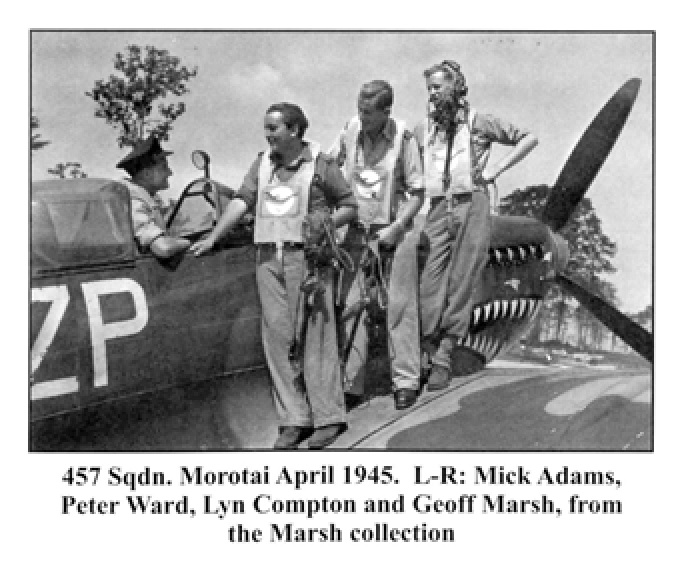
457 Sqdn. Morotai April 1945. L-R: Mick Adams, Peter Ward, Lyn Compton and Geoff Marsh, from the Marsh collection"
Dudley enlisted on 21 Jul 1922 from Melbourne, VIC. Posted from No 85 Squadron RAAF in which he was serving since June 1944, as an NCO. Native of New South Wales. He was in 457 Squadron from April 1945 to November 1945, and one of the pilots to be on duty when 457 Squadron wound up. Little is known about Dudley except that he was fined for flying a trainer too close to the ground. Discharged 14 Mar 1946 from No. 6 Hospital.
As can be read above, Barton was a Major in the 1st Squadron of the RAF. These items may make Pittwater residents wonder if a quick dip at Bungan Beach was part of Sir Ross Smith's historic flight from England to Australia in 1919. They flew on to Sydney in 1920 and during the subsequent few days stay in Sydney, he may have, as a guest of the Adams family, visited Cooinoo at Bungan, and if so, that may underline further why duering the Mackerel Beach subdivisions streets were named to honour this young man:
SIR ROSS SMITH.
ENGINE BEING REPAIRED.
Mr. W. J. Adams, of Messrs. W. Adams and Company, agents for Messrs. Vickers, Limited, has received a telegram from Sir Ross Smith, stating he had all materials required for the repairing of the engine, which work was being well advanced at Ipswich workshops. Sir Ross Smith asked that Major Barton Adams (son of Mr. W. J. Adams) and an engineer, might go north if possible. This request has been acceded to, and Major Adams will proceed to Ipswich one day next week. SIR ROSS SMITH. (1920, January 10). The Daily Telegraph (Sydney, NSW : 1883 - 1930), p. 12. Retrieved from http://nla.gov.au/nla.news-article239667590
SIR ROSS SMITH.
Sydney on Saturday.
SYDNEY, Wednesday-Major Barton Adams, of Messrs. William Adams and Co., agents for the Vickers-Vimy Co., to-day received a telegram from Sir Ross Smith at Charleville, stating that he will leave Charleville to-morrow morning, and that he expects to arrive in Sydney on Saturday morning.
Mechanics' Part in Great Flight.
Mr. C, H. Nelson, late commanding officer of the Australian Flying Corps at Laverton, has suggested to the Lord Mayor r (Councillor Aikman, M.L.C.) that the mechanics accompanying Sir Ross Smith should receive. a practical acknowledgment from the citizens, of Melbourne of their part in the flight. The Lord Mayor, -dink expressing sympathy with the proposal, has replied that, in his opinion, the initiative in the movement should be made by the military authorities. SIR ROSS SMITH. (1920, February 12). The Argus (Melbourne, Vic. : 1848 - 1957), p. 6. Retrieved from http://nla.gov.au/nla.news-article1677046
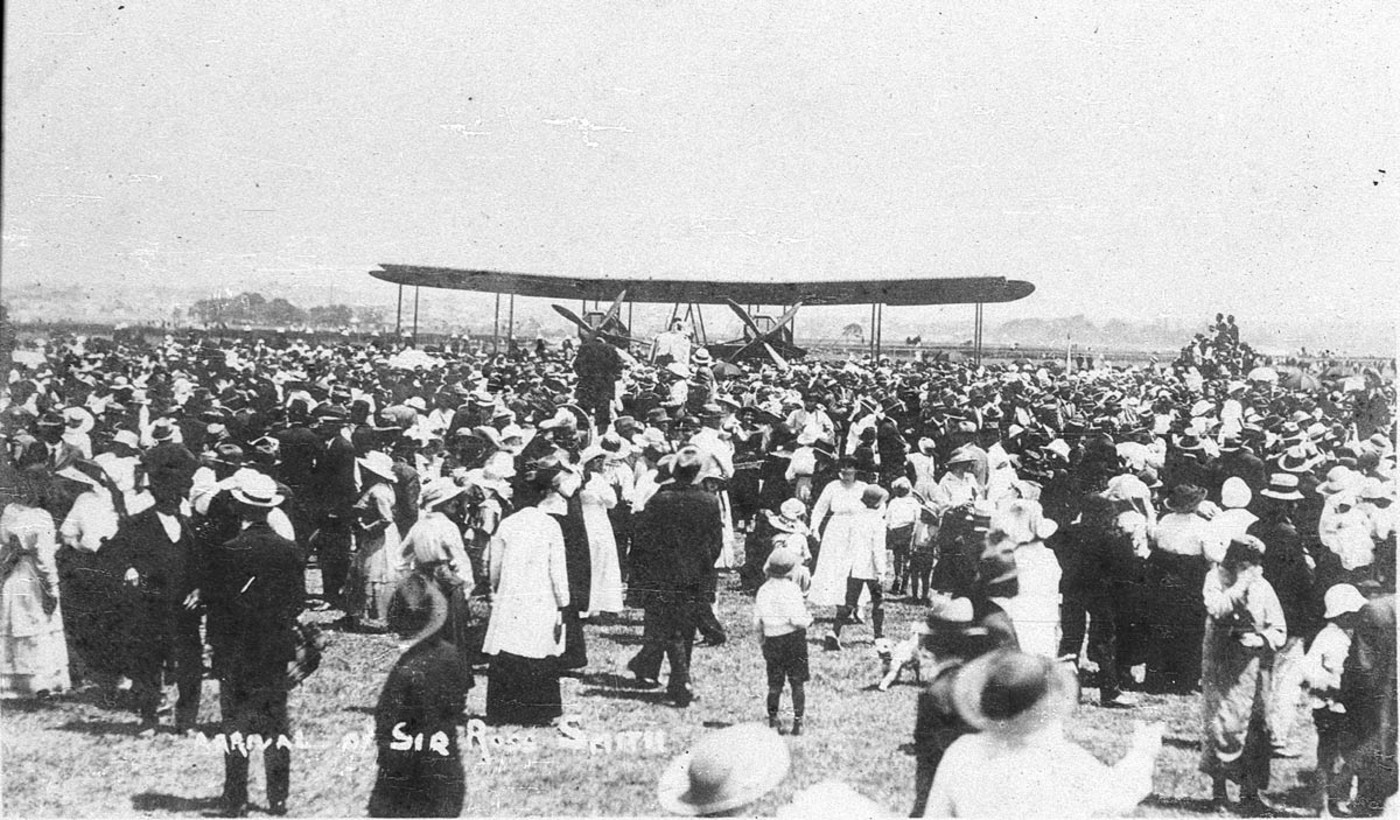
Royal Australian Historical Society : Sydney photographs, ca. 1879-1956; Arrival of Ross Smith at Mascot, February 14th, 1920 Item a1921060h, courtesy Mitchell Library, State Library of New South Wales

Welcome to Sir Ross Smith and Party at Town Hall Sydney, 14 February 1920, Courtesy National Museum of Australia nma.img-ci20112725-848-wm-vs1_o3_1100 Subject; Sir Ross M. Smith KBE MC DFC AFC, from the Collection of Mr Josef Lebovic
ROSS SMITH OFF AGAIN
Marriage of Sergeant Shiers SYDNEY. Tuesday.
Sir Ross Smith and his party went to Mascot Aerodrome this morning, and at 9.30 the Vickers Vimy was in the air again bound for Richmond, where the machine will stay until it starts for Melbourne. Captain Frank Hurley accompanied the machine again to take further photographs, but Sergeant Shiers, who is to be married to-day, did not take part in the flight, his seat being occupied by Major Barton Adams, the agent for Vickers. ROSS SMITH OFF AGAIN (1920, February 17). The Newcastle Sun (NSW : 1918 - 1954), p. 1. Retrieved from http://nla.gov.au/nla.news-article162592543
ROSS SMITH FLIGHT. PRESENTATION TO LIEUT. SHIERS. AERO CLUB OPENED.
The epoch-making flight of Sir Ross Smith and his gallant companions from Great Britain to Australia was recalled last night, when the State Governor, Sir Walter Davidson, presented the Royal Aero Club bronze medal to Lieut. W H Shiers, A F M , a member of the crew of the famous Vickers-Vimy on the momentous occasion.
In conjunction with the presentation his Excellency officially opened the new rooms of the New South Wales section of the Australian Aero Club in King-street. The combined ceremonies took place at Loosen’s London Cafe, In the presence of a big attendance of airmen and others interested in aviation, which included the president of the club (Major Barton Adams), and Lieut Col. H C Brinsmead, OUC, MC, Controller of Civil Aviation
His Excellency, after signing the club’s visiting book, and officially declaring the rooms open, complimented the member, upon the efforts they had made to further aviation in all its forms in Australia. He was honoured at having been associated with the functions in that he might, in some way, be Identified with the gallant men who were acclaimed is Australia’s heroes of the air. Among them none ranked higher than the late Colonel Oswald Watt. A brave man himself, he backed up his bravery with his means, his skill, and his knowledge He was brave to the minute of his death (Applause ). His Excellency then paid a graceful tribute to the crew of the Vickers-Vimv, among them Lieut Shiers, whom he characterised as the 'Captain of the fore-top ' on their world famous flight. The medal Is one of four presented by the Royal Aero Club of the United Kingdom to the four airmen who accomplished the great flight. ROSS SMITH FLIGHT. (1922, January 25). The Sydney Morning Herald (NSW : 1842 - 1954), p. 14. Retrieved from http://nla.gov.au/nla.news-article15972714
The origin of the Royal Federation of Aero Clubs of Australia dates back to the 28th October 1914, when a group of young officers of the newly formed Australian Flying Corps met at Point Cook, Victoria, and decided that an Australian Aero Club should be formed to advance the cause of aviation and be affiliated to the Royal Aero Club in London. The outbreak of the First World War delayed further development until 1919, when individual sections of the Australian Aero Club were formed, including The Royal Aero Club of New South Wales. – State Library of NSW
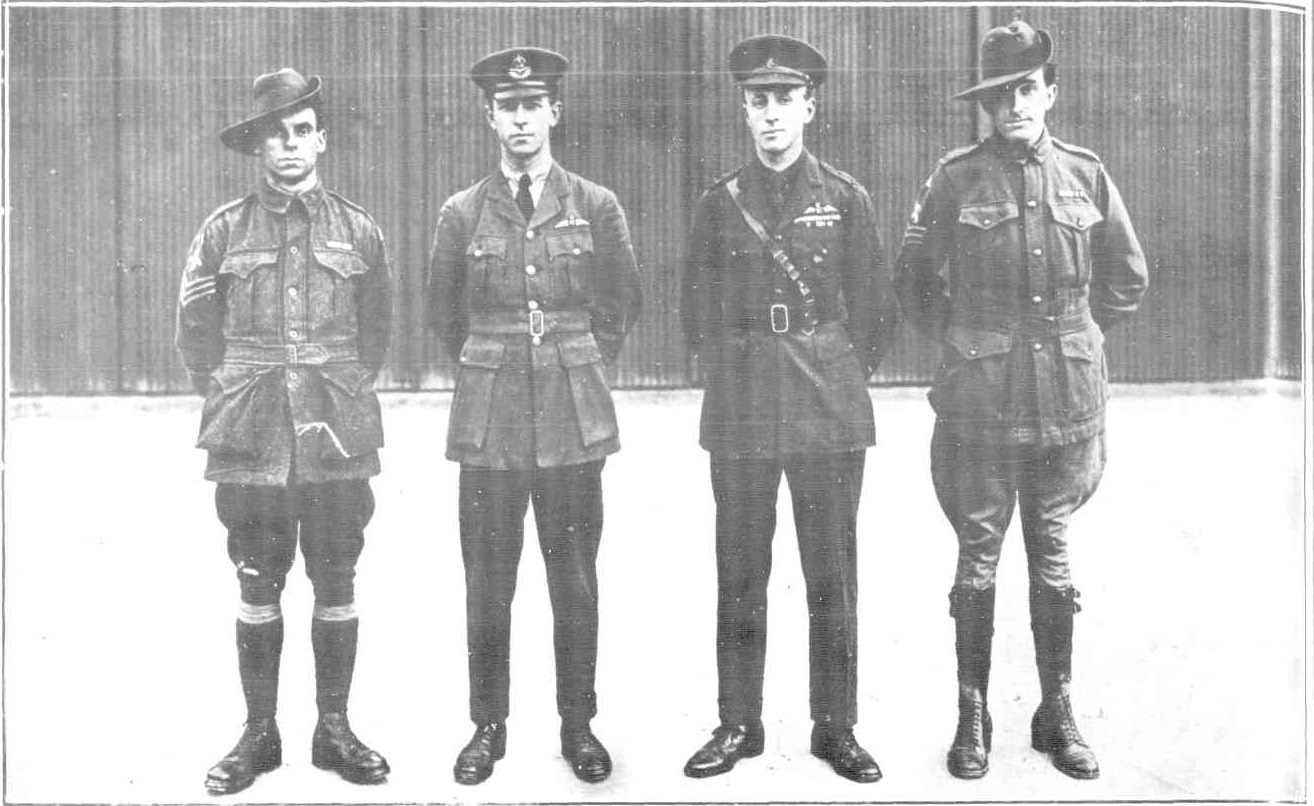
GROUP TAKEN PRIOR TO LEAVING ENGLAND FOR AUSTRALIA: (Left to Right).—Sergeant W. H. Shiers, Sir Keith Smith, Sir Ross Smith, Sergeant J. M. Bennett.
.jpg?timestamp=1622161949130)
1. ARRIVAL AT FEDERAL PARLIAMENT HOUSE, . 2. LANDING AT POINT COOK WITH AERIAL ESCORT. 3. SIB KEITH SMITH, COLONEL W. F.. H. CASS, SIR ROSS SMITH (Photograph taken just after landing). 4. MRS. BENNETT MEETING HER SON SERGEANT J. M. BENNETT, AFTER FOUR YEARS ABSENCE ON SERVICE. THE ARRIVAL OF SIR ROSS SMITH IN MELBOURNE, ON FEBRUARY 25. THE ARRIVAL OF SIR ROSS SMITH IN MELBOURNE, ON FEBRUARY 25. (1920, February 28). The Australasian (Melbourne, Vic. : 1864 - 1946), p. 56. Retrieved from http://nla.gov.au/nla.news-article140237201
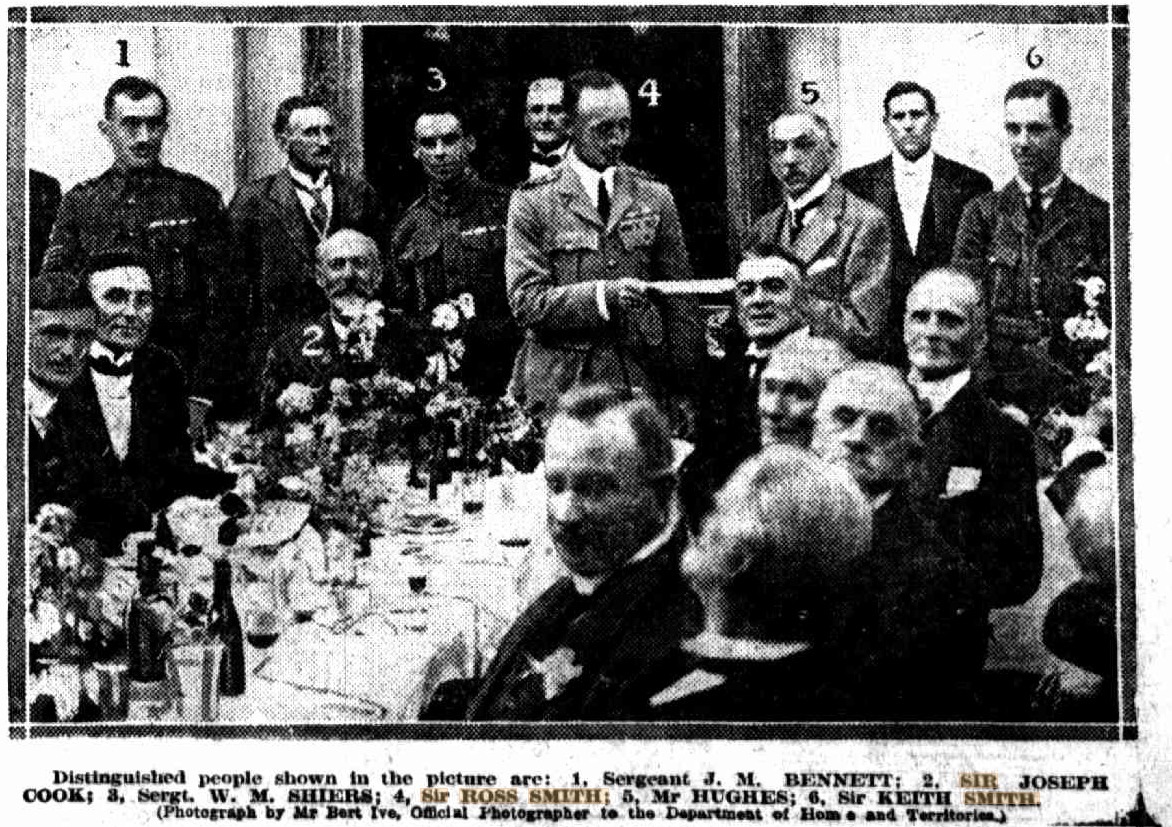
Mr Hughes Handing Cheque for £10,000 to Sir Ross Smith Mr. Hughes Handing Cheque for £10,000 to Sir Ross Smith (1920, February 28). The Herald (Melbourne, Vic. : 1861 - 1954), p. 1. Retrieved from http://nla.gov.au/nla.news-article242172408
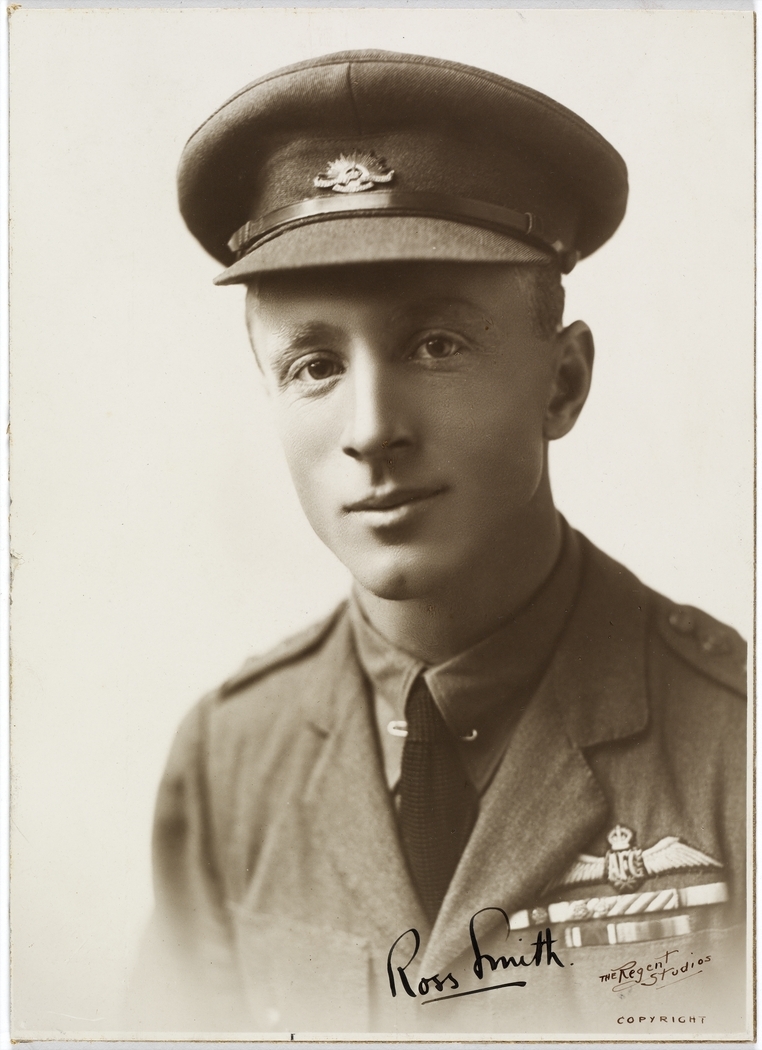
Sir Ross Macpherson Smith. Photo courtesy State Library of New South Wales

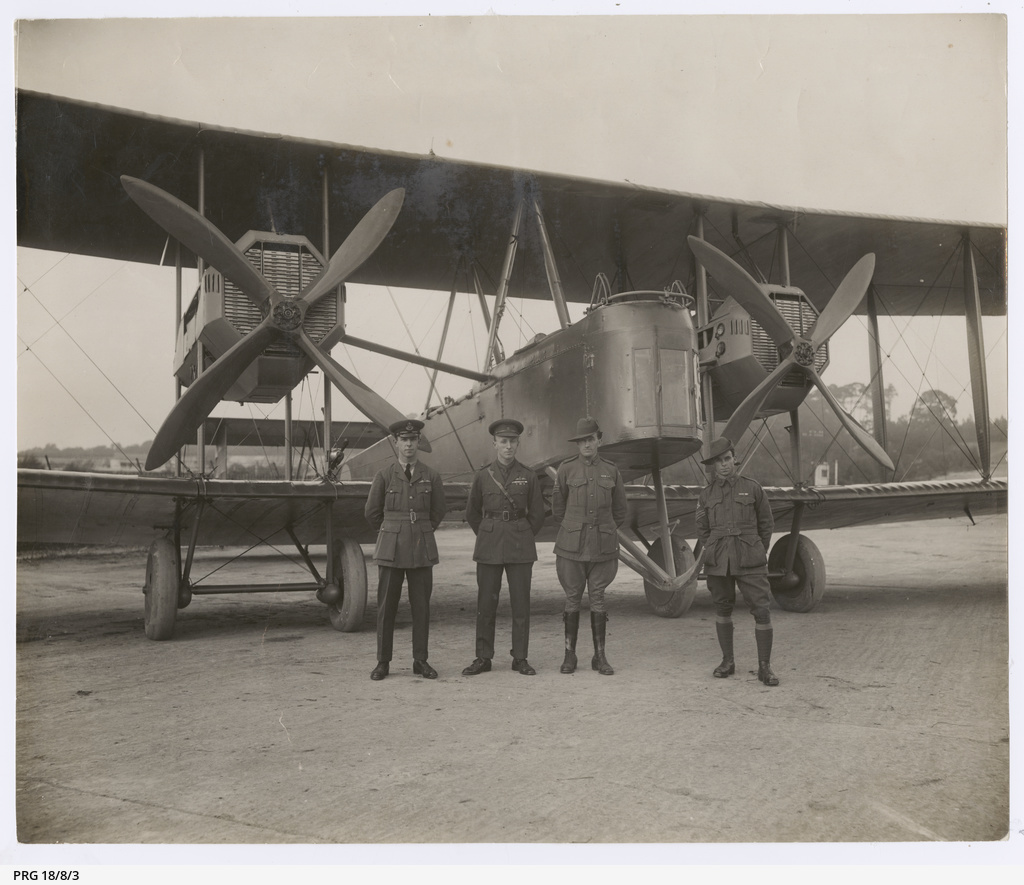
The Vickers Vimy and her with her crew. Photos courtesy the Australian War Museum
At the Adelaide Airport, past the terminal and inside a small building in the middle of the staff carpark and adjacent to the main runway, sits the Vickers Vimy and Sir Ross & Sir Keith Smith War Memorial. This much-ignored shelter shed contains the actual plane that was flown by the Adelaide-born Smith Brothers in their historic and epic flight from the UK to Australia in 1919. The plane was originally built as a World War I heavy bomber with the registration G-EAOU (affectionately known as "God 'Elp All Of Us"). The plane never saw active service. A year after the war ended it became one of the most important aircraft in world aviation history when Ross and Keith flew the plane 17,950 kilometres across the world. This may sound like a simple feat in these days of modern travel but if you have to cast your thoughts tro the facts that they did this flight just 16 years after the Wright Brothers flew the first ever powered aircraft and did so in an open cockpit, the perils become clearer. They flew through rain, blizzards and fog with no radios, no navigational equipment and no maps. Flight maps from England to Australia didn't exist, so they used hydrographical charts (used for ocean navigation) and Ross's personal flight memory of the Middle East to find their way. At one point on the flight, their goggles became so frozen they couldn't be used. So, they risked their eyesight by flying through 145kph icy winds with no eye protection. On their approach to Darwin, they put a handwritten message into an empty pickle jar, made a parachute and dropped it into the Timor Sea to let Captain H. Hayley of the HMAS Sydney know that they were on track and all was going well for their arrival. The pencilled message read "The Air, 10/12/19, Vickers Vimy, The Commander, H.M.A.S., Very glad to see you. Many thanks for looking after us. Going strong. Keith Smith, Ross Smith, Sgt. J. Bennett, Sgt. W. H. Shiers". The message and the jar were donated to the State Library of New South Wales by Captain Hayley in 1922.
The Smith Brothers were competing in the Air Race of 1919 and were determined to be the first to fly from England to Australia in under 30 days. Six crews entered the air race, but only 2 finished. With their mechanics, Sergeants Jim Bennett of Victoria and Wally Shiers also of Adelaide, they did it in just 27 days and 20 hours and won a whopping £10,000 first prize (equivalent to more than $1million today), which was shared equally amongst the 4 crew. They spent a total of 124 hours in the air. The second team to finish were Lieutenants Ray Parer and John McIntosh, who didn't leave England until the 20th January 1920 - well after the race had already been won. This didn't deter them and they eventually finished surviving a whatever could go wrong did experience. It took them took 237 days to reach Australia after crashing several times. Of the remaining 4 crews, two crews fatally crashed and the other two were put out of the competition due to a crash and a forced landing. Four of the pilots in the race were Air Aces - extremely skilled and highly honoured air servicemen.
AIR DERBY DINNER
There were over eighty present at the Derby banquet, held at the Macquarie, in the evening. Major Barton Adams, president of the club, presided.
In his opening remarks the chairman referred to the great work that had been done by the officials, and also the Invaluable assistance rendered by persons not 'members of the club. He laid particular Stress on the fine spirit that prompted Sir J. Joynton Smith to place the racecourse at the club's disposal, and also the work of arranging the motorcycle events, undertaken by Mr. Austin, secretary of the Royal South Sydney Hospital- The thanks of the club Were alia extended to Sir Thomas Hughes, M.L.C., who for the second occasion officiated as judge. After he had presented the Now South Wales trophies, and Colonel Brinsthead had handed the Victorian Derby Cup to Mr. Love Sir Thomas proposed the toast of the pilots. He referred to their exceptionally fine performance. In his response Mr. Love eulogised the work done for the aeronautical industry by the Aero Club. It was, he said, a source of great satisfaction to have such a competent and enthusiastic body in the city. Mr. S. Harper and Captain Pentland -also responded, the latter on behalf of the R A A F In proposing the toast of the committee ! Colonel Drinsmnad spoke of the stupendous task that had been Carried out to a successful conclusion. : In his response Captain Hughes, M.C A-F-C-, J stated that the meeting had proved an tin- s qualified success. Over 6000 people paid an aggregate exceeding 600 for admission. It was hoped that a good cheque would be paid to the South Sydney Hospital as a result. The assemblage was kept in a state of constant merriment during the short, but eloquent and witty speech by Mr. G. W. Lambert, the celebrated artist. His anecdotes relating to his service In Palestine and Egypt were particularly acceptable. AIR DERBY DINNER (1922, May 8). The Daily Telegraph (Sydney, NSW : 1883 - 1930), p. 5. Retrieved from http://nla.gov.au/nla.news-article245736359
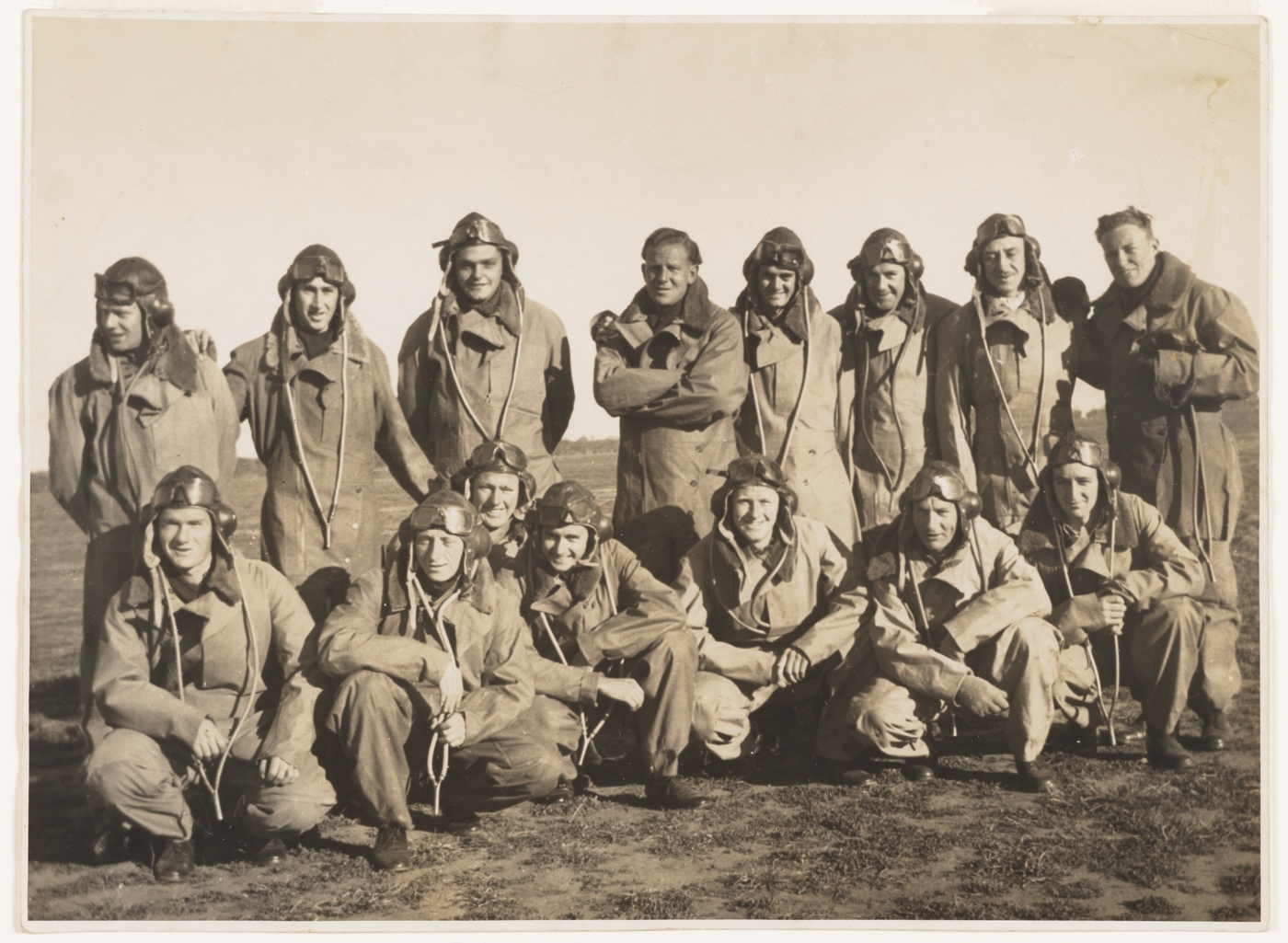
Photograph of Royal Aero Club members, Mascot Aerodrome, ca. 1930. Inscribed on reverse of photograph: "Royal Aero Club Members, Mascot Aerodrome (circa 1930). Goya Henry (Back row 2nd from right end)". 13 of the 15 pilots in the photograph have inscribed their name and place of residence: "Bill Purdy, Lindfield; Geoff Adams, Rose Bay; DW Higgeson, Roseville; Ray Leighton, Manly; Philip R Evans, Queensland; Ted Williams, Rose Bay; EB Rowell, Port Macquarie; SC Carey, Bowral; Philip Porter; Cec. Gleesons, Dulwich Hill; M Mayne, West Maitland; K Macpherson, Epping; JW Stowes, Newcastle" Item c036090001h Courtesy Mitchell Library, State Library of New South Wales
Victoria and Commonwealth Win Pennant Games - Barton Adams 72 In Medal Golf At Sandringham
As was expected Victoria and Commonwealth won the Senior Pennant games. Royal Melbourne, ...their section will meet Commonwealth in the grand final In the junior games Sandridge Won all their matches against Royal Park and Northern had a 22 ace idn over Eastern. Barton Adams played fine golf in a strong field at Royal Melbourne. He was round in 72 from scratch. … Victoria and Commonwealth Win Pennant Games (1930, June 21). Sporting Globe (Melbourne, Vic. : 1922 - 1954), p. 4 (Edition1). Retrieved from http://nla.gov.au/nla.news-article183731693
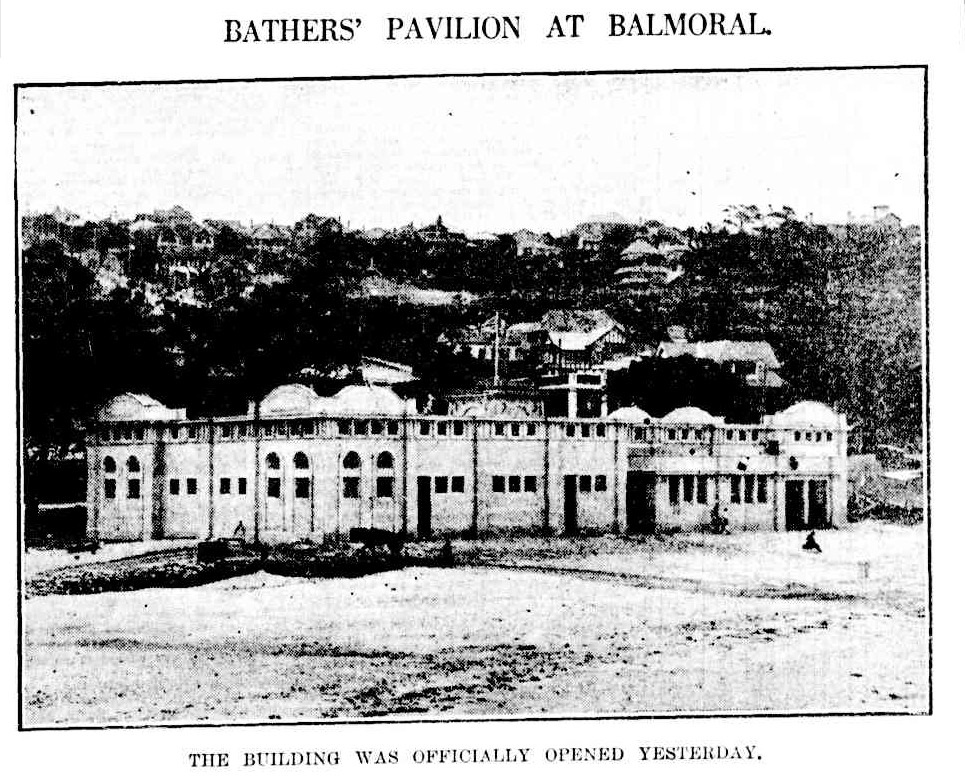
BATHERS' PAVILION AT BALMORAL. THE BUILDING WAS OFFICIALLY OPENED YESTERDAY.

HARBOUR BRIDGE. The first panel of the arch (on the southern side) was completed yesterday.
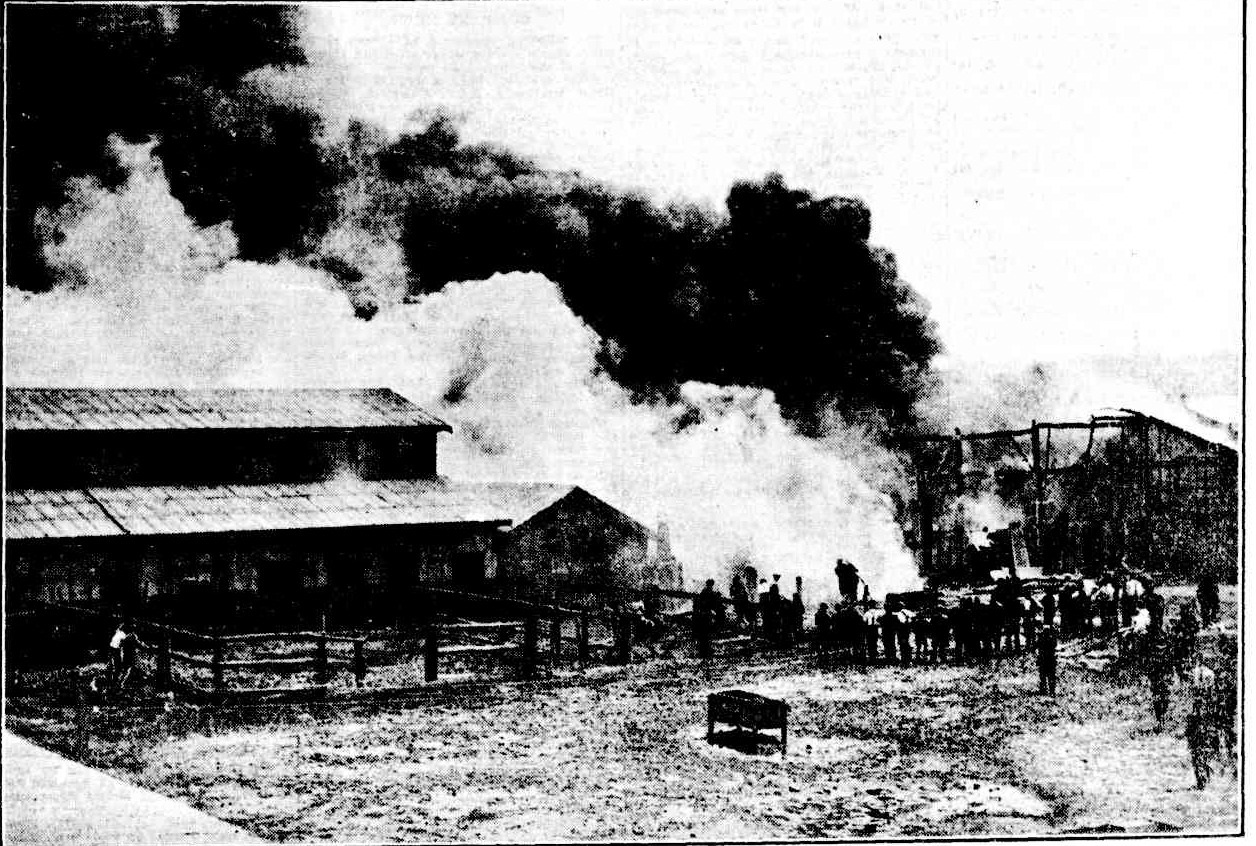
SPECTACULAR FIRE AT ALEXANDRIA CAUSES DAMAGE ESTIMATED AT £40,000. The outbreak occurred in an oil store occupied by .William Adams and Co., Ltd., in Fountain-street. Nearly one hundred firemen fought the flames. SPECTACULAR FIRE AT ALEXANDRIA CAUSES DAMAGE ESTIMATED AT £40,000. (1929, February 21). The Sydney Morning Herald (NSW : 1842 - 1954), p. 14. Retrieved from http://nla.gov.au/nla.news-article16532948
BUSINESS OF WILLIAM ADAMS
Despite difficulty in obtaining adequate supplies of certain lines, sales of the company had been well maintained In all States, said the chairman of William Adams and Co., Ltd. (Mr. A. Barton Adams), at the annual meeting to-day. Several important orders were secured, the benefit of which did not accrue to the company in the period under review. Since a substantial portion of the stock was of Australian manufacture, difficulties of replacement were minimised. While reluctant to say much as to prospects. Mr. Adams informed shareholders that business during the first quarter of the current year had been satisfactory, and It seemed that demand for the majority of the company's lines was more likely to Increase than diminish. The company was not involved in trade of the luxury class. BUSINESS OF WILLIAM ADAMS (1940, August 15). The Sun (Sydney, NSW : 1910 - 1954), p. 28 (LATE FINAL EXTRA). Retrieved from http://nla.gov.au/nla.news-article230917232
Gordon Cemetery - Adams members:
ID Last Name Given Names Date Born Date Died Age Portion Burial Reg. No. Row Plot/Section
61 Adams Alfred Barton 16 Arp 1892 27 Dec 1963 71 Cemetery C KK 1
91 Adams Alice Emily 7 Feb 1906 54 Cemetery 372 JJ 1
107 Adams Alice Windett 14 Dec 1888 22 Oct 1978 89 Cemetery C KK 2
2474 Adams Winifred Beatrice 25 Nov 1965 Cemetery C KK 2
496 Adams Dorothy Mary April 11 1886 15 Oct 1962 Cemetery C JJ 2
516 Adams Dudley 2 Nov 1890 21 Mar 1918 27 Cemetery C JJ 2
2447 Adams William John 12 Jun 1935 82 Cemetery C JJ 3
St John’s Cemetery, Gordon, Lists, retrieved from: http://gutenberg.net.au/stjohns/namelist.html (St John's Cemetery, Gordon)
Scenes of Turramurra, ca. 1900-1927, Sydney & Ashfield : Broadhurst Post Card Publishers. Photographs - 7 postcards, (4 hand col.) - 8.8 x 14 cm. from the collections of the State Library of New South Wales.
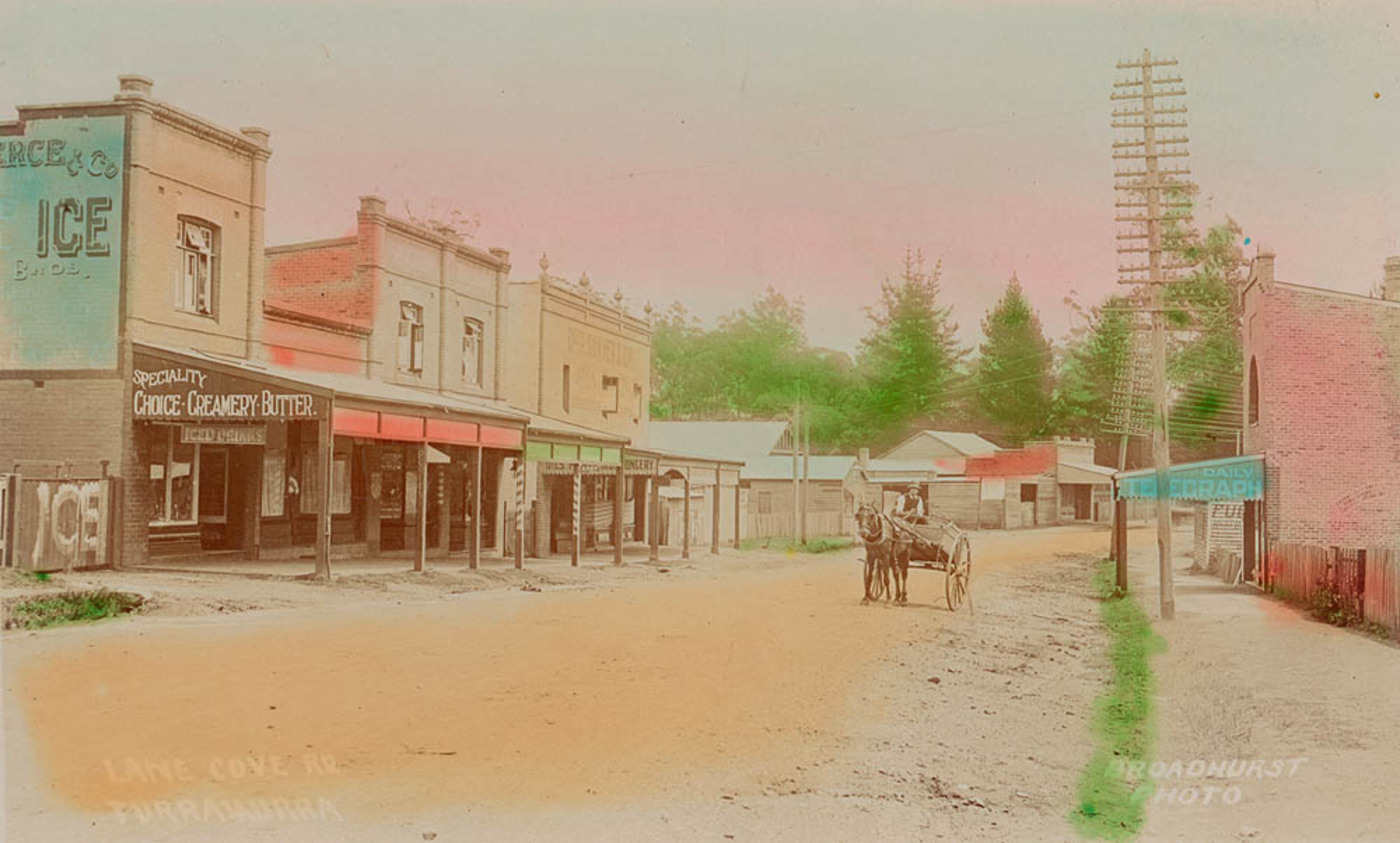
905. Lane Cove Rd., Turramurra
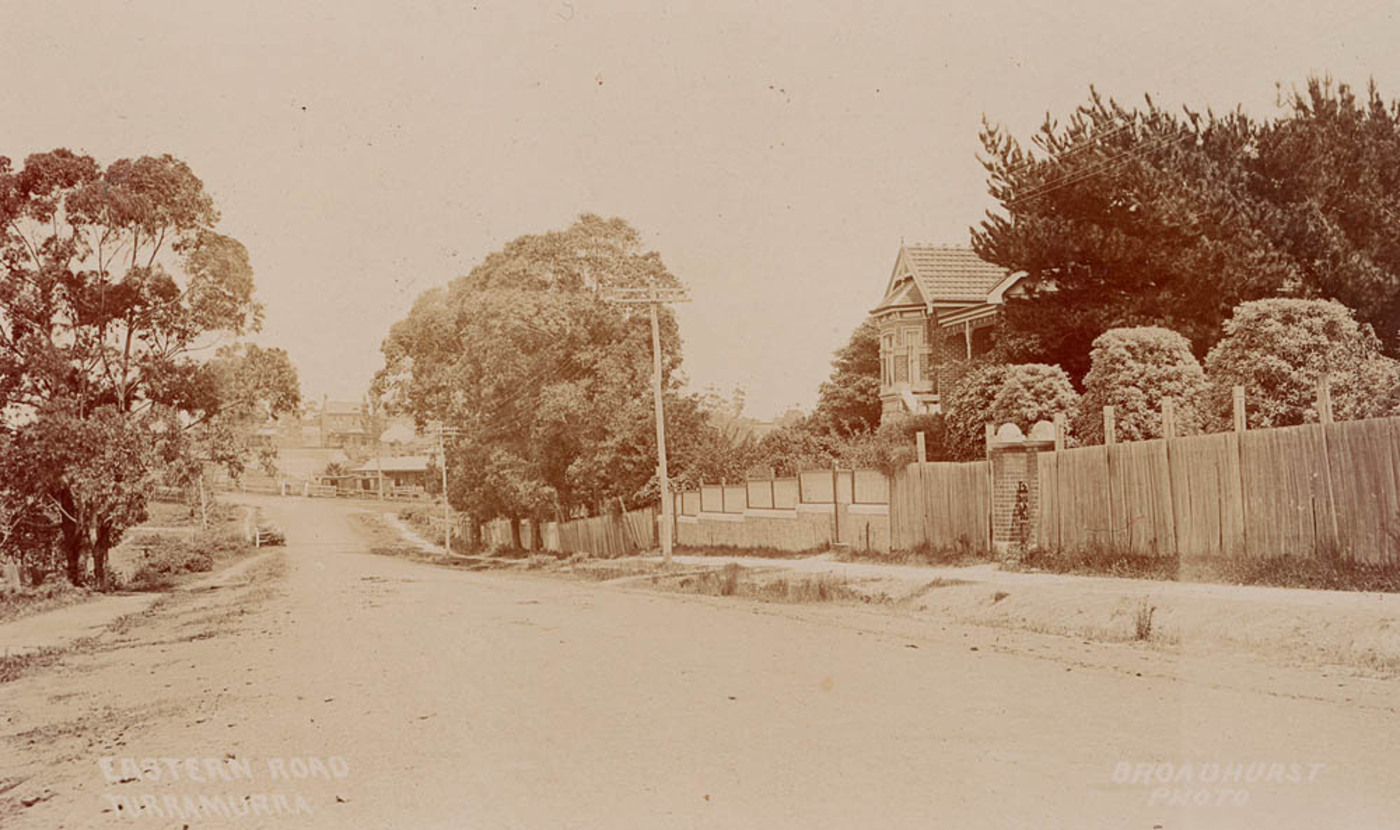
906. Eastern Road, Turramurra
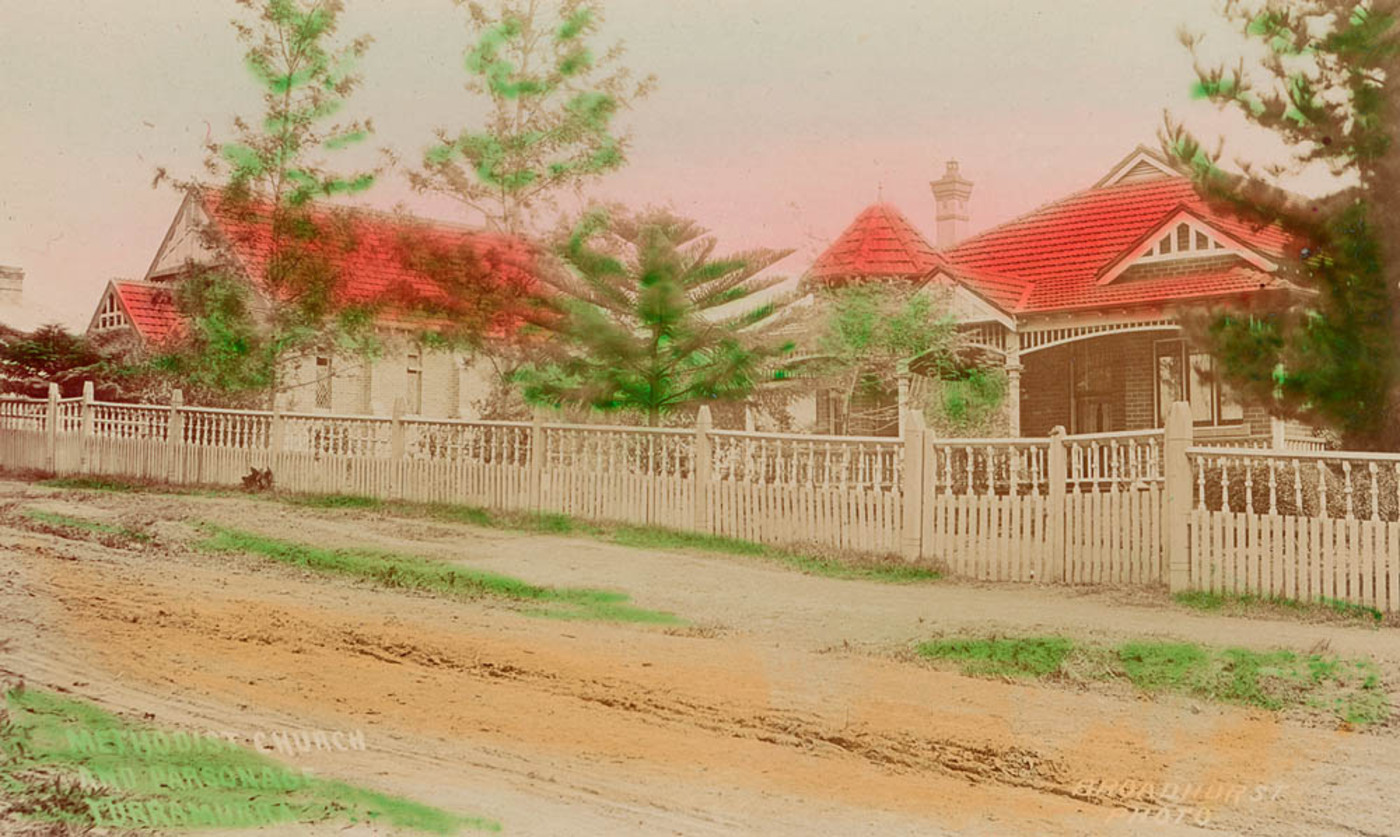
907. Methodist Church and Parsonage, Turramurra
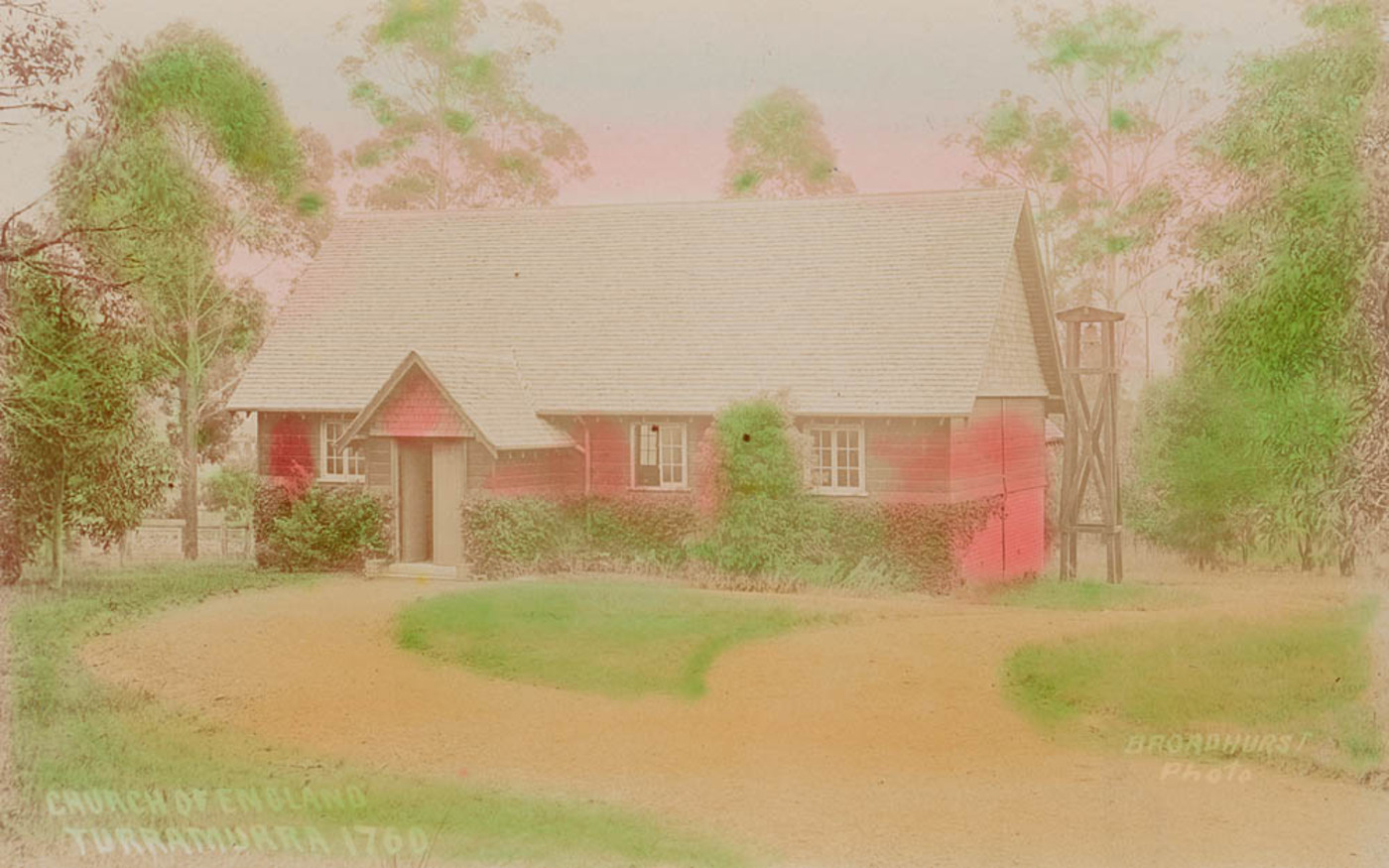
908. Church of England, Turramurra
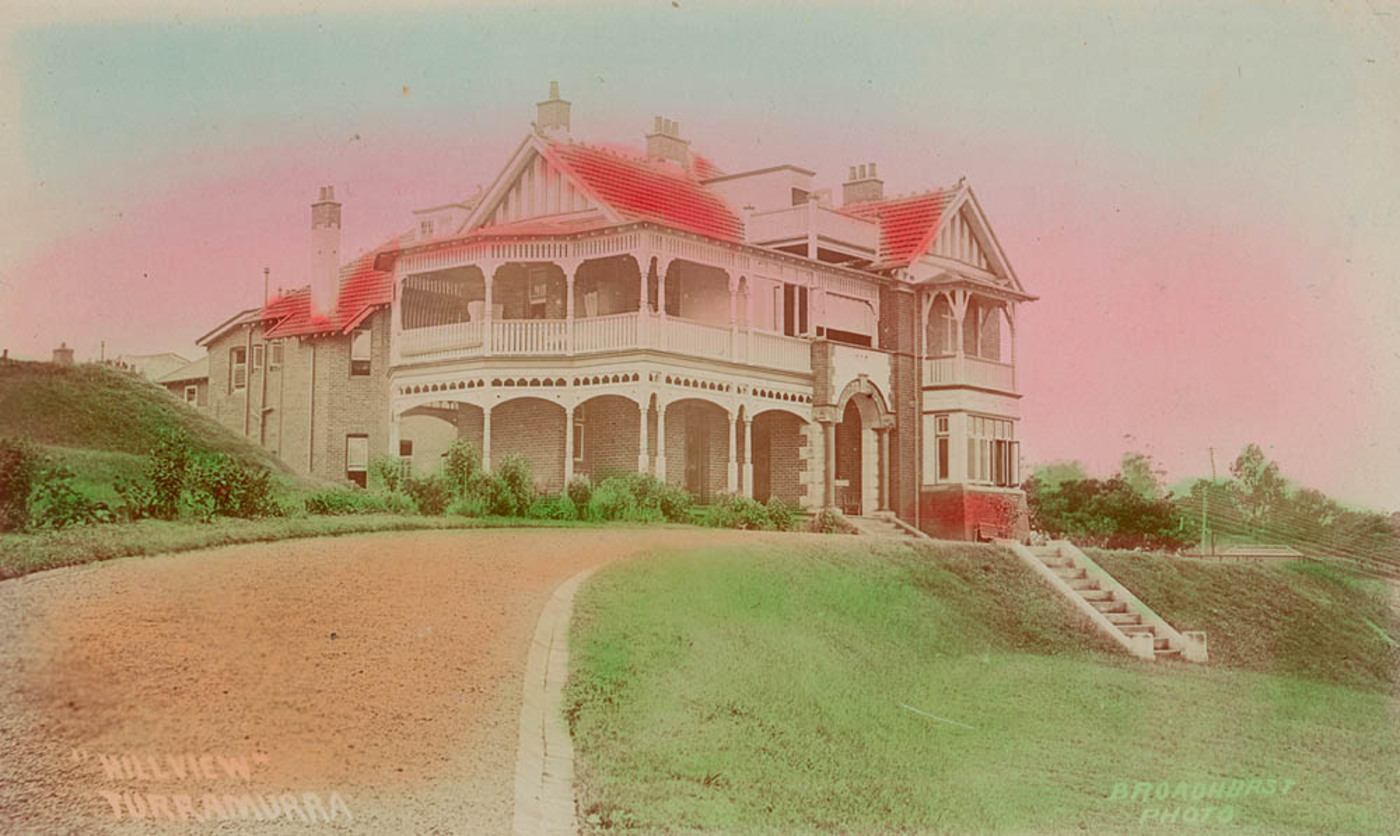
909. "Hillview", Turramurra
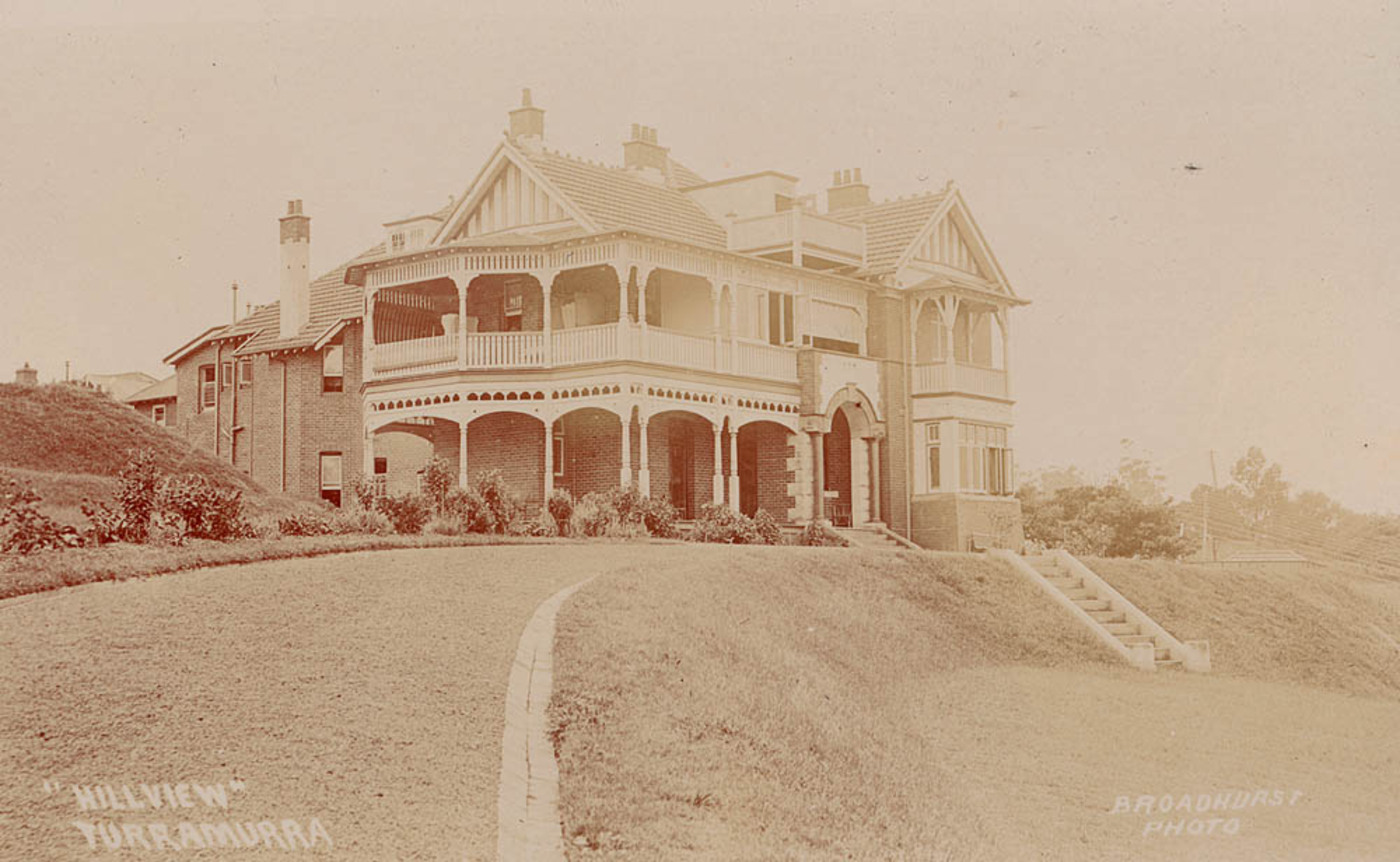
910. "Hillview", Turramurra
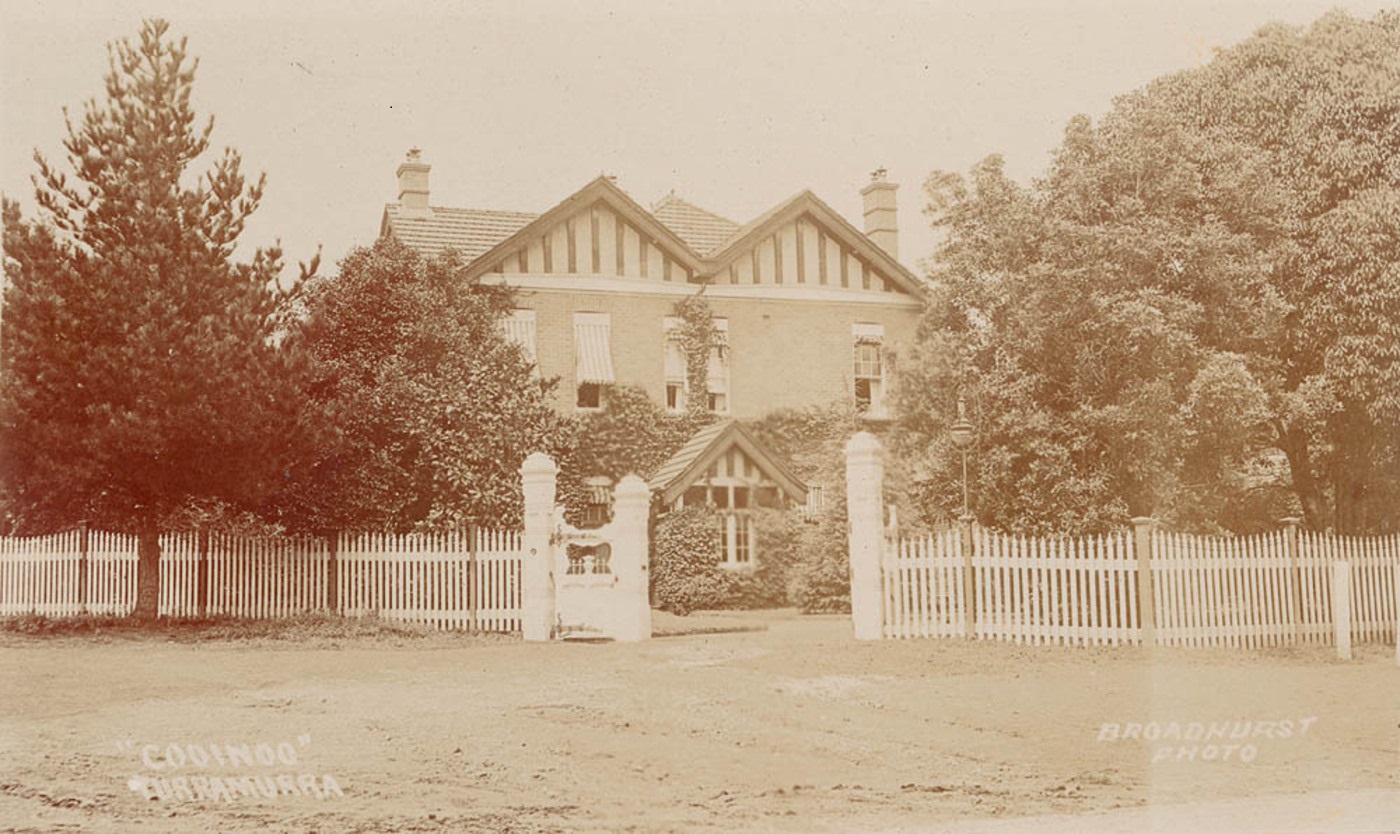
911. "Cooinoo", Turramurra
Federation style home 'Cooinoo, in Kissing Point Road Turramurra, was built for William John Adams. The house was featured as a private residence in Our beautiful homes, N.S.W. originally published ca.1905 but in 1910 became a genteel boarding house. It was described in The Home magazine in December 1931 as "the most notable guest house on the picturesque north shore line" where "for twenty-five years its hospitable doors [had] offered a welcome to those who demand a high standard of comfort in their daily lives". It was demolished for home units in the 1970s.
DEATHS. ADAMS.—February 7, at Rotorua, New Zealand, Alice, the beloved wife of William John Adams, Cooinoo, Turramurra. Family Notices (1906, February 8). The Sydney Morning Herald (NSW : 1842 - 1954), p. 6. Retrieved from http://nla.gov.au/nla.news-article14732060 - Aged 55 – born in 1851
Rotorua, a town set on its namesake lake on New Zealand's North Island, is renowned for its geothermal activity and Maori culture. In Te Puia’s Whakarewarewa Valley, there are bubbling mud pools and the 30m-tall Pohutu Geyser, which erupts many times daily.
ADAMS.— The Funeral of the late Mrs. W. J. ADAMS, of "Cooinoo." Turramurra, will move from St. John's Church of England, Gordon, to Gordon Cemetery, THIS SATURDAY, 17th inst., at 3.30 p.m. Train from Milson's Point at 2.50 pm. WOOD and COMPANY, Family Notices (1906, February 17). The Daily Telegraph (Sydney, NSW : 1883 - 1930), p. 20. Retrieved from http://nla.gov.au/nla.news-article239444195
THE LATE MRS. ADAMS.
The funeral of Mrs. W. J. Adams, of 'Cooinoo,' Turramurra, took place at St. John's Cemetery, Gordon, on Saturday. Among those at; the grave side were Messrs. A. E. Jaques, T. Houghton, Remington, Jas. Moir, J. H. Slater, Professor Warren, W. Thow, Dr. O'Neill, G. Dowse, M'Culloch, J. Corns, G. Rich, Cameron, C. G. Wade, W. J. Newbigin, Vindin, Levick, F. Croft, T. Rolin, D. Kirkcaldie, H. Joseland, Cornwall, W. Slater, E. Warren, Gillespie, C. Willan, R. Hervey, A. Adams, ^C. J. Royle, Nettleton, F. Coffee, J. H. Slater. Hayes, Evans, Cowper,-G. Rodda, and about 150 other gentlemen.
Wreaths were sent from Abbotsleigh School, Wahroonga, Mr. G. and Mrs,,F..G. Sargood, Mr. and Mrs. Frank Coffee, Mr. and Mrs. Walter Parish, Mr. C. G. Wade, Mr. and Mrs. Thos. Read, Melbourne Staff William Adams and Company Limited, Mr. and Mrs. C. J. Royle and family, Mr. Alfred Adams, Mrs. C. Simpson, Mr. and Mrs. Tom Rolin, Mr. and Mrs. Nettleton, Mr. and Mrs. T. F. Clark, Mr, and Mrs. N. M. Thomson, Mrs. Rotheram (New Zealand), Mr. and Mrs. W. M. Cameron, Employees Wm. Adams and Company, Limited, Sydney, Mr. and Mrs. Farmer, Mrs. T. S. Cook, Mr. F. J. Arnold (Brisbane), Mr. Maurice Toohey, Rev. R. and Mrs. King, Mr. and Mrs. Wm. Thow, Mr. and 'Mrs. J.H. Slater, Mr. and Mrs. J. Corns, Dr. W. H., and Miss O'Neill, Mr. Wm. J. Newbigin, Mr. and:-f Mrs. E. j. Sievers, Katie M'Govern and Sister, Mrs. and Miss Mitchell. The funeral service was conducted by the Rev. R. Raymond King, and assisted by the Rev. Hilder. THE LATE MRS. ADAMS. (1906, February 19). Evening News (Sydney, NSW : 1869 - 1931), p. 3. Retrieved from http://nla.gov.au/nla.news-article114225072
Alice Emily Adams and Cooinoo, Turramurra Notes
Servants Wanted.
COMPETENT young GENERAL wanted for Laundry and assist in Kitchen and House, must be well recommended Apply by letter first to Mrs W. J ADAMS, Cooinoo, Turramurra. Advertising (1902, October 29). The Sydney Morning Herald (NSW : 1842 - 1954), p. 12. Retrieved from http://nla.gov.au/nla.news-article14507196
WANTED CHAUFFFUR with thorough expert, to drive large F.I.A.T. CAR. Wages 50s per week. Apply, stating experience, to W J ADAMS. Cooinoo, Turramurra. Advertising (1908, February 26). The Sydney Morning Herald (NSW : 1842 - 1954), p. 12. Retrieved from http://nla.gov.au/nla.news-article14929349
EIGHTEEN-TWENTY-FOÜR H.P. FIAT MOTOR CAR, with TEN-H.P. CADILLAC MOTOR CAR, BOTH IN SPLENDID ORDER. TO BE SOLD BY AUCTION, AT THE HESIDENCE of Mr. W. J. ADAMS, COOINOO, TURRAMURRA, on THURSDAY, Kith DECEMBER, AT 2.30 O'CLOCK AFTERNOON. JAMES E. LAWSON AND LITTLE, AUCTIONEERS. Advertising (1909, December 11). The Sydney Morning Herald (NSW : 1842 - 1954), p. 8. Retrieved from http://nla.gov.au/nla.news-article15094065
Selling house furnishings prior to heading back to London for 1910 2nd marriage - some of this may have been transported to be used at Cooinoo, Bungan Beach, once that was finished:
AUCTIONS. important announcement. INTERESTING TO LADIES AND GENTLEMEN IN SEARCH OF HIGH-CLASS HOME SURROUNDINGS. MUSICIANS, MOTORISTS, AND OTHERS. TURRAMURRA, MILSON'S POINT-HORNSBY LINE HIGHLY ATTRACTIVE SALE BY AUCTION, NEXT Wednesday and Thursday, DECEMBER 15 and 16, 1909, EACH DAY AT11 O'CLOCK A.M.. AT THE MAGNIFICENT RESIDENCE, "COOINOO," CLOSE TO TURRAMURRA RAILWAY STATION. UNDER INSTRUCTIONS FROM W. J. ADAMS, esq., IN CONSEQUENCE OF HIS EARLY DEPARTURE FOR EUROPE. THE WHOLE OF HIS BEAUTIFUL MODERN FURNITURE and EXQUISITE ,I10MK APPOINTMENTS for DININGROOM, DINING-ROOM, BILLIARD-ROOM, EXTRANCE-HALL, LIBRARY. NINE BEDROOMS, COACH-HOUSES, STABLES, MOTOR GARAGE, Etc., Etc. NOTE.— Included in the Catalogue will be found many items of interest and Great Value, which are to be sold without any reserve,. INCLUDING A VERY FINE SUITE OF BACCARAT TABLE GLASS, AN EXQUISITE ROYAL WORCESTER CHINA DINNER SERVICE and AFTERNOON TEA SERVICE. A VALUABLE ASSORTMENT OF ELECTROPLATE, by THE LEADING ENGLISH SILVERSMITHS, a magnificent DINING-ROOM SUITE OF FURNITURE, MANUFACTURED IN SOLID OAK, SPECIALLY IMPORTED FROM ENGLAND, comprising THE VERY IMPOSING SIDEBOARD, TWELVE-FEET EXTENSION- DINING TABLE, OVERMANTEL, DINNER WAGGON, and COMPLETE SUITE OF CHAIRS AND COUCH. Upholstered in Finest Morocco Leather. NOTE. — This Complete and Beautifully Finished Suite of Dining-room Furniture will be sold in one lot or separately as desired. FINEST QUALITY AXMINSTER CARPETS, All in Splendid Order. VALUABLE INDIAN, PERSIAN. AND TURKEY RUGS, SPECIALLY SELECTED IN LONDON. VERY EXCELLENT DRAWING-ROOM APPOINTMENTS, LUXURIOUS CHESTERFIELD SETTEES, EASY CHAIRS, OCCASIONAL CHAIRS in ROSEWOOD, Upholstered in Lyons Silk Damask. EXQUISITE PICTURES AND ORNAMENTS. valuable old empire cabinet, IN VERY BEAUTIFUL CONDITION. OIL AND WATERCOLOR PAINTINGS, by LEADING ENGLISH ARTISTS. superb pianoforte, by O. BECHSTEIN, BERLIN. Full Upright Grand, in Beautiful Rosewood Case. NOTE;— This Magnificent Instrument is practically New, and was specially selected from the Bechstein Galleries by Mr-Adams, regardless of cost, under two years ago. ' _ VALUABLE PIANOFORTE, by JOHN BRINSMEAD AND SONS, UPRIGHT GRAND, IN INLAID OAK, Specially made by these great English makers to Mr. Adams's order, concert grand pianoforte by JOHN BRINSMEAD AND SONS, IN HANDSOME ROSEWOOD CASE. _ -A Very Excellent Instrument, in Fine Order. TWO VERY' HANDSOME specimen china cabinets, Made to Order by Messrs. Walker, Sons, and Bartholomew, in solid Rosewood, with Cathedral Glass Doors. SEVERAL MAGNIFICENT OLD CHIMING CLOCKS. grandfather's hall clock, In Very Massive Carved Rosewood Case, Strikes Hours, Halves, and Quarters, on Beautiful Full-sounding Gong. OLD HAND-CARVED OAK HALL SETTLE, valuable billiard table, by HEIRON AND SMITH A Full-sized Table, manufactured in picked fiddle-back Tasmanian Blackwood. Nearly New, and fitted with all the Latest Improvements, together with GASALIEIR, BALLS. CUES, and a Full Complement of Billiard Requisites. LUXURIOUS EASY CHAIRS AND LOUNGES, Upholstered in Best Morocco. Leather. HIGHLY-FINISHED WRITING TABLE, Manufactured in Solid Walnut, with Maroon Leather Top, Centre and Four Side Drawers. Size, Aft. x 2ft. din. VALUABLE ORGAN, by THE BERLIN ORGAN COMPANY, SOLID OAK ESORITOUIB BOOKCASE. GENUINE OUTLHR ROLL-TOP DESK. singer sewing machine, Latest Improved Model, lilted with Drop Head and Full Cabinet of Drawers. Practically New. LARGE EDISON PHONOGRAPH and SPECIALLY-CONSTRUCTED OAK CABINET for Holding Records. A VERY-BT3AUTIFUL fumed oak bedroom suite, comprising. THE MAGNIFICENT Oft. WARDROBE, THE PART OF VERY HANDSOME CORNER TOILETS, PEDESTAL CUPBOARD, TOWEL RAIL, AND TWO CHAIRS. NOTE.— This Highly-artistic and Well-constructed Bedroom Suite of Furniture was quite recently made to order by Beard, Watson, Ltd. HANDSOME FUMED OAK BEDSTEADS, Fitted with llruss Italian Top, Roll- Edge Wire Mattress, and Best English Curled -Horsehair Mattress, Two Pillows, and Mosquito Curtains, etc, Size, Oft. Oin. X 3ft. Oin. combination walnut shaving stand, Specially arranged, with Shaving Mirror, and Secretly-hidden. MILN'EIt FIRE and BURGLAR PROOF SAFE. quantity of superior blankets and eiderdown quilts. Also, THE COMPLETE APPOINTMENT'S OF FIVE OTHER EXCEPTIONATELY WELL-FURNISHED BEDROOMS (Both Double and Single). PATENT WATER-BALLAST HOLLER. RAXSOME'S LAWN MOWER, and GENERAL GARDEN TOLLS AND REQUISITES. And, at 2.30 o'clock, afternoon, Thursday, December 1c. HORSES, COWS, AND VEHICLES, including FATH FULLY- BUILT PARK PHAETON, Recently Imported from England at a cost of 100 Guineas. VALUABLE SOCIABLE, BUILT TO ORDER 11Y ANGUS AND EON. WELL-CONSTRUCTED SULKY, by H. Hillier, practically New. t HARNESS, SADDLES, Etc., Etc. Also, 18-24 h.p. Fiat motor oar. Seats 8 persons with driver. Condition equal to New Body by Maythurn, of Biggleswade. Specially constructed for Australian roads. Enamelled red, with Morocco Leather Trimmings to match. Dust covers In all seats, also Cape llood. Patent Wind Screen, Siicedometer, Syren, Horn, llushmore IiVad Lights, hionnev Wheel, and numerous Spare Parts. ' p any reasonable trial given. 10-h.p. cardillac motor car. Tn scat 8 person's. Leather Trimmings! Adjustable nood, : Acetyls Head' -Lights, Side Lights, Stepney Wheel, Full Kit of Tools and Spare Parts. CATALOGUER, containing Full Descriptions, may be had Free per Post on application to the Auctioneers, view day, TUESDAY, DECEMBER 11, FROM 11 O'CLOCK A.M. TILL 5 P.M. James r. Lawson, and Little, Fine ART, FURNITURE, and GENERAL AUCTIONEERS, „ _ \ 128 and 130 PITT-STREET, NEAR KING-STREET. TELEPHONE, 2050 Advertising (1909, December 11). The Daily Telegraph (Sydney, NSW : 1883 - 1930), p. 5. Retrieved from http://nla.gov.au/nla.news-article238222284

.jpg?timestamp=1622162587155)

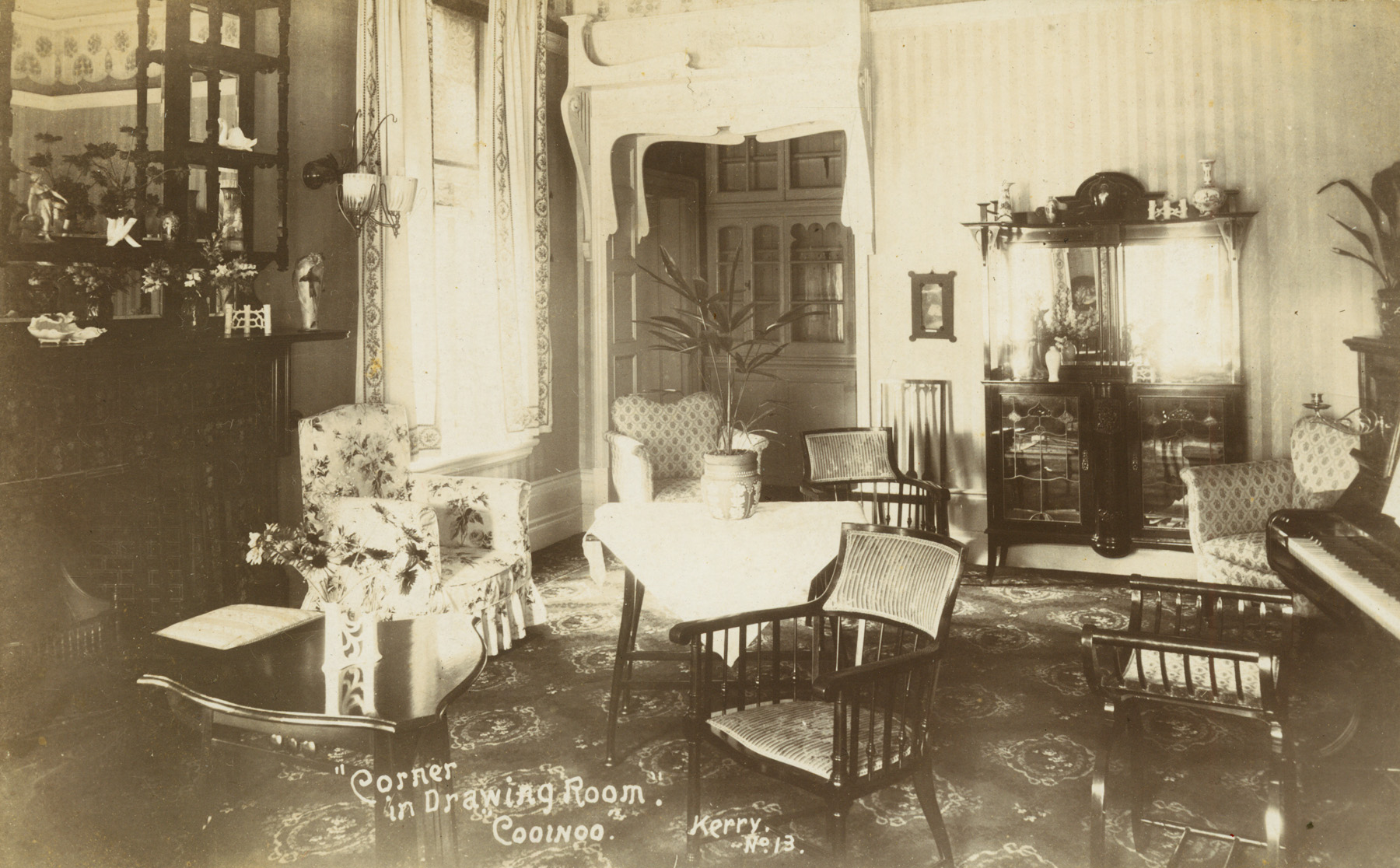
'Corner in Drawing Room, Cooinoo', Kerry image/postcard, ('Cooinoo 8 Turramurra') from Caroline Simpson Library SLM Cooinoo folder.
The house is either then sold or leased to Jean Murray who runs it as a boarding house for 20 years:
NORTH SHORE LINE
TURRAMURRA, NEAR STATION
COOINOO late residence W J Adams, Esq standing in 6 ½ acres of grounds, extensive views, croquet, tennis lawns, motor garage, stabling, billiards, bachelors quarters. The above will be opened early in January to be run in conjunction with HILLVIEW for particulars apply Miss MURRAY Tel 5 Wah. (Wahroonga). Advertising (1910, January 8). The Sydney Morning Herald (NSW : 1842 - 1954), p. 22. Retrieved from http://nla.gov.au/nla.news-article15148084
THE BELGIANS.
helping the sufferers. .
The Belgian Fund will benefit substantially, through the garden fete hold at Miss Jean Murray's residence, "Cooinoo,"-Turramurra, on Saturday. The success was a gratifying reward to the committee for the splendid organisation it has shown. During the afternoon the children had chief attention and thoroughly, enjoyed the programme presented by a number' of Juvenile performers under the direction of Mr. Bertram Flohm, from the studios -Of Miss-Ada Goo , and Mr. Vost, Jenisen--Jack Moran, Barbara Hume, Eveline Douglas, Elizabeth Smith, Vera Cree, Meta Breakwell, and Gypsy Middlehurst. ' Miss Gypsy Middlheurst's representation of "Mary Had a Little Lamb" was very enjoyable. "Suburbanites," ' a comic sketch, was cleverly done. In the evening a programme was given for the adults, the Items being supplied by Mrs. J. R. Wood (Miss Essie Jenyns), Messrs. Graham Moffat, Vost Janssen, Roland Foster, Bertram Flohm, Walter Bentley, and Misses Amy Murphy, . Vera Watt, and Gypsy Middlehurst: The Now South Wales Police Band contributed selections during the day. THE BELGIANS. (1915, March 29). The Daily Telegraph (Sydney, NSW : 1883 - 1930), p. 8. Retrieved from http://nla.gov.au/nla.news-article238829100
BOARDINGHOUSE ROBBED.
Miss Jean Murray, who keeps a boarding-house at Cooinoo, Kissing Point-road, Turramurra, was robbed yesterday afternoon of £28 and jewellery valued at £24. J Sergeant M'Donald and Constable Alexander have been informed by Miss Murray that while she was in the back part of the house the thief or thieves slipped into her bedroom and, forced open a drawer in which she had left the money and jewellery. BOARDINGHOUSE ROBBED. (1915, February 27). The Sun (Sydney, NSW : 1910 - 1954), p. 4 (FINAL SPORTING). Retrieved from http://nla.gov.au/nla.news-article229337394
FAMOUS GUEST HOUSE.
SOLD FOR £30,000.
Cooinoo, Turramurra, a world-famous guest house, was sold yesterday by Richardson and Wrench, Ltd , for £ 30,000 The property has an area of 6 acres 2 roods 113 perches, and comprises a two-story brick building and subsidiary structures, having accommodation for about 60 guests and a large staff. The property has a frontage of 515 feet to Kissing Point-road.
The vendor is the proprietress, Miss Jean Murray, who, starting over 20 years ago, has built up the present very flourishing establishment. The purchaser is Mr. G. U. Thompson, of Sydney. FAMOUS GUEST HOUSE. (1929, November 29). The Sydney Morning Herald (NSW : 1842 - 1954), p. 14. Retrieved from http://nla.gov.au/nla.news-article16606264
Did she own it? Or was this too leased, or sold on terms to be paid off over this time.
Hillview: From health Resort to community health resource and information centre
The first mention of Auprince's property being known as Hillview was in 1902. Sands lists Mrs E. Burton as operating the 'Hill View' health resort. It is not known when the place was used in this way, but its location close to the railway station and its wonderful situation on the top of the hill with panoramic views over the North Shore was ideal for this type of use. The first additions to the original cottage, the eastern and western terracotta-block wings, were probably built at about this time in order to provide accommodation for guests. A detailed physical survey of the building would reveal evidence of the various stages of growth in the building. (A survey of the cottage was beyond the scope of this report). In December 1905, Auprince leased 'house and land including orchard and tennis court' to Jean Murray for a period of two and a half years. The location of the original tennis court is not known. Prior to the expiration of this lease, Auprince sold the property to Edmund Sheffield Willoughby Paul in 1907, in two stages. Paul purchased the southern allotments (Lots 11 to 15) in April and then purchased the northern allotments (Lots 1-3) later in October. In November of 1907, Paul also bought Kit 10 from W.H. Watson.
Miss Murray continued to run the 'Hill View' boarding house until 1913. It has been reported that Miss Murray ran a quality establishment, reputedly serving the 'best table' on the North Shore. The property was self-supporting with vegetable gardens, an orchard, poultry and a cow. These features are clearly visible in a photograph of Hillview taken in 1913. A row of camphor laurels was planted along the western boundary of the site. By 1914, Miss Murray had moved to the 'Cooinoo' guesthouse on the southern corner of Boyd Street and Kissing Point Road, where she was the proprietor.
In 1913, Paul continued to expand the boundaries of Hillview by purchasing Lots 4 and 9 of Boyd's estate. Photographic evidence suggests that Lots 9 and 10 had remained undeveloped prior to Paul's purchase and that Weise's sheds had been removed from Lot 4 by this time. In c1913, Paul also built a large two-storey building behind the original cottage. The new building which was oriented away from the street and towards the view provided all the facilities necessary for a quality guesthouse. These included a library, dining room, drawing room, breakfast room, morning room (parlour) and conservatory. A viewing platform over the front porch afforded spectacular views of Sydney. The building boasted high-quality materials and finishes throughout, including marble columns in the entrance hall, quality joinery, hardware, plasterwork, leadlight, fireplaces, and verandahs with detailed timber balustrades. Retrieved from https://www.environment.nsw.gov.au/heritageapp/ViewHeritageItemDetails.aspx?ID=4309663
The estate was later leased out to Ku Ring Gai Hospital, Hornsby, to be used as the Hillview Community Health Centre. The entire estate is heritage-listed.
Turramurra - Converting "Hillview," Gordon-road Turramurra, into flats. Messrs T. W. Hodgson and Sons, architects, 23 Martin-place. TENDERS. (1924, April 9). The Sydney Morning Herald (NSW : 1842 - 1954), p. 8. Retrieved from http://nla.gov.au/nla.news-article16139814
Hillview guesthouse, part of the heritage-listed Hillview estate, Pacific Highway, Turramurra, Sydney. Photo by Sardaka, 2 February 2015
MARRIAGES.
ADAMS—COWELL.—July 9, 1910, at St. George's Hanover-square, London, William John Adams, late of Turramurra, to Clara Cowell, of Chelmsford, Essex. Family Notices (1910, July 12). The Sydney Morning Herald (NSW : 1842 - 1954), p. 8. Retrieved from http://nla.gov.au/nla.news-article15187882
http://collection.hht.net.au/firsthhtpictures/fullRecordPicture.jsp?recno=32318
John Bateman: Trove Notes
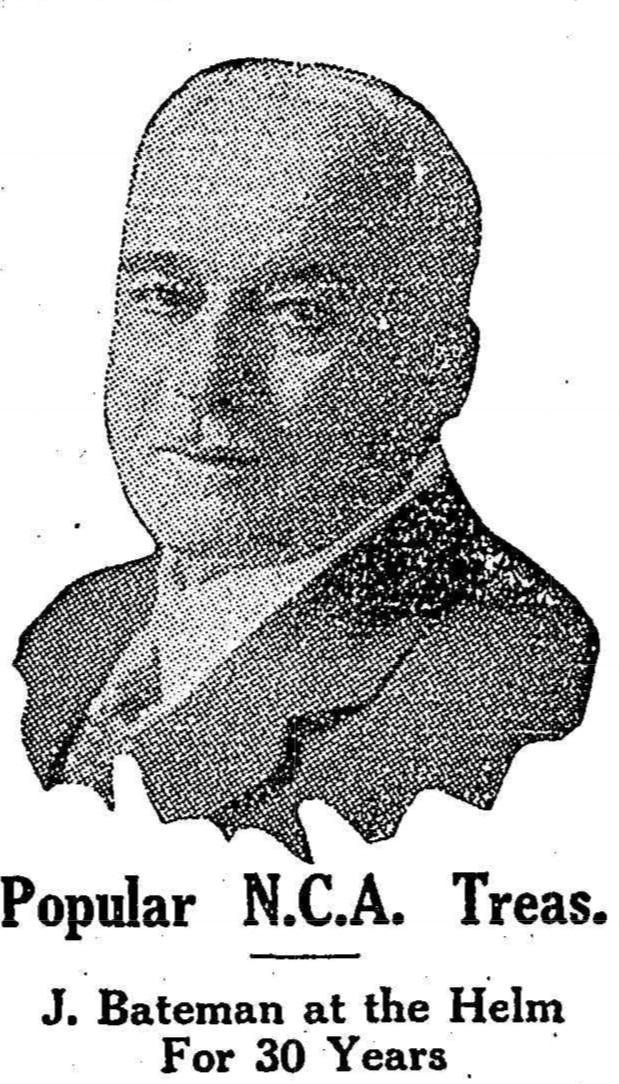 (No. 3) Mr. J. BATEMAN
(No. 3) Mr. J. BATEMAN
Popular N.C.A. Treas. J. Bateman at the Helm For 30 Years
(By 'AMESBURY')
WITH the N.C.A. concluding its season at Rooty Hill this week, it is appropriate that the subject for review should be the association's, popular hon, treasurer, Mr. John Bateman, who has held the financial reins for a lengthy period — between 25 and 30 years.
INCIDENTALLY the first hon. treasurer, was Sir. F. W. Coombes, followed, by the late Mr. Arthur Asher. And then opened up the long reign of John Bateman. Mr. Bateman was born in Gloucestershire, England,64 years ago — his place of residence was very near to that of the Grace family of cricket fame. However, he came to Australia early in life — as a boy of 10 years. A keen follower, of - sport in general, Mr. Bateman has for many years been closely associated with coursing and has owned many greyhounds, chiefly in association with Mr. Greg Keighery— they have been In coursing partnership for years. It was owing to Mr. Bateman that the partners became possessed of Tommy Dodd II., Thrilling Deed* The Dickens* and other imported, dogs from the kennels of tho late Lord Dewar. During visits to England Mr. Bateman became acquainted with Sir Thomas Dewar, as he then was, and the importations were the outcome of friendship with Mr. Bateman and a desire to. improve the breed of greyhounds i,Jri;^.the State. When I recently gave an outline of the coursing career of Mr. Keighery it practically also embraced that of Mr. Bateman, so there is little more to say, so far as greyhound ownership is concerned. By profession Mr. Bateman has for many years been in the hotel and catering line. He is not only the finance minister of the N.C.A. , but his house in Bridge Street, and has been for years, the accepted rendezvous for committee meetings, draws, and such like coursing functions. Naturally he has a very large circle of friends— and to know John Bateman is to like him for his genial and hospitable ways and good sportsmanship. The 'perpetual treasurer' is surely popular. Apart from coursing, Mr. Bateman has been, and still is, interested in other branches of sport especially in sculling. In the boom days he often assisted In finding stake money when it was needed to clinch a match and supporters were more or less hard to find. Men Of the Moment In Coursing Circles (1930, September 17). Referee (Sydney, NSW : 1886 - 1939), p. 19. Retrieved from http://nla.gov.au/nla.news-article131165496
NEW DINING HALL.
Bateman's Crystal Hotel.
The new dining hall and private dining-rooms which have just been opened at Bateman's Crystal Hotel are amongst the most magnificent In Sydney or Australia. In fact, their beauty Is such that they compare favourably with any. of- those, .In, Paris, or, Indeed. in any part of the world. The dining-hall is fitted up In the most up-to-date fashion, and Is situated on- the first floor, overlooking George-street. The .premises are deooiateil In cream, terracotta, and white, and the 'furniture is plain hut Is.of. the best. On any... day 120, persons can 'be sented comfortably, ... the tallies can be moved to allow ... 200 persons sitting down to a meal. The room 'is. hung with .. pictures, tmwhlle' mirrors 'flre.v 'Placed' . aroundv. Experts and connoisseurs describe the room as being the most artistically appointed In the colonies, while the private rooms nre. considered, the most effactlve indentions 'of colouring. The private .rooms are decorated In the- latest fashion, and coloured. .In blue, buttercup, . pink, rose pink, and green, and all the fittings rare blended ; In.. a 'manner as' to make them 'most pJCASlng. ; .The cuisine is under the ' supervision of Albion Lacatou, late of the Mahon Dorqo, .of .Melbourne, and the whole management is entrusted to Mr. Ger. Simons, whose Continental experience Is well known. NEW DINING HALL. (1903, August 8). The Australian Star (Sydney, NSW : 1887 - 1909), p. 11 (FIRST EDITION). Retrieved from http://nla.gov.au/nla.news-article228606138
THE RESCH WAY
John Bateman's Story " SQUEEZING " A LICENSEE
When Edward Resch, Jun., bought Bateman's Hotel over the head of that well-known Sydney sportsman, John Bateman, he made things so uncomfortable for the latter that Bateman was glad to sell his license and get out.
Jammed between Resch and the prospective buyer he paid Resch £650.
The experience of Mr. J, Bateman, for 27 years licensee of Bateman's Hotel, George-street, Sydney, one of the hotels bought by the Resch family, is not unlike that of Mr. Neville of the "Occidental." Slowly, but surely, the Resch family, not satisfied with Its huge brewing Interests, is acquiring one hotel property after another. Early in 1916 the solicitor acting for the estate to which Bateman's Hotel belonged, asked Mr. Bateman whether he could buy the property. "How much Is wanted " asked Bate-man. "Can you find £5000 cash?" replied the other. Bateman could. "Well," said the solicitor, "I think we can get it for £25,000."
A couple of weeks later Bateman read the following Item In the real estate column of the "Sunday Times" : "The principal deal put through since the last report was Bateman's Hotel, the well-known hostelry in George-street, and the meeting-place for many years of rowing men and other sportsmen. The price paid is given at £27,000. It is understood the lessee, Mr. John Bateman, is the purchaser, the vendors being the trustees in the McQuade estate." Mr. Bateman was congratulated on his "deal." He thought he had bought the business he had worked up for 27 years. On Interviewing the solicitor he was astonished to find that the buyer was not himself, but Edmund Resch, Jnr. On September 13, Bateman received a letter signed by E. Resell, Jnr., but all correspondence since was on Resch Ltd.'s official letterheads and signed by Mr. Hopkins company manager.
Piling Up Costs
From then on until he sold his lease this year Bateman was repeatedly asked to pay interest on alterations, and repairs, for which he contended he was not responsible. He was compelled by Resch to pay in the final settlement. Through Resch refusing to enter into an agreement with the Government Savings Bank Commissioners regarding provision of light and air, the residential portion of the hotel was closed for eleven months, during which Bateman paid his usual rent At an expense of £106 Mr. Bateman installed an exhaust for the kitchen. The police took action to oppose the renewal of license unless light and air were provided, and the roof was altered, by Resch. When alterations were made In the building Resch's Ltd. forwarded a monthly account, charging Bateman at the rate of 6 per cent, upon these alterations. Mr. Bateman's attitude was defined by the following letter written on October 11, 1918; "The Manager, "Messrs. Resch's, Ltd., "Dowllnir St.. "Dear Sir. — "I am in receipt of your letter of the 10th inst. The amount (£86 5s 9d) mentioned in your letter was deducted by me from your statement, for the reason that I do not recognise any liability for any such sum. Apparently, this Is a claim for interest at 6 per cent, on a sum of £17-12 8s 2d What this sum represents I am not informed, but if It is the cost of the alterations made by your to the premises, than I certainly deny any liability therefor, or that I have ever made any arrangement whatever to pay for this."
For months Resch's Ltd. rendered an account on the various repairs, which Bateman refused to recognise. But Resch's had a simple way of securing it. Between Anvil and Hammer Worried, by the continual conflict with Resch's Ltd., Mr. Bateman at last decided to sell his lease. It had one year and ten months to run. Through a broker Bateman agreed to sell to M. Lazarus, providing Resch would accept the prospective buyer, as tenant. Bateman was informed that Resch was quite satisfied with Lazarus, and the contract was signed. Next Bateman received the following letter from Resch's solicitor.; "Resch re Hotel. "Referring to your telephone communication with our Mr. yesterday, when you informed him that you had entered into an agreement for the sale of the Hotel lease to Mr. Lazarus, and that you desired to obtain Mr. Resch's consent to the assignment of the lease of the premises, we understand that the following terms will be insisted on before any consent is granted: "The conditions of the lease with regard to painting and repairs muse be fully complied with up to the date of transfer, and the architect has been Instructed to make an inspection and prepare a report showing what must be done in order to have these covenants fully compiled with. Upon receipt of his report we will write you again as to this. "The arrangement made between you and Mr. Resch, under which you were to pay 5 per cent, per annum on the total cost of the recent renovations and additions to the hotel, must be carried out to date of transfer. The total cost of repairs came to £1742, and under this head the amount owing by you as at February 28 was £108 5s. 7d. The incoming 'tenant to agree to pay as additional rent a sum representing 6 per cent, per annum on the above cost of repairs — £1742 8a. 2d. > The incoming tenant to give a covenant to deal exclusively with the brewery. "In view of the fact that Mr. Resch has been put to a very great expense in connection with the negotiations with the Savings Bank Commissioners, as a result of which an agreement has been finally come to which Is of material benefit to the hotel," Mr. Resch will require a payment of, say, 100 guineas by you toward those expenses. "So far we have only discussed the matter with Mr. Resch, without going into every aspect of the case, but wo understand that the above terms will certainly be insisted upon, and be is going Into the matter fully, and may add some further conditions upon which his consent will be granted."
During the previous two years Mr. Bateman had twice renovated the place, yet the extra repairs ordered, plus the 100 guineas legal costs mentioned above, and the 5 per cent, on £1742, which Bateman consistently denied liability of, had to be borne by him before Resch would agree to the transfer. As Lazarus talked of damages for breach of contract if the deal were not completed, Bateman, being between the anvil and the hammer, paid a cheque for £650 to Resch, covering the various claims. THE RESCH WAY (1919, November 22). Smith's Weekly (Sydney, NSW : 1919 - 1950), p. 4. Retrieved from http://nla.gov.au/nla.news-article234253842
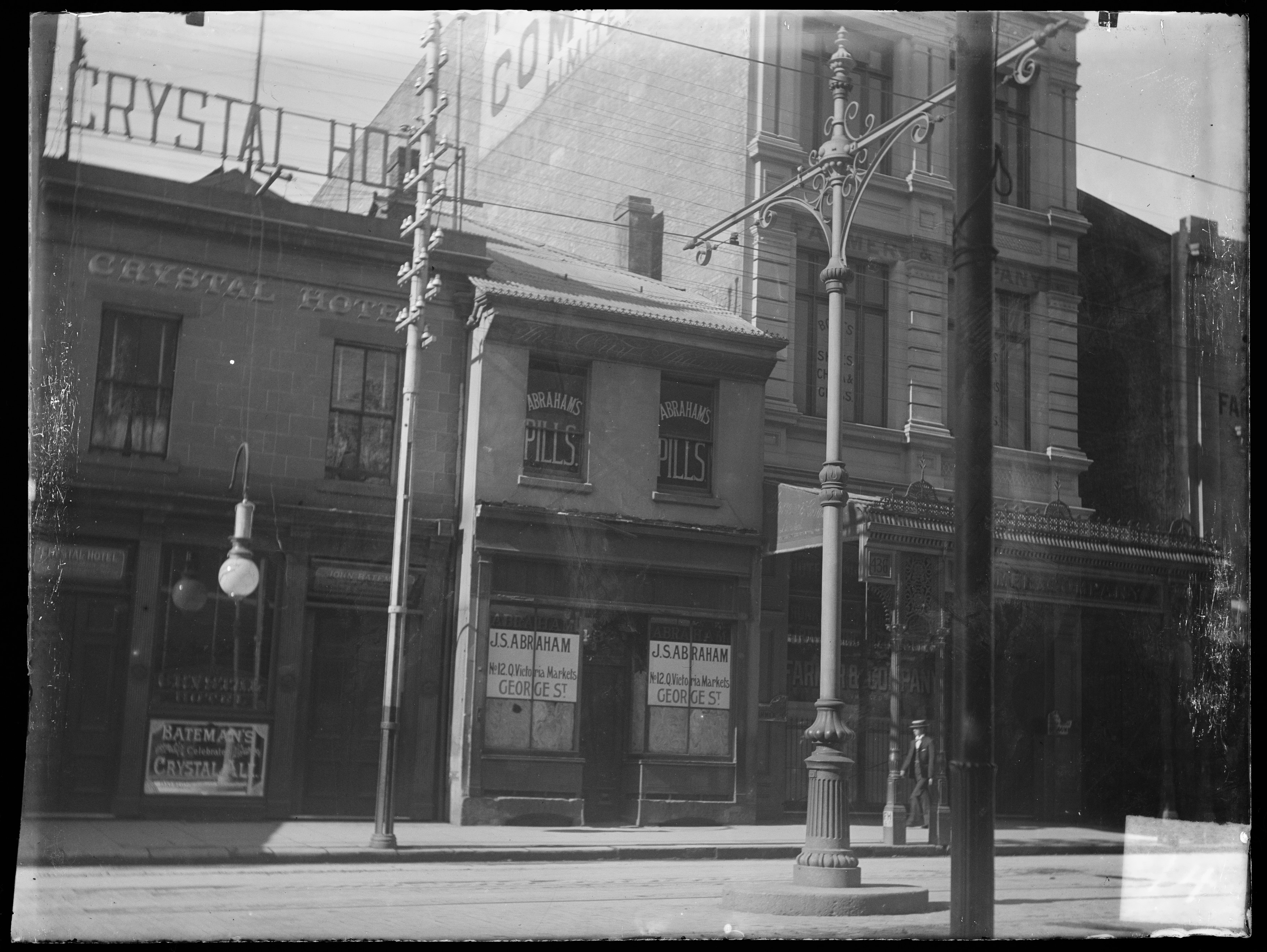
Batemans 'Crystal Hotel', - from front and entrance door. Item c15550_0016_h Courtesy State library of NSW
DEATHS.
BATEMAN.—February 21, 1940, at his residence, Cooinoo, Mona Vale, John Bateman, formerly of George Street, Sydney, dearly loved husband of Sarah Jane Bateman, and loving father of Ivy, Vivien, and Gordon, aged 74 years.
BATEMAN-The Funeral of the late Mr JOHN BATEMAN of Cooinoo Mona Vale, formerly of George Street Sydney will leave our Private Chapels 262 Oxford Street Woollahra, THIS DAY (Thursday) at 2.15 for Waverley Cemetery. WALTER CARTER, Waverly. Family Notices (1940, February 22). The Sydney Morning Herald (NSW : 1842 - 1954), p. 8. Retrieved from http://nla.gov.au/nla.news-article17662261
In the Supreme Court of New South Wales.
PROBATE JURISDICTION.
In the will of John Bateman, formerly of George-street, Sydney, but late of Mona Vale, in the State of New South Wales, hotelkeeper, deceased.
PURSUANT to the Wills, Probate and Administration Act, 1898, the Testator's Family Maintenance and Guardianship of Infants Act, 1916-i934, and the 'Trustee Act, 1925-1938: Notice is hereby given that all creditors, widow, child or children, and other persons having any debts, claims or demands of what kind soever upon or affecting the estate of the abovenamed deceased, who died on or about the 21st day of February, 1940, and probate of whose will was granted by the Supreme Court of New South Wales, in its Probate Jurisdiction, on the 30th day of May, 1940, to Permanent Trustee Company of New South Wales Limited, the executor named in the said will, are hereby required to send in particulars of such debts, claims and demands to the said executor on or before the 17th day of August next at the expiration of which time the said executor will proceed to distribute the assets of the said deceased among the persons entitled thereto, having regard to the debts, claims and demands only of which it shall then have had notice; and the said executor will- not be liable for the assets so distributed to any person of whose debt, claim or demand it shall not have had notice at the time of such distribution.—Dated this 14th day of June, 1940.
For Permanent Trustee Company of New South Wales Limited,
E. V. T. WHITTLE, Manager. Norton, Smith & Co., Proctors. PROBATE JURISDICTION. (1940, June 14). Government Gazette of the State of New South Wales (Sydney, NSW : 1901 - 2001), p. 2591. Retrieved from http://nla.gov.au/nla.news-article225101914 - NRS-13660-18-5471-Series 4_249196 | John Bateman - Date of Death 21/02/1940, Granted on 30/05/1940
______________________________________________________________
The Abo. Language.
"Who Cares" presents his compliments to "Brocklehurst," and desires to thank him for his kind remarks and will be pleased if he will accept the accompanying list of Abo words. They are selected from different dialects, though many belong to the Wirradgery language (Dubbo district). I saw your list in the "Dispatch," and methinks that you might be able to show me the way. After all, the spelling is in a great measure guesswork, the nearest way to correctness being by your method. However, where I vary from you, I have simply adopted the form generally followed:—
Bulla, two.
Bulla Mugo, three.
Bulla Oonby, three.
Bulla Unbi, three.
Balboo, kangaroo rat.
Bulboo, Kangaroo rat.
Bilhu, wombat.
Boorooma, dog.
Bothunba, black duck.
Bulla Didda Didda, plain plover.
Burrimal, house-fly
Burrendeen, peewit.
Bahrhandan, nankeen crane.
Buraandan, nankeen crane.
Buggorobone, blue crane.
Booloon, white crane.
Booroorgan, ibis.
Boodtha, female of the red kangaroo,
Boondthinga, has fallen.
Bobbeen, father.
Buralgon, native companion.
Burrannungarreree, love.
Bellarwi, river oak.
Buthong, opossum cloak.
Beemai, evening.
Bialla, I understand.
Billadurong, platypus (Balladoran).
Barwin, female, or gin of the black kangaroo.
Bidgin, yellow bellied perch.
Boorinubba or nabba, I think perhaps it means baby boy; boori, boy, and nubba, baby.
Burriuna. In view of the preceding meaning, I don't quite see how "baby crying" comes in. However, my Abo knowledge is only a limited one.
Bookookoorara, long waterhole.
Bobbeengarang, father-in-law.
Bartheen, sister.
Birrain, boy.
Birrbunga, Birrubungar, black shag with white chest,
Bungari, black duck.
Beendora, black duck,
Bel Bel Bundalooie, bell bird.
Curebung, Coorabin, curlew.
Cultowa, shingle backed lizard.
Cullen Dullin, black snake,
Cullen Joolin, black snake with red belly.
Carinya, happy home,
Bundar, kangaroo; general word the Kamilaroi tribe, northern portion of the State, Moree way, use it; ganoor with them means the red kangaroo.
Bundemar, stick, or boondi, with a knob on the end.
Boondi, stick, waddy.
Bidgeeree, to dream.
Billabong, really dry creek; bong, dead, and billa, creek,
Burrabadine.—I presume it is the same as Burrabadeen, a place near Dubbo. The derivation, according to my reading, will not result in "boggy plain." Perhaps your Abo informant might be able to explain. From burri, quick, and duinong or deena, foot, quick foot. Some time since there was a famous racehorse of the name "Burrabadeen."
Baragine, leech,
Coboco, egg; . also kabooga, kabuga and many other styles,
Biddhan, pronounced bidthan, yellow bellied perch.
Beenbi, diver, black one.
Didda Didda, spur wing plover.
Dhundhu, swan.
Duneba, all kinds of wattle trees.
D'hooleen, iguana, striped one.
Dooni, match. (Do not know the word).
Dombok, sheep;
Junbong, a sheep.
Dungur, cat or jew fish (fresh water).
Derri Derri, willy wagtail.
Dirri Dyrri, (pronounced dirry jirry), willy wagtail (dy before i has sound of j).
Dhinka Dhinka, will wagtail (dh is sounded like dtb).
Doondoo, swan.
Doorong, snake.
Dharawaiyn (Tharra-wy-yar pronunciation), teal duck.
Dtharawoyong, teaV duck,
Dunnuin death adder.
Daddawang (do not know it much like mine); Tallawang, apple tree.
Durian, news.
Dthargeewaindoo Dthargoon (dthar-goon), where you walk about?
Eereibin, swallow.
Illabunda, swallows.
Eeray, Eura, or Eerei, sun.
Eoroibang, summer.
Enaagong, girl.
Enigon, I don not know.
Enar Inar, woman.
Erawina, east (West Australian word).
Euminbung, good luck.
Eurokn, pun, (cur, sun, and oka, spirit), i.e., spirit in the sun.
Echuen, meeting of the waters.
Earambo, little smoke (Barringun-way).
Eurolie, gum tree blossom.
Euroon, rain.
Enolla, where cattle feed (Stone-henge Q.).
Eundigine, good spring (water) (Northam, West Australian word).
Enchoochoo, to sneeze (sounds sneezy).
Gunnah, red kangaroo (do no know the word).
Ganoor, might he the word which means the red kangaroo. It is used by the Kamilaroi blacks a good deal.
Gollin, rain.
Golleine, rain, coming.
Girriwa, or Girrawah, black inguana.
Goonarong, Gannaih, Gennann, wood duck; Geeweela, also Goonahi, a Victorian word for wood duck.
Girillah, stars.
Girralong, star.
Gibrigil (gibir, man; gil, clear), and hence white man.
Gibrigang, boy.
Goondi, Gundi, hut.
Gumbul, turkey (plain).
Gumbul Gubbin, plain turkey (gobble gobble).
Gumbul logie, turkey come to drink.
Goorawinbundinga, gooravin flowers, and bundinga, fallen, or really felled.
Girrahween, place of flowers.
Geewong, moon.
Cobadong, moon.
Geewongawong, madman; too much of the moon.
Goorebun, curlew.
Gooyabi, or kooyabi, fish.
Goodong, codfish. .
Gooburri, bream.
Goobeer, bream.
Ginduggi, laughing.
Gidga, shrimp; do not know it.
Gurrawoo, magpie; do not know.
Garoo, magpie.
Gelenyia, spring time, go hard.
Glenora, eagle.
Gundiwon, shade.
Geitbandthoo, I am ashamed,
Gnoorim, emu.
Gidga, shrimp (I don't know the word but it is near enough to Kid-jar," the Lachlan black's word for shrimp.)
Gaambon, brow-band.
Gaambagaalang, bullocks, i.e., crowned beings.
Goddtha, pleasant to taste.
Goddtlia werai, unpleasant to taste.
Godthaang pleasure.
Giwanbang, moonlight.
Yubunnai, guabianna, to rain all night.
Gungil, dow.
Gunguari, halo round the moon.
Googeen, short or stumpy.
Gangalook, echo.
Gowong, moon.
Gin Gin, kind of gum tree. The g is hard and is always so, or practically always.
Iooree, flock,
Jooreeween, happy family (birds).
Jeeraama, exalted.
Jeeramalang, lawgiver, spokesman, leader.
Iraidurai, morning star.
Irimbanna, to peep through a hole.
Iremillan, cockrow.
Ibing, little owl,
Indiama, smooth.
Kawila, curlow.
Karweelar, sound.
Keelbubbin, sound of rippling water.
Koquil, hush,
Kyeowa, dawn.
Kyogle, native companion (Limore way).
Karrlollna, along the bank.
Kirriwong, magpie,
Kabinga, to begin (Griffith's place,
Brummagim Creek, Dubbo district).
Merri, also Mirri, dog.
Mirri Yabba, dog barking.
Murrun, cockatoo don't know the word).
Murram, white cockatoo.
Marranbone, Lower Macquarie, means plenty white cockatoos.
Minore, also white flower, a meaning that seems strange.. Further, it is said to be a corruption of minye, what.
The meaning white ochre seems most likely. As you know ochre was used for adorning their bodies, or rather for painting their bodies at ceremonials and I presume it was obtainable about Minore.
Murrembung, very good; I've never heard that it meant good-day.
Murrung, river, is a word of the Lachlan blacks, and is seldom met with.
Mushawandry, where good blacks go when they "snuff."
Marra, hand,
Marrabunga, to stretch out the hands.
Marramarrang, haste, hurry.
Mil, eye.
Milgain, facc to face.
Milwarrana, to open the eyes (warrana, standing).
Meryagon, relations.
Meryagandthee, my relations,
Meeygangoodthee, his relations.
Moddthee, blind. .
Moddthoobool mogglen, all are blind.
Moorroo, track.
Moorroo Mooroo, dimple.
Moorregol; stranger, one who has made tracks, traveller.
Nandthoo, close, near.
Nandthoogir, meet me again.
Ngandtheewaindthee, who are you. (ng has the sound of ng in sing, put in front-and sound the word through the noze. Sort of grunt. Something like ung),
Nguadtheewaabobbeeragoojee, whose that singing.
Nooreen, emu.
Nardeenaieentha, my own (ai like eye).
Nirribingagable, swallow's nest.
Naraman, long way behind.
Owrimbah, bora or ceremonial
ground.
Ogie mil, squint eye.
Obundalong, bronze wing pigeon
Quidong, place of echo.
Quambi, camp.
Quahly, wait for me.
Thurlon, camp.
Tibooburra, heaps of granite rocks.
Towamba, place of great lightning.
Timbrebongie, broken knee (dinbi) knee, bungan, broken.) Bungan, broken.
Tuleendeenah, home on top of a hill (New England way).
Theaminda mein, where are the blacks ?
Tarrawonga, mating ground of Wongo Wonga, pigeon.
Temora, Tamori, pigeon ground.
Tooloomi, thunder (Kamilaroi word)
Thepaiyn, whistling duck.
Uralba, selection (land).
Uda, ear.
Urara, where sheep feed.
Ulandi, tree or log burning; camp, pronounced Youlandie.
Weejay, food (ueigar is the one I've seen oftenest.
Weigar Warai, no tucker.
Wahgun, Wargon, Warcolm, Wogalong, Warroo, crow.
Wargambegal, crow come along, crow corroboree.
Wagingoberemy, crow hit with a stick.
Wombom, kangaroo, grey one (mostly spelt womboin).
Wambangalang, place of grey kangaroo.
Wambanda, red kangaroo.
Womboinbula, two kangaroos.
Worn, Wiin, Wee, Ween, fire.
Woranda, make haste.
Weedthoen, absent.
Watara, black cockatoo.
Wirribo, never.
Wathinbah, laughing.
Wambagirri, up the river.
Warramba, turtle.
Wandially, porcupine.
Woomoo, Wommo, fat.
Windee Windee, stir it up (West Australian word).
Warrien, scrub wallaby.
Wayalongali (Wayalongarlee), good look out.
Wibbi, Wind.
Wonggaadthoona, I forgive.
Weroona, rest.
Weedtheen, absent.
Withoreen, tired.
Warlomonee kallarnee, do you see
that one (woman).
Windthala wadthn, where am I.
Willai Yarra, to use bad language.
Wooroomoothoo, long time ago.
Willi, opossum; gindine, ringtail one.
Yerriai, apple bush.
Yindibai, wallaroo.
Yandembah, home of ghosts.
Yarrabee, plenty gum trees.
Yoondrathana, across country.
Yooroogo, my home.
Yanagirry, go away, clear out.
Yarramalong, wild horse place.
Yallan, to count.
Yambler, liar.
Yaaloon, the past, old times.
Yabba, to speak.
Yooralla, love.
Yoongi and Yoongai, scrub turkey.
Yoolooman, black wallaby.
Yanbolala, I'm going now,
Yandowongala, come back.
Yanatherra, good-bye.
"WHO CARES."
Sounds: a as in father, e as in let, i as in fin, o as in rod, oo as in good, ei as in their, ai as in Shanghai. The Abo. Language. (1922, January 20). Western Age (Dubbo, NSW : 1914 - 1932), p. 3. Retrieved from http://nla.gov.au/nla.news-article137158865
.jpg?timestamp=1622163130655)
.jpg?timestamp=1622163165026)